


































Kaiser Enterprise in Troy, a $1.5-billion business with nine di erent companies owned by CEO Bob Kaiser, has diversified beyond its traditional paint shop work to o er air-handling systems for data centers and EV battery production facilities.


















PENINSULA CAPITAL PARTNERS L.L.C. is a metro Detroit-based firm that has fought hard to make a name for itself in the global private equity industry. Since its founding in Detroit in 1995, Peninsula has raised eight investment partnerships exceeding $2.0 billion, each providing customized capital solutions to middle-market businesses seeking funding to complete acquisitions, support growth, buyback stock or address other special situations requiring junior capital. We pioneered the development of a new, more flexible investment approach in the private equity industry, and are recognized as a leader in our market, earning us the patronage of major institutional investors both in the United States and Europe. Our unique investment approach combines elements of buyout, private debt and growth capital funds, allowing us the rare flexibility to craft tailored capital solutions for businesses, including both debt and equity, and either as a controlling or non-controlling investor. Since 1995, we have closed nearly 150 platform investments, about half of which have been in partnership with independent sponsor groups. Please keep us in mind the next time you require a junior capital provider; we bring the hard-working spirit of Detroit to all our transactions.













With unique lounges, a resort-style spa, signature restaurants, a luxury 400 room hotel and 30,000 square feet of flexible event space, we make the attendee experience GRAND.









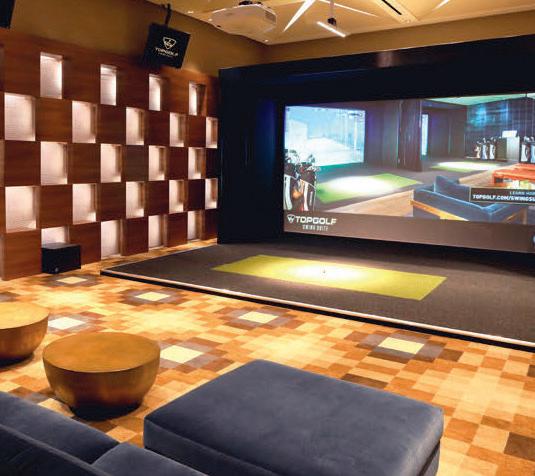


mgmgranddetroit.com











Tomorrow is on.
The Great Lakes are a vital source of water, life and play for all of Michigan. That’s why we’re committed to their safety and environmental protection. With the Great Lakes Tunnel Project we're taking extra precautions in the Straits, making a safe pipeline even safer. Placing Line 5 within the Great Lakes Tunnel will eliminate any risk of an anchor strike.


While the tunnel is being built, we’ve added additional safety measures—including hi-def cameras and a marine monitoring/alert system—at our 24/7 Maritimes Operation Center. Safety in the Straits is our top priority. We’re committed to keeping the Great Lakes safe for generations to come.
Learn more at enbridge.com/line5tunnel.





No matter
We offer commercial payments and investment banking as well as employer from our industry experts.
Take advantage of our local team: David Mannarino
KeyBank Market President 4000 Town Center, Suite 1260 • South eld, MI 48075 Phone: 248-204-6550
David_Mannarino@keybank.com
key.com/commercial






































































21 LACK OF LEADERSHIP
As quickly as Gov. Gretchen Whitmer called for forming a bipartisan coalition to study and provide recommendations to reverse Michigan’s decades-long population decline, the resulting report, released in December 2023, looks to have been placed on the proverbial shelf.
22 LEFT BEHIND
Michigan has two elephants in the room that no one seems to address when it comes to providing a world-class education for K-12 students: teacher unions and public schools.
22 MAXIMIZE RESOURCES
To meet the Grow Michigan Together Council’s recommendation to establish the state as the innovation hub of the Midwest, public and private leaders should work more closely together to attract and retain talent.
24 COMPENDIUM
How outsiders view Detroit. 16
27 FIRST PITCH
Beauty supply manufacturer Larry Gaynor has launched a book that coincides with a $251,000 startup pitch competition. By R.J. King
28 GROUND FLOOR
Comer & Cross Concrete Floor Coatings in Troy plans to expand throughout the Midwest. By R.J. King
28 TOP DEAL
Detroit-based middle-market private equity firm Huron Capital has launched its latest ExecFactor initiative, Rampart Exterior Services. By Jim Stickford
30 SALES AWAY
A craft builder in New Baltimore designed the SOL sailboat for people of all ages. By Seth Schwartz
30 PDA Q&A
Marco Stefanini, founder and global CEO, Stefanini Group, Brazil/Southfield. By R.J. King
32 FELINE FLOW
Whisker, in Auburn Hills, has automated cat litter boxes for the masses. By R.J. King

32 FINE WINES
Fourteen Traverse City-area wineries captured 66 medals at the recent Texas Sommelier Conference International Wine Competition, an invitation-only awards program that took place in Irving, Texas. By Jim Stickford
79 NORTHERN BITES
Our inaugural list of dining and iconic restaurants in northern Michigan includes close to 60 listings — from Bay Harbor to Traverse City and Harbor Springs to Petoskey. Research by Valentina Tersigni
84 RETURN ON INVESTMENT
Watts of Energy: A longtime engineer at General Motors Co. in Detroit, Tony Posawatz, today is leading Fermata Energy, which offers a platform that both charges and discharges EV batteries. By Tom Murray
87 PRODUCTION RUN
Rising Stars: A multifaceted culinary and educational foundation in Center Line trains at-risk young adults to be self-sustaining in the business world. By R.J. King
90 PATENTS AND INVENTIONS
Rocket Man: Detroit native John T. Parsons developed computer numerical control, or CNC, which allowed for the precise operation of tools, as well as the tube extrusion process that produced the massive fuel booster rockets for NASA’s Apollo space program. By Norm Sinclair
92 OPINION
Collaborative AI: To improve the use of artificial intelligence in business, users should work in partnership with dedicated engineers to maximize outcomes and results.
By Dylan VanWormer
94 THE CIRCUIT
Our party pics from exclusive events.
99 FROM THE TOP
Top Hotels Outside Metro Detroit, Largest Contractors in Metro Detroit, Largest Business Insurance Agencies in Metro Detroit, Largest Accident and Health Insurance Companies in Michigan, Largest Law Firms in Metro Detroit, Chambers of Commerce in Metro Detroit.
106 CLOSING BELL
Say Cheese: In 1930, Dairy Fresh Foods started in a garage in Detroit. Today, it lives on as part of Lipari Foods in Warren. By Ronald Ahrens
ON THE COVER
Photo by Josh Scott

































Aimmediately become pro ts or be used to make other investments.”
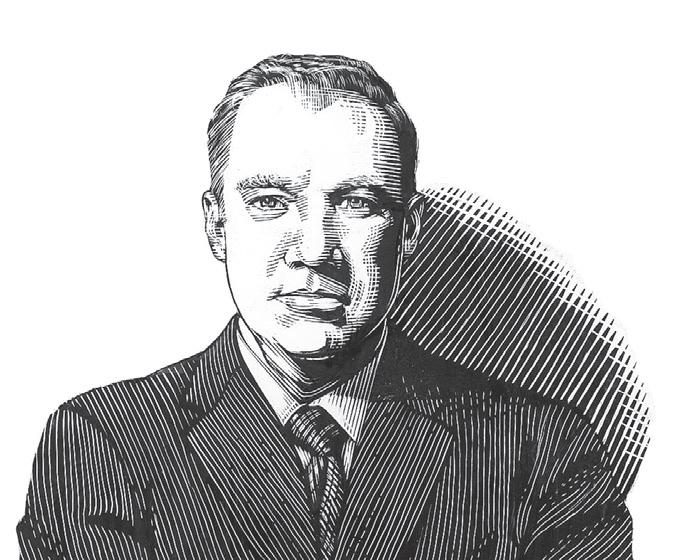
harbinger, Peter Karmanos Jr. led the way in developing IT systems for businesses, hospitals, and other large organizations long before personal computers were available.
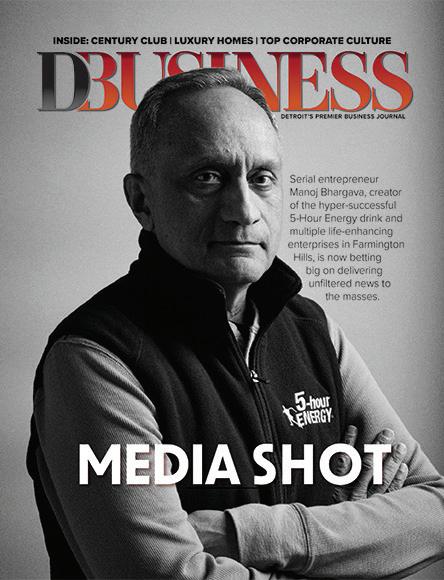
Working with a team of 35 specialists led by CEO Chris Hallendy and Daniel Mather, who oversees energy engineering and integration services, Resolute works with McLaren Health Care, REDICO, Domino’s Farms O ce Park, Detroit Pistons Performance Center, Chicago Public Schools, and more to drive millions of dollars in savings.
MEDIA SHOT
For example, Resolute assisted McLaren in tracking its energy use and recommending solutions like a new cooling tower system and piping. “With the latest equipment, cooling towers reduce energy costs and usage, and those are savings generated on a daily basis,” Hallendy says.
In 1973, Karmanos and two partners launched Compuware Corp., a software company at the forefront of the emerging mainframe computer sector. Today, those same mainframe systems are used as servers.


Over time, the Detroit enterprise saved its clients billions of dollars by automating and updating bulk data processing for an array of applications including statistical analysis and transactional procedures. It also transitioned clients through Y2K as the world, and computers, greeted the 21st century.
Following a 40-year career leading Compuware, in 2014 the lifelong entrepreneur, along with six partners, launched Mad Dog Technology in downtown Birmingham.
With a portfolio that includes digital banking and professional services, the venture capital rm may have a unicorn on its hands with Resolute Building Intelligence, an early player in providing energy solutions at a time when electrical demand and costs are rising precipitously.
Last year, Resolute, which got its start in 2016 o ering now-patented building performance software to help companies lower their overall energy costs, doubled its revenue. Like Compuware in the 1970s, Resolute is at the leading edge of tracking and managing data, in this case energy and related equipment, to generate sizeable operational e ciencies.
“Large businesses, hospitals, and universities often have di erent energy systems and equipment, and by tracking and synergizing that speci c data, we can generate savings of 30 percent or more right o the bat,” Karmanos says. “ ose savings can
Given good timing portends opportunity, consider how Resolute is on the ground oor of three distinct demand trends. AI, which the company utilizes, requires accelerated computing power delivered by the latest semiconductors — which more and more, are being produced domestically.
e creation of cryptocurrencies, which some companies and individuals use to hedge against government overspending — the U.S. de cit will soon reach $35 trillion — also requires an immense amount of electricity.
And there’s the now slowing, yet EPA-mandated, production of electric vehicles and batteries being pushed into the marketplace as a centerpiece of a green energy future that has turned out to be pure fantasy. A steady stream of regulations that started with the In ation Reduction Act (aka the In ation Expansion Act), will require electrical utility upgrades that could reach as high as $1 trillion by 2032.
In addition, to ensure all the new electricity reaches end users requires the replacement of millions of distribution transformers, a time-consuming and expensive proposition that ideally would see more production moved here from China.
“Resolute is our largest platform at Mad Dog, and you need speci c data to make the right energy decisions,” Karmanos says. “Finding and managing that data is our secret sauce.”
R.J. King rjking@dbusiness.com
I wanted to send you a quick note and let you know everyone in the o ce loves the March-April DBusiness feature of Manoj Bhargava. Manoj and the whole team are extremely pleased, and we had a great time working with everyone on your crew.
Dana Eble Farmington Hills
WINTER WONDERLAND
Thanks for taking the time to chat with me yesterday about the Winter Wonderland article in the January-February 2024 issue of DBusiness magazine. The article mentioned my property, Pine Ridge Square, which was hit by the tornado last May. It’s a great article about the Gaylord area, and I would love to get a copy to use in my marketing package.
Michelle Shafir Birmingham
MONDAY KUDOS
I have to tell you what a great job you are doing with DBusiness. This last issue was the icing on your incredible journalism. What a treat! Thank you for being so great at what you do. Kudos on a Monday morning are most welcome, right?
Sandra M. Hermano Bingham Farms
EMAIL US AT: editorial@dbusiness.com

Business leaders say they trust the attorneys of Plunkett Cooney to anticipate legal pitfalls, to resolve high-stakes litigation and to craft contracts they can sign... with confidence. See your business differently. Get the Plunkett Cooney perspective. n Appellate Law n Banking, Bankruptcy & Creditors’ Rights n Business Transactions n Cannabis Law n Commercial Litigation n Estate Planning & Business Succession n Foodservice & Hospitality Law n Government Relations & Public Policy n Health Care Law n Labor & Employment Law n Mergers & Acquisitions n Nonprofit Law n Real Estate Law n Tax Law n Zoning, Planning & Permitting

Norm Sinclair has been a contributing writer for DBusiness for nearly a decade, during which time he’s produced a variety of cover stories including the demise of Art Van Furniture, the resurrection of the Westin Book Cadillac Hotel, and a profile of Detroit Emergency Manager Kevyn Orr. A Michigan State University graduate, Sinclair spent 34 years at The Detroit News, where he was an investigative reporter covering criminal justice and white-collar crime. A Pulitzer Prize finalist, he was elected to the Michigan Journalism Hall of Fame in 2008. In this issue, he explores the father of computer numerical control, John T. Parsons, and contributed to the 30 in Their Thirties feature.
Writer, 30 in Their Thirties and Patents and Inventions SEE IT HERE:
James Yang has been providing illustrations for the DBusiness Commentary page for many years. He was born in Oklahoma and educated at Virginia Commonwealth University. Within a few years of becoming an illustrator, his work appeared in prestigious trade publications such as Communication Arts, 3×3 Magazine, Graphis, and Print. His book, “Bus! Stop!” was selected as an outstanding picture book by The New York Times and the follow-up, “Stop! Bot!” was the 2020 Geisel award-winner for the most distinguished American book for beginning readers. In total, Yang has won more than 250 awards for design and illustration, and has taught and lectured at a variety of institutions.


Trever Long is a metro Detroit-based freelance photographer who specializes in architecture, portraiture, and editorial photography. In this issue, he put his architecture and portraiture photography skills on display shooting the 30 in Their Thirties honorees against the backdrop of the I|O Rooftop Lounge at the Godfrey Hotel in Corktown. Since graduating from the College for Creative Studies in Detroit in 2010, he has created work for clients including Quicken Loans and Olympia Entertainment, among others. His images have appeared in a variety of publications such as The Wall Street Journal, Travel + Leisure, and Prosper magazine. When he’s not taking photos he can often be found exploring local hiking trails with his wife and their pup, Luna.
DEVELOPMENT SPECIALISTS Jim Bowser, Connor McDonald
DIGITAL CAMPAIGN SPECIALIST Robyn Banks IT IT DIRECTOR Jeremy Leland CIRCULATION
DIRECTOR OF AUDIENCE DEVELOPMENT Geralyn Wilson
CIRCULATION MANAGER Riley Meyers
CIRCULATION COORDINATORS David Benvenuto, Susan Combs, Cathy Krajenke, Rachel Moulden, Michele Wold
MARKETING AND EVENTS
MARKETING AND EVENTS MANAGER Jodie Svagr
MARKETING AND EVENTS COORDINATOR Jaime Presnail COMMUNICATIONS AND PR Regan Blissett
MARKETING AND EVENTS ASSISTANTS Crystal Baker, CeCe Neinstedt WEDDINGS ACCOUNT MANAGER Karen Wilkie
MARKET RESEARCH
MARKETING RESEARCH DIRECTOR Sofia Shevin
MARKETING RESEARCH COORDINATORS Alyssa Fueri, Kristin Mingo
MARKETING RESEARCH SALES COORDINATOR Alex Thompson
MARKETING RESEARCH SALES ASSISTANT Theresa Lowery
GRAPHIC DESIGNER Kendra Okamoto
MARKETING RESEARCH INTERNS Natalie Brown, Caroline Johnson, Kelly Pham
BUSINESS
CEO Stefan Wanczyk
PRESIDENT John Balardo
DIRECTOR OF BUSINESS OPERATIONS Kathie Gorecki
ASSISTANT OFFICE MANAGER Natasha Bajju
SENIOR ACCOUNTING ASSOCIATE Andrew Kotzian
ACCOUNTING ASSOCIATES Kate Manley, Dian Mauro, Austin Schmelzle
PUBLISHING AND SALES INTERN: Morgan West
DISTRIBUTION Target Distribution, Troy
CONTRIBUTING


Larry Gaynor, the mastermind behind this competition, is a seasoned entrepreneur with a proven track record. As the Founder & CEO of TNG Worldwide and author of TAKE A CHANCE! 101 Entrepreneurial Lessons for Making it Big, his entrepreneurial insights and vision make this competition a platform for striving individuals to learn and grow.


TAKE A CHANCE! provides a fair setting for aspiring entrepreneurs to showcase their groundbreaking ideas. By fostering creativity and empowering entrepreneurs, TAKE A CHANCE! is playing a vital role in nurturing innovation and talent within Michigan, setting the stage for a vibrant and dynamic future for the state’s business sector.





Application Deadline: May 31, 2024 at 11:59PM ET


A panel of successful entrepreneurs evaluating applications in six categories will bring diverse expertise to the competition on September 6th, 2024, at the Gem Theater in Detroit. Michigan’s community will unite to honor the accomplishments of the competing entrepreneurs. Beyond the cash prize, victors will gain exposure in local media and business publications, and more. Get the book that inspired it
Starting a business is a leap of faith, a journey filled with risks and rewards. This book is a beacon of light for those embarking on this entrepreneurial path. It provides guidance, motivation, and practical tips to navigate the challenges and take the chances that come with being a business owner. Whether you are just starting out or fully committed to your venture, this book will be your trusted companion in the world of entrepreneurship.
AVAILABLE THROUGH AMAZON AND BARNES & NOBLE.







— WARREN E. BUFFET, CEO AND CHAIRMAN, BERKSHIRE
Michigan’s position among other states in terms of population growth
As quickly as Gov. Gretchen Whitmer called for forming a bipartisan coalition to study and provide recommendations to reverse Michigan’s decades-long population decline, the resulting report, released in December 2023, looks to have been placed on the proverbial shelf.
In June 2023, after five years in office, Whitmer announced at the Detroit Regional Chamber’s Mackinac Policy Conference the creation of what would become the Growing Michigan Together Council. Following the conference, she also appointed a chief growth officer.
The governor selected two co-chairs to lead the council: Ambassador John Rakolta Jr., chairman of Walbridge in Detroit, one of the nation’s largest contractors; and Shirley Stancato, a member of the Board of Governors at Wayne State University and past president and CEO of New Detroit Inc., a nonprofit organization dedicated to eliminating racial disparities in southeast Michigan.
In short order, the governor and the co-chairs selected 28 people (21 voting members and seven nonvoting) to “make Michigan a magnet for jobs, people, and prosperity.” Over six months, the council met often and produced what many knew would be a sobering report on economic decline, given the state’s falling share of population and percentage of median household income in the United States since 1970.
While the council completed its report, the governor hasn’t revealed at what level she will support its recommendations, nor how she will implement any changes. What’s more, Whitmer’s precondition that the organization “reflect the socioeconomic, racial, ethnic, cultural, gender, occupational, political, and geographic diversity of Michigan” left out actual population experts.
MICHIGAN HAS TWO ELEPHANTS in the room that no one seems to address when it comes to providing a world-class education for K-12 students: teacher unions and public schools. While every school, whether public or private, has its challenges, the recent report by the Grow Michigan Together Council states “our education system is leaving the next generation of Michiganders behind.”
Of particular concern is public schools, which have consistently lagged behind national student test scores. In turn, more parents are choosing to send their children to private schools. Overall, Michigan has seen a decades-long drop in enrollment at public schools, according to a December 2023 analysis by The Detroit News and the Associated Press
Consider the data showed 10,261 more students attended a non-public school in the 2022-23 academic year, for a total of 101,237 students. The 11-percent increase comes as K-12 public school enrollment fell by 8,811 students last year. Over the last decade, public schools in Michigan have lost 131,482 students, roughly a 9-percent drop.
Given parents want their children to have the best education possible, the inability of public schools to raise test scores above the national averages gives families and corporations looking to relocate or expand their operations more reason to pass over Michigan.
INNOVATION
Michigan’s percentage share of U.S. population in 1970 and 2022
3.8/2.6 118/91
Michigan median household income as a percent of U.S. median household income in 1970 and 2022
Source: Grow Michigan Together Council
Consider that of the 21 voting members on the council, two are CEOs of major corporations, and neither directly represents the largest industries in the state — automotive and manufacturing, tourism, and agriculture. The rest of the council is mostly made up of politicians, labor union personnel, nonprofit directors, and educational leaders. All of the nonvoting members, meanwhile, represent the state, save for one official from Michigan State University.
So far, the governor has provided no real funding or support structure to implement the identified needs and growth strategies she called for. According to a March 2024 report, “Growing Michigan with Great Schools,” written by two professors emeritus at Michigan State University, Mike Addonizio and David Arsen, “the extent to which the council’s report will have a lasting influence on state policy is currently uncertain.”
They added, “the governor’s 2025 executive budget recommendations, issued in February 2024, include several, mostly small, items that are consistent with the council’s recommendations, but currently available revenues sharply limit further progress on the council agenda.”
What’s notable is the report’s three main pillars — establish Michigan as the innovation hub of the Midwest (it already is), build a lifelong education system (utilizing K-12 schools, community colleges, and universities), and create thriving communities that are magnets for young talent — are largely in place. What’s missing is a governor who can bring business, community, and municipal leaders together to effect positive change.
Editor’s note: For this issue’s Commentary, DBusiness focused on the Grow Michigan Together Council, Gov. Gretchen Whitmer’s initiative to reverse a decades-long drop in population and overcome the state’s low national rankings since she took office.
TO MEET THE Grow Michigan Together Council’s recommendation to establish the state as the innovation hub of the Midwest, public and private leaders should work more closely together to attract and retain talent. State leaders also must reverse the Democratic-led elimination of Right to Work in Michigan.
In a state now more influenced by labor unions, companies looking to relocate to Michigan have another reason to look elsewhere.
Established businesses also have a greater incentive to leave. Until Right to Work can be reversed, whether by legislative action or a ballot proposal, Michigan already has some assets to help grow the overall workforce.
In its report, the council called for creating regional business innovation hubs, but many already exist at colleges and universities — such as TechTown Detroit at Wayne State University and OU INC at Oakland University in Rochester Hills — while the University of Michigan in Ann Arbor has more than 15 programs and centers in entrepreneurship and 30-plus entrepreneurial student organizations.
What’s needed are more resources so startups will have a better chance of success. In turn, Michigan has an abundance of public schools that can meet the council’s goal of “creating a seamless lifelong learning system.” For example, more public schools should open their doors in the evening so neighborhood residents can access certificate and degree programs.







MARCH 28, 2024
BY NICOLE HESLIPNational ratings for nearly 20 commodities in Michigan dropped in the latest ag census.
“The rankings are really important and they also only tell part of the story,” says Michigan State University’s Department of Agricultural, Food, and Resource Economics assistant professor Molly Sears, who focuses on specialty crop economics and tells Brownfield several factors are at play.
“We’re not seeing an overall change in Michigan’s rankings, but asparagus production in general is struggling a little bit,” she says. “We can see a decline in asparagus acres.”
She says increasing labor costs since 2022 is having a significant impact on several crops.
“We know that the way that the wage rate has been increasing, that this is going to continue to put strain and we have lots of specialty crop producers that are very worried about being able to functionally hire labor into the future,” she says.
Sears says the most noticeable drop has been in national vegetable acreage rankings with squash, pumpkins, carrots, and potatoes all moving lower.
She says some trends, like the decline in potato rankings, fluctuate with planting rotations in other states. Potato acres in 2022 increased for Michigan but increased even more in Colorado.
Michigan acreage rankings also declined for cultivated blueberries and plums but increased for pears.
Michigan field crop production rankings declined for dry edible beans, oats, and winter wheat but increased for alfalfa haylage in 2022.
BLOOMBERG
MARCH 25, 2024 BY LAUREN COLEMAN-LOCHNER
Once-bankrupt Detroit has won its first investment-grade rating after an upgrade by Moody’s Ratings, marking a major step for the city, which has long struggled with high unemployment and elevated poverty rates.
The credit rating firm raised the Michigan city’s debt two notches to Baa2 from Ba1 on Friday, citing its “expectation that the city will continue to bolster its financial resiliency and maintain the track record of solid operating performance that has been seen over the past several years.”
Detroit has come a long way from its Chapter 9
there will be someone there in the next five to 10 minutes rather than the next hour or two.”…
FORTUNE • MARCH 21, 2024 • BY THALIA BEATY • AP
Ten nonprofits serving young people in Detroit will get an unusual, lasting gift as part of a campaign started by Lisa Ford and her husband, Bill Ford, the executive chair of Ford Motor Co.
Lisa Ford said the idea for creating endowments for youth nonprofits evolved out of their commitment to supporting a robust and vibrant future for the city and the automotive industry.
bankruptcy in 2013, when it was reeling from debt and pension obligations and the erosion of its signature auto industry. In recent years, it’s embarked on projects like the rehabilitation or demolition of blighted housing stock and delivered consistent balanced budgets.
“The city’s tax base has doubled in the past five years and continued growth will be fueled by ongoing development and recent appreciation of residential values,”
Moody’s said in a report.
“We showed them we had a plan, and we stuck to it,” Chief Financial Officer Jay Rising said in an interview.
Earlier this month, Mayor Mike Duggan proposed a $2.8 billion budget for the next fiscal year that includes $189 million for its department of transportation and a $40 million increase in pension funding.
“It has been 10 years of hard choices and sound financial management by these great leaders,” Duggan said in a statement. “No one in 2014 would have predicted Detroit returning to investment grade in less than a decade.”
Rising said the two-notch upgrade was a pleasant surprise. “To me it means, and for the people in the city, stability. It means certainty that your garbage is going to be picked up. That when you call 9-1-1,
The Fords, along with the Children’s Foundation, announced their plans on Tuesday to raise at least $10 million to set up permanent endowments for 10 nonprofits in the city alongside Ford’s investment in the refurbishment of Michigan Central Station, a long-vacant train station in Detroit.
“Creating endowments for these 10 youth-serving organizations is really a way to say, ‘These organizations that serve tens of thousands of kids every day need to be here as long as that train station is,’ ” said Andrew Stein, president and CEO of the Children’s Foundation, which is based in Detroit and was established in part by proceeds from the sale of the Children’s Hospital of Michigan in 2011.
Endowments are funds a nonprofit can invest and the annual financial returns from those investments can go into the nonprofit’s budget. They are usually associated with major hospitals and universities — with Harvard University’s endowment famously reaching over $50 billion — rather than small community nonprofits. Detroit-area nonprofits may apply in June, when Michigan Central Station will reopen, and 10 selected organizations will each receive $500,000 to launch an endowment.
The Children’s Foundation will manage the nonprofits’ endowments and offer them guidance and technical support over two years. The campaign will also match up to $500,000 that the nonprofits raise themselves, meaning each potentially could end up with $1.5 million to start an endowment.

“I was just blown away by these people who had ideas and deep feelings about how to help children in Detroit,” she said, explaining that part of the satisfaction of the campaign was bringing in other donors. “The whole idea of Michigan Central is collaboration and inclusivity. So it wasn’t something we wanted to do by ourselves. We would never have thought of it that way.”
Ford was also inspired by the success of another fundraising effort she led in September to benefit a different Detroit children’s organization, The Children’s Center. That has put the campaign on a tight timeline to raise $10 million by June, which she said has actually been a boon in some ways.
“While that shocked a lot of people, it also allowed for us to say, you know, ‘We need an answer now,’ ” she said.
Endowments are relatively rare among charitable nonprofits, with only slightly more than 10 percent reporting to the Internal Revenue Service that they have one.
Research from Todd Ely, associate professor at the University of Colorado Denver, and his coauthors found that larger, older nonprofits and certain types, like universities, hospitals, land trusts and arts institutions, are more likely to have endowments. They lend organizations a stronger sense of financial credibility, Ely said, though they are not a panacea for all financial problems. …

NEWSWEEK • MARCH 28, 2024 • BY ALEXANDER FABINO
In newly released data on initial jobless claims, two states had notable spikes in mass layoffs, primarily in the automobile and manufacturing sectors.
Missouri and Michigan saw increases of 1,443 and 1,204, respectively, in jobless claims filed the week ending March 16. In Missouri, the automobile industry bore the brunt of the layoffs. In Michigan, the manufacturing sector did, the Department of Labor reported.
The new data follows an increase in the national unemployment rate in February, as states across the country have faced a rise in job losses.
In Michigan, the automotive manufacturing sector has faced challenges, leading to layoffs at General Motors, which had announced plans to lay off 1,314 workers across two plants through March 25.
GM’s Orion Assembly facility laid off almost 1,000 employees, while its Lansing Grand River Assembly/Stamping plant lost almost 400 workers, according to Worker Adjustment and Retraining Notification Act notices filed with state workforce-development offices.
Meanwhile, in Missouri, the layoffs span various jobs in the automobile industry. School-bus drivers who work for Missouri Central School Bus could see 332 job cuts. Other companies, including Student Transportation of America in Kansas City, plan to lay off 149 employees by June 30, according to WARN notices.
The layoffs in Missouri come as the companies end their contracts with local school districts, according to letters filed, leading to the closure of facilities and affecting hundreds of full-time and part-time employees.
Additional layoffs in the state have been announced by other sectors, including food manufacturing, Big Tech and biotech.
According to the Department of Labor, jobless claims for the week ending March 23 were slightly below projections at 210,000.
“Initial claims essentially remain flat at very low levels, though the print for the week ending March 23 likely was depressed slightly by imprecise seasonal adjustment for this year’s early Easter,” Ian Shepherdson, the chair and chief economist at Pantheon Macroeconomics, told Newsweek, offering insight into the broader economic landscape.
Shepherdson listed a trio of leading indicators — Challenger layoff announcements, WARN notices, and Google searches for “layoffs,” that suggest an uptick in jobless claims is on the horizon.
Coupled with a decrease in hiring intentions, as per a survey by the National Federation of Independent Business, he said the scenario suggests it may become increasingly difficult for laid-off workers to find immediate employment.
Shepherdson said a rising trend in claims would become evident by late May, potentially influencing the Federal Open Market Committee to start a rate-cutting cycle in June. …
L.A. LOST YUVAL SHARON TO DETROIT. HERE’S WHAT WE’RE MISSING AND WHAT WE MIGHT GET BACK.
LOS ANGELES TIMES MARCH 18, 2024 BY
MARK SWEDTen years after founding the Industry, America’s most mind-changing opera company, Yuval Sharon in 2020 improbably accepted the role of artistic director of Michigan Opera Theatre. He now divides his time between sustaining the Industry in L.A. and
disrupting opera in Detroit, where he changed the formerly conventional company’s name to Detroit Opera. But that’s not all that he divides.
Detroit still gets traditional opera in its traditional opera house, although imaginatively spruced up, like the time Sharon staged Puccini’s “La Bohème” backward (Acts 4, 3, 2 and 1 in that order). But he also takes opera entirely out of its comfort zone. This month Sharon chose the lovely but underused 400-seat Gem Theatre, around the corner from the grander Detroit Opera House, for a sensational new production of John Cage’s “Europeras 3 & 4,” an unpredictable cornucopia of run-of-the-mill opera refashioned through chance operations into an outright operatic circus.
A few days later, Sharon announced his next Industry innovation, “The Comet/Poppea,” slated for June at the Museum of Contemporary Art’s Geffen Contemporary in L.A. Here Sharon will adapt Cage’s “Europera” principle — the allowance for all aspects of opera to unpredictably collide — with an epoch mashup juxtaposing scenes from Monteverdi’s 1643 “The Coronation of Poppea” with those from a newly commissioned experimental opera by George Lewis based on a 1920 science fiction short story by W.E.B. Du Bois. Sharon has, in fact, been slowly taking up a Cagean operatic challenge. A dozen years ago, he startlingly staged a quasi-operatic interpretation of Cage’s 1970 “Song Books,” an almostanything-goes theatrical endorsement of Thoreau’s call for anarchy that included the great opera
star Jessye Norman. It was part of a San Francisco Symphony concert in which conductor Michael Tilson Thomas’ job was to make a smoothie. …
SPORTS ILLUSTRATED • MARCH 16, 2024 • BY
JOHN MAAKARONThe Detroit Lions are a team many could consider legitimate contenders to land in the Super Bowl in 2025.
After blowing a second-half lead against the San Francisco 49ers, the organization is seeking to take the sting out of one of the most bitter losses in recent memory. Naturally, the expectation is that Dan Campbell, who recently secured a four-year contract extension, will lead his team to the Super Bowl, which is being held in New Orleans this year.
ESPN host Mike Greenberg expressed a different point of view recently, declaring that the Lions have “missed their window.”
“I think they missed their window. I think their shot to win the championship was last year,” Greenberg said this week. “I think they’re getting surpassed in their own division. I think Green Bay is now better than them.”
While Detroit is on an upward trajectory as an organization, Greenberg points out that several NFL teams have been close to winning, only to struggle getting back to the same level of success.
Greenberg explained, “How about when Buffalo lost that game with 0:13 left against Kansas City. Well, that was a heartbreaking loss. But, you know, they’ll be back. They’ll clearly take that one more step. How’s that worked out? Cincinnati in that Super Bowl against the Rams. ‘Oh, look, how close they’ve come. Look how good their young quarterback is. Oh, they’ll certainly be back.’ How’s that worked out?
“I’m old enough to remember Dan Marino getting to the Super Bowl against Joe Montana, his second year in the NFL. Set the world on fire. Oh, Marino, the first of what will unquestionably be five Super Bowl appearances. Never got back. You miss that chance. You miss that chance. Green Bay is going to be better than Detroit next year.”









Beauty supply manufacturer Larry Gaynor has launched a book that coincides with a $251,000 startup pitch competition.
BY R.J. KING | SCOTT LAWRENCELarry Gaynor was on a family vacation in Puerto Rico in January 2023 and had just finished reading “Fairy Tale” from his favorite author, Stephen King.
“I finished it and I told my wife and middle son that I was going to write a book,” says Gaynor, founder and CEO of TNG Worldwide Inc. in New Hudson. “They both said: ‘Are you crazy?’ And I said, ‘No. I’m an entrepreneur.’ ”
The 400-page book, “Take a Chance! 101 Entrepreneurial Lessons of Making it Big,” chronicles the ups and downs of owning and operating TNG Worldwide since Gaynor launched his beauty supply business in 1985 (TNG stands for The Nailco Group). The 90,000word tome was written in two months’ time.
In tandem with the book, Gaynor launched a startup pitch competition on March 1 with a grand prize of $101,000, as well as six category prizes: AI and Immersive Reality; Entertainment, Media, and Content; Nutrition, Wellness, and Health Care; Next-Generation Workforce Solutions; Urban Innovation, Transportation, and Sustainable Solutions; and Emerging Student-led Venture.
Each category includes a $20,000 first-place award and a $5,000 runner-up prize. In addition to a seven-member panel of startup experts who will review
U-M Regents Approve Design for UMCI in Downtown Detroit
The Board of Regents approved the schematic design for the $250-million University of Michigan Center for Innovation in downtown Detroit, a six-story building expected to open in spring 2027. It’s the school’s largest investment in Detroit.

each submission, the winners will receive mentorship and networking opportunities as well as publicity and exposure.
“The words just came off the keyboard like oil coming out of a bottle,” Gaynor says. “The book is geared to startup companies (and) established entrepreneurs, and it’s a historical look of my life as an entrepreneur. So many businesses don’t make it past the five-year mark, and I want to help them.”
Gaynor says his business has had its share of ebbs and flows. In its peak revenue year of 2004, the company, then a distributor and manufacturer of beauty supplies, posted $86 million in sales with 380 employees. In 2019, the year before the pandemic, TNG had around $45 million in revenue and 140 employees.
“Our low point was in 2021, with $29 million (in sales) and 40 employees,” Gaynor says. “From there, we went to being a manufacturer, and last year was our most profitable with $55 million in revenue and 37 employees. Being a manufacturer is the best because you control everything. This year we’re looking to do between $70 million and $75 million (in revenue).”
Operating from a 170,000-square-foot facility, and with production centers in 10 different countries, Gaynor says his team “has the ecosystem down to a science.” The most popular brands among 1,000 company products are the ForPro Professional Collection and Ginger Lily Farms.
THE WRITE STUFF
Larry Gaynor, founder and CEO of TNG Worldwide Inc. in New Hudson, has released his first book, “Take a Chance! 101 Entrepreneurial Lessons of Making it Big.” The book launch is paired with a $251,000 startup competition.
U.S. Army Awards BAE $318M Service Contract for M109s
BAE Systems Inc. was awarded a five-year, $318 million service contract from the U.S. Army to perform technical and sustainment support services for its fleet of M109 A6 and A7 SelfPropelled Howitzers.
“We were a lonely distributor, but when we switched to solely manufacturing, we became a Top 200 Reseller on Amazon,” Gaynor says. “They handle all of our fulfillment, which took a huge load off the business. It allows us to focus on the core business and innovation. We now launch between 50 and 100 new products each year.”
The startup applications must be submitted by May 31, and the pitch competition event will be held on Sept. 6. To submit an application, visit takeachance.biz/ apply-now
DTE Energy Partners with Suppliers to Create 12,000 Jobs
DTE Energy in Detroit reported it spent $2.7 billion with Michigan suppliers in 2023, helping to create and sustain more than 12,000 jobs across the state during the year. DTE also spent $988 million last year with diverse suppliers.
Farbman Group Launches Student Housing Platform
Farbman Group in Southfield has launched Campusville, a comprehensive student housing, property management, maintenance, development, construction, and investment sales platform designed to redefine student housing.
U-M Health to Buy Property
At Former Kmart HQ Site in Troy University of Michigan Health in Ann Arbor has agreed to purchase 7.28 acres of vacant land at the former Kmart headquarters in Troy for $4.4 million. It plans to build a multi-specialty clinical facility on the site.
firm Huron Capital has launched its latest ExecFactor initiative, Rampart Exterior Services, in partnership with executive Gabe Mesanza.
Rampart Exterior Services will acquire roofing and exterior restoration companies, focusing on re-roofing, roofing repair, waterproofing, restoration, and maintenance services. The company’s clients include commercial customers in such markets as education, health care, life sciences, government, data centers, manufacturing, and other sectors.
“Facility owners are becoming increasingly proactive about maintaining their roof and broader building envelope, especially from water intrusion,” says Brian Rassel, a partner at Huron Capital. “This, combined with aging infrastructure, growth in building stock, and (increased) weather severity, will continue to support continued investment into commercial roofing and exterior services.”
Mesanza, CEO of Rampart Exterior Services, began his career as a mechanical engineer before supporting facility, infrastructure, and residential services companies. “We will create value by attracting and retaining the best talent, providing unmatched customer service, and maintaining strong supplier relationships,” he says.
— By Jim StickfordDetroit’s Experience Zuzu
Expands into Nashville
Experience Zuzu, an Asian fusion restaurant in Detroit operated by the Elia Group, will add a new location in Nashville, Tenn., later in 2024. The move reflects a commitment to creating dining experiences in new U.S. markets.
Comer & Cross Concrete Floor Coatings in Troy plans to expand throughout the Midwest.
BY R.J. KING | CONNOR CIESLAKCharlie Comer was studying finance and entrepreneurship at Michigan State University when, in 2020, he got the urge to give up classes to launch Comer & Cross Concrete Floor Coatings in Troy with his classmate, Owen Cross.
Eager to start their own business, Comer and Cross, in three years, have expanded throughout southeast Michigan and suburban Chicago, and have their sights set on being the largest business of their kind in the Midwest by 2027.
The pair are well on their way to meeting that goal, after recording $5.3 million in sales last year, with projected revenue of $12 million in 2024. The company, which operates from a 12,000-square-foot facility near E. 14 Mile and Dequindre roads, has 35 employees and plans to have close to 60 workers by this summer.
A typical residential garage floor costs around $6,000 to complete. The process includes surface preparation, primer application, coating application, and curing time. The company also preps and applies its proprietary polyurea/polyaspartic coating in basements and commercial buildings.
“When I was attending Brother Rice High School (in Bloomfield Township), I stained decks and did power-washing,” says Comer, CEO of Comer & Cross. “I didn’t like to work for anyone else, but I did like speaking to and working with adults who were older than me.”
Comer and Cross, who as COO oversees production, new products, and technology, say they prefer to hire sales reps who are older than them. “Sometimes people ask how old I am, and at 23 years old, I’m young,” Comer says. “When I show up at a job site, people may think I’m an installer or a manager, not one of the owners.”
While their potential clients might have explored using an epoxy, the pair says the coating can easily chip or peel within two to three years. Comer says the company’s coatings have a chemical bond that creates an extreme level of adhesion that epoxy can’t match. Their coatings also are slip-resistant, chemical-resistant, and are four times stronger than epoxy.
Last year, the company did close to 4,000 jobs, the majority of which were residential garages. A typical customer is between 55 and 65 years old, and often recently retired. Close to 40 percent of buyers are women, who either purchase the coating for their husband or to keep their homes clean of dirt and dust.
“We do a lot of big homes and have orders locally as far away as Lansing,” Comer says. “We repair the existing concrete, reground it down, and then coat it so it preserves the concrete. We offer 20 different colors, including stargazer, tidal wave, desert sand, midnight blue, and cabin fever.”
The partners do all of their own lead-generation, marketing, and branding, and operate a call center.
McLaren Flint Among First To Implant New Heart Device
McLaren Flint has become one of the first hospitals in the country to successfully implant a next-generation cardioverterdefibrillator for patients with dangerously fast or abnormal heart rhythms. Dr. Madar Abed performed the procedure.
Ford Offers Owners Off Roading
Ranger Raptor Assault School
Ford Motor Co. in Dearborn is offering a new, exclusive owner experience — Ranger Raptor Assault School — designed specifically for Ranger Raptor at the Ford Performance Racing School in Tooele Valley, Utah, starting in June.
Stellantis Debuts First In-vehicle Task Management Tool for Fleets
Stellantis in Auburn Hills launched MyTasks, an industry-first tool for fleet managers enabling real-time communication, task assignment, and status updates with drivers in the field via the vehicle’s built-in infotainment unit.
CUSTOMER BASE
Charlie Comer (below left), co-owner and CEO of Comer & Cross Concrete Floor Coatings in Troy, says a typical garage floor costs around $6,000 to prep, coat, and complete. The company got its start in 2020.
“Owen and I lived at a fraternity house and we planned the entire company from there,” Comer says. “We learned not to deviate from that plan. We could offer logos (beneath the coating), but our goal is to simplify and standardize everything so we can concentrate on delivering the same great product and service every time.”


SPAR Group Sells Majority Share of Foreign Firms
SPAR Group Inc. in Auburn Hills has announced the sale of its majority share in South Africa’s Meridian Group for $9.5 million and its majority share in SGRP Brasil Participações Ltda for nearly $11.7 million.
After becoming the largest dealer and distributor of Sunfish sailboats in the United States, Chris McClellan realized the opportunity was ripe for a new boat to fill a void in the marketplace.
He brought in Terry Steller, an engineer in the automotive industry, to help. The pair envisioned a sailboat with the simplicity of a Sunfish, but room for two adults.
“I came up with the concept, (and) Terry brought it to life,” McClellan says. In March 2022, they launched SERO Innovation and began production. Manufactured at McClellan’s facility in New Baltimore, the SOL was unveiled at the Annapolis Boat Show in Maryland in the fall of 2022. Distribution began in February of 2023 and 170 boats were sold that first year. Today, 17 dealers offer the SOL, and McClellan expects to deliver more than 300 craft in 2024.
“We took everything that’s great about the Sunfish, but built a boat that goes down its own path,” McClellan explains. “The hull and deck (weigh 120 pounds), along with the parts and rigging. The open cockpit has room for two or more, depending on size.”
McClellan says he’s not surprised at the sales.
“The target market is preteens to retirees and everyone in between,” he says. “SOL’s open configuration gives sailors plenty of room in the cockpit, so adults can bring their kids or their dog. It’s a great boat for (everyone from) entry-level people to veteran sailors.”
 MARCO STEFANINI
Founder and Global CEO Stefanini Group, Brazil/Southfield
MARCO STEFANINI
Founder and Global CEO Stefanini Group, Brazil/Southfield
So far, 20 percent of sales have been to youth

camps, while the rest of the boats have been purchased by individual customers. The $6,300 price tag is competitive in the marketplace and, with multiple color options, owners can design the craft to their own tastes.
Scott Wilson, owner of Sailsport Marine in Traverse City, says, “We have a lot of small lakes in northern Michigan. Everyone who has sailed the SOL is really happy with it. The price point is where it should be, the construction is solid, it’s durable, and (it’s) simple to rig and learn.”
When Linda Schwartz and her husband saw the SOL at the Annapolis Boat Show, they decided on the spot to place an order.
“This is a perfect boat for introducing women to
DB: WHAT BRINGS YOU TO METRO DETROIT?
MS: I travel for business around 250 days of the year; Southfield, given it’s our North American headquarters, is a regular visit. I like to be on the front lines, so to speak, meeting with clients.
DB: HOW HAS THE COMPANY GROWN?
MS: Last year, our global revenue was $1.4 billion,
and we plan to reach (around) $1.8 billion in 2024. We have long been focused on providing businesses with IT and AI solutions including manufacturing, automation, analytics, IT, and more; application development; digital marketing; call centers and services; infrastructure IT services; cybersecurity; and financial services.
DB: WHAT’S THE LOCAL FOCUS?
MS: The largest industry we serve in the U.S. is manufacturing, followed by retail, banks, and pharma. Globally, our largest market is finance. We see a lot of growth in digital transformations, and now in AI.
DB: HOW DID YOU START?
MS: I launched the business in 1987 at home (in Brazil) with no investors. IT training
sailing,” says Schwartz, a member of a women’s sailing group in Sarasota, Fla. “This way, you can work oneon-one and teach. Like the Sunfish, the SOL is easy to rig, put in the water, or take anywhere. It’s fun, fast, and versatile.”
After hearing about the craft through sailing channels, suburban Phoenix resident Jeff Bryant did a little research and bought an SOL. He keeps it at a slip off Lake Pleasant, 30 minutes north of Phoenix. He’s on the water twice a week for 10 months of the year.
“SOL is American-made and that’s important to me; I’m in manufacturing, too,” Bryant says. “I can rig the boat in 10 minutes and be on the water. I can bring camping gear, sail to a spot, and camp out for a night or two.”
was where I focused initially, because when companies start to struggle, the first thing they cut is training. I was in my apartment for 1.5 years, then I had a 430-square-foot office, and I grew from there. It took five years to record the first $1 million in (annual) revenue.
DB: YOU JUST RELEASED A BOOK?
MS: The first edition of “Son of Crisis” came out in 2011,
and in it I focused on how I got through major business challenges. The second edition, which was recently released, includes five new chapters focused on the crises faced over the last four years.
DB: ANY TRAVEL TIPS?
MS: Yes. Always fly with a carry-on. You save so much time. My longest streak (traveling with a carry-on) is six weeks. — R.J. King
A craft builder in New Baltimore designed the SOL sailboat for people of all ages. TOE THE LINE




DIAMOND SPONSOR
RUBY SPONSORS


EMERALD SPONSORS

ALL STAR DEAL OF THE YEAR OVER $50M IN REVENUE Duro-Last, Inc. Sale to Holcim Ltd.
ALL STAR DEAL OF THE YEAR UNDER $50M IN REVENUE Wasèyabek Development Company’s Acquisition of VES, LLC
ALL STAR ADVISOR OF THE YEAR
Linda Paullin-Hebden, Partner, Warner Norcross + Judd LLP
ALL STAR DEALMAKER OF THE YEAR Peninsula Capital Partners, LLC
ALL STAR INVESTMENT BANKER OF THE YEAR
Andrew Dickow, Managing Director, Greenwich Capital Group
RISING STAR
Evan Haigh, Vice President, Blue River Financial Group, Inc
LIFETIME ACHIEVEMENT AWARD
Thomas S. Vaughn, Dykema Gossett PLLC
Founded in 1954, ACG is the premier M&A dealmaking community with 59 chapters worldwide. ACG’s global network comprises more than 100,000 middle-market professionals who invest, own and advise growing companies. ACG Detroit, which was established in 1984, facilitates a variety of business meetings and networking events for members across the metro Detroit area to drive middle-market growth. ACG Detroit was named Chapter of the Year in 2015 and 2016. To learn more, visit www.acg.org/detroit.

Whisker, in Auburn Hills, has automated cat litter boxes for the masses.
BY R.J. KINGWhen Jason Zuppke interviewed for a position at Whisker in Auburn Hills, which designs, produces, and sells self-cleaning litter boxes for cats, along with automated feeders for cats and dogs, he came armed with a domain name: catpoop.com
“I told Brad (Baxter, founder and chief innovation officer), that he could have the domain for what I paid for it, which was $2,000,” Zuppke says. After landing an assembler position in 2015, Zuppke says he worked in multiple positions before being selected as Whisker’s president and CEO. He also personally invested in the enterprise.
“We’re a solutions company focused on the pet industry,” Zuppke says. “Brad started the company after inheriting two cats. He previously worked for Ford, and he always wanted to get into consumer products.”
With a $35,000 loan from his father, Jim Baxter, who took out a mortgage on his house, Baxter developed the Litter-Robot, which is now in its fourth generation. Eventually, Baxter bought out his father’s interest, and today the company works with a private equity firm in Chicago to assist with operations.
In addition to the two-story, 50,000-square-foot headquarters facility in Auburn Hills, which includes an engineering lab, Whisker operates a 225,000-square-foot assembly facility in Juneau, Wisc., about 60 miles northwest of Milwaukee.
Over time, the company’s products have been issued more than 65 global patents and 100 trademarks. As for catpoop.com, which Zuppke originally
acquired, today it’s joined by more than 700 other domain names.
The company’s latest product, the Litter-Robot 4, offers a sifting process that quietly separates a cat’s waste from clean litter — the clumps automatically fall into a tightly-sealed drawer that helps prevent most odors. The rotating automatic litter box leaves a fresh bed of litter every time it cycles.
Each unit can handle up to four cats, and the company maintains that up to 50 percent less litter is needed when compared to using conventional boxes.
In addition, Litter-Robot 4 is equipped with Wi-Fi-enabled sensors that track a cat’s weight, the number of cleaning cycles, and waste and litter levels. The information can be accessed via the company’s app.
Litter-Robots also come equipped with a carbon filter that absorbs odors and moisture, while optional OdorTrap Packs help eliminate that telltale litter-box smell. The product comes in a variety of colors, and prices range from $499 for a Litter-Robot 3 to $889 for a Litter-Robot 4 Starter Bundle.
A sister product, the Feeder-Robot, is a Wi-Fi-enabled, automatic feeder for cats and dogs. Available for $299, the unit allows users to set portion-controlled meal schedules from the feeder or the Whisker app.
The device holds up to 32 cups of dry food, and is equipped with a tamper-resistant lid, anti-jam technology, and a chew-resistant power cord.
“We’re working on developing more products for dogs,” Zuppke says. “We have 1.3 million robots in the field, and almost 1 million are connected to the Whisker app.”
FOURTEEN TRAVERSE
City-area wineries captured 66 medals at the recent Texas Sommelier Conference (TEXSOM) International Wine Competition, an invitation-only awards program that took place in Irving, Texas.
The TEXSOM Awards are judged by panels that include master sommeliers, wine educators, beverage directors, and wine writers. Since 2005, TEXSOM has awarded more than 45,000 medals to winemakers from around the world.
The awards going to Traverse City wineries included two Judges’ Selection medals, which are given to about 5 percent of the entries. Local wines also received two platinum awards, nine gold awards, 34 silver awards, and 19 bronze awards.
Boathouse Vineyards, known for its white wines, took home the top Judges’ Selection Award for a red 2022 Cabernet Franc. Boathouse, in total, earned nine medals.
Good Harbor Vineyards and Verterra Winery took home six medals each, while Chateau Chantal, Two K Farms, Shady Lane Cellars, and Rove Winery each earned five medals.
French Valley Vineyard and Blustone Vineyards won four medals. Bel Lago and Left Foot Charley received three medals, while Amoritas Vineyards and Brengman Brothers each were awarded two medals.
— By Jim StickfordCATBIRD SEAT
Whisker in Auburn Hills has solved a huge problem for cat owners by designing, producing, and selling self-cleaning litter boxes. The company also produces automated feeders for cats and dogs.
No
•
• Discover freedom from house repairs
• Enjoy resort-style amenities steps from your door! Novi


ACG Detroit congratulates longtime board member, Thomas S. Vaughn of Dykema, on being named the 2024 recipient of the M&A All Star Awards Lifetime Achievement Award.
Thank you for your many years of dedication to ACG Detroit and driving middle-market growth in our community.
acg.org/detroit










































Explore the latest book from award-winning journalist and DBusiness magazine editor R.J. King. “Detroit: Engine of America” is the real life story of how the city grew, step by step, from a French fort on the riverfront in 1701 to become the world’s largest manufacturing economy in 1900.



To purchase copies of “Detroit: Engine of America” personally signed by the author, visit DetroitEngineofAmerica.com.



Founded in 1995, Peninsula Capital Partners specializes in providing subordinated debt, preferred stock, and/or common stock — either as a minority or a control investor — to middle-market companies to support ownership transfers, recapitalizations, special dividends, acquisitions, growth opportunities, and other leveraged transactions.
Making things more challenging, Peninsula has invested in a broad range of industries including aerospace, manufacturing, distribution, IT, industrial and professional services, consumer products, retail, and food processing. Major investors include state and corporate pension funds, insurance companies, banks, fund-of-funds, and wealth management rms.
“Our strategy is not to force-feed our growth strategy; rather, we do things in a very strategic manner,” says Scott Reilly, managing partner and chief investment o cer of Peninsula. “When we look for investment opportunities, we look at other companies of a similar ilk and make sure there’s a fertile ground to combine small, regional players into a larger, more productive enterprise.”
Among exits last year, consider how Peninsula took a single acquisition of a small company and built it into a much larger platform over multiple years:
• LIT Group Inc.: Based in Las Vegas, the company provides deposition and litigation support services to law rms, Fortune 500 corporations, and regulatory agencies. Its services include document processing, court reporting, video deposition services, trial services, and more. At the time of Peninsula’s exit, LIT Group had 24 o ces across four Southwestern states.
“We acquired LIT Group 11 years ago, and if ever there was a classic buy and build, this is like the Harvard business case,” Reilly says. “We took a relatively small company, then quickly doubled its size with an acquisition, and we wound up doing 17 add-ons that were all lift and load transactions. We grew it to be one of the four largest litigation services rms in the country.”
• MMGY Global: Based in Kansas City, Mo., MMGY Global is the world’s largest independent and fully integrated marketing services provider exclusively focused on the travel, hospitality, destination entertainment, and leisure markets. Its clients include
major hotels, cruise lines, casinos, resorts, and local, state, and national tourism boards.
“We had it for seven years,” Reilly says. “We did 11 add-ons, and it’s now the poster child in the advertising, PR, and marketing world for travel and leisure companies. We also took the growth strategy to Europe and Canada.”
• Impact XM Inc.: Based in Oakville, Ontario (a suburb of Toronto), Impact XM provides design, fabrication, installation/dismantling, logistics, and storage of modular displays for exhibits at trade shows, annual meetings, and other events. Impact XM also rents booths, audio/visual equipment, and other trade show goods.
“We had Impact for 10 years, and we took a niche company from Canada and started to engage it with large clients in automotive and big pharma,” Reilly says. “We grew it across the lower 48 states, did eight acquisitions, and by the time we were done, it was in the top 10 in the country. I might add all three companies were sold to multibillion-dollar PE rms, so we started small, grew things patiently and strategically, and had big paydays at the end.”


Duro-Last Inc. • Saginaw
Thomas Saeli • Former CEO
Shawn Sny • Former Executive Vice President
Jason Tunney • Executive Vice President and General Counsel
Not every sales transaction is based on getting the highest monetary value for a given seller, although it’s of paramount concern.
In the case of the 2023 sale of Saginaw-based Duro-Last Inc., a third-generation industry leader in PVC commercial roo ng systems targeted primarily at small to medium re-roo ng customers, other considerations came into play. A given buyer had to share Duro-Last’s core values, preserve working relationships with employees and contractors, and commit to making additional investments to continue to build the Duro-Last brand.
“My grandfather, John Burt, started the business in 1978, and today there are about half a dozen family members who are active in some capacity with the company, including some who work as independent sales reps,” says Jason Tunney, executive vice president and general counsel of Duro-Last. “ e price was important, but we wanted the buyer to represent our core values, keep and enhance our workforce, and invest in growing the business.”
Enter Holcim Corp., a Swiss conglomerate and a world leader in the cement and aggregate industry with a growing presence in the North American building market. e company paid close to $1.3 billion to acquire Duro-Last, which has more than 850 employees who work locally in Saginaw and Oscoda, as well as at manufacturing facilities in Florida, Iowa, Massachusetts, Oregon, and Texas. Last year, the company posted $500 million in revenue.
Since 1989, Duro-Last has also been a leader in recycling post-industrial and consumer PVC
scrap and repurposing it as Protect All Flooring, roof walkway pads, and concrete expansion joints. In recent years, the roo ng industry has slowly begun to develop ways to recycle its scrap in an environmentally friendly manner.
“We engaged a banker and started the research in August 2022, went to market in October 2022, and signed (o on the deal) on March 31, 2023,” says omas Saeli, the recently retired CEO of Duro-Last. “Our goal wasn’t to make the deal a disruptive process for our employees, so we kept it highly con dential between six people. We’ve seen, in the past, that some companies going through a sales process can focus on a deal absent of focusing on the day-to-day operations.”
Deal advisers included Detroit-based Honigman (counsel to Duro-Last); Fresh elds Bruckhaus Deringer (counsel to Holcim); Goldman Sachs (lead investment banker to Duro-Last); Raymond James (investment banker to DuroLast); and UHY (tax adviser to Duro-Last).
“Our company is unique in the commercial roo ng industry in that we sell directly to the contractor,” Tunney says. “ e rest of the industry primarily sells through a two-step distribution process. e direct-to-contractor model allows Duro-Last to have a close personal relationship with its customers.
“As for the deal, I’m still excited about the future because it was a win for our shareholders as well as our company, our employees, and our contractors.”





Deidra Mitchell • CEO • Waséyabek Development Co. • Grand Rapids
Every acquisition has its share of challenges, and for Waséyabek Development Co. in Grand Rapids, the nongaming economic development entity of the Nottawaseppi Huron Band of the Potawatomi Tribe in Michigan, the majority purchase of VES, a technology contractor working with the U.S. Department of Defense, was unique.
Founded in 2014, VES, based northeast of Baltimore in Aberdeen Proving Ground, Md., develops custom infrastructure software, integrates embedded platform and command post systems, and prototypes emerging technologies for use in tactical edge architectures. e company has around 60 employees.
e acquisition, completed last December for an undisclosed price, aligns with Waséyabek’s focus on expanding its portfolio of federal contracting companies. With VES, the total number of entities under the Waséyabek Federal Group is at 14. ere’s also Waséyabek’s Defense Group, Commercial Real Estate Vertical, and Medical Vertical. Overall, Waséyabek has more than 500 employees.
“ is is a company we had been tracking for two years,” says Rabih Jamal, COO of Waséyabek Development Co. “ ey came on the market in early 2023, and we went after it pretty aggressively. e team (at VES) has continued on with us, and they’re performing to expectations. ere were some steps and hurdles to overcome, and working together we were able to overcome all of the challenges.”


Acquisitions of federal contracting companies by Waséyabek are advantageous to both the rm and the acquired company — the add-on entities qualify for minority ownership under the Small Business Administration 8(a) program. e legal complexities associated with the tribe’s status as a sovereign nation were further complicated by requirements of the Department of Defense and the SBA.
e SBA status will allow VES to spread its wings in all aspects of federal contracting where 8(a) provides a competitive advantage. It also allows VES to expand its reach into DoD contractors that have a need for software and integration services. e deal advisers for the acquisition were BDO in Troy and Dickinson Wright in Detroit.
“ e SBA program is intended to help small, minority disadvantaged companies compete for federal contracts,” says Deidra Mitchell, CEO of Waséyabek Development Co. “It’s quite a rigorous certi cation program. VES’s leadership has a strong history of delivering complex software applications in highly technical sectors, and we’ll help them grow.”
Waséyabek, which translates to “new day’s light,” was founded in 2011. e company began focusing on economic development in 2017.
Going forward, Waséyabek and VES will work together to create new federal contracting opportunities. Of particular interest to Waséyabek is developing a federal IT vertical with the Department of Defense.
After working his way through school, starting at Macomb Community College in Warren and then transferring and completing a business nance degree at Walsh College in Troy, Evan Haigh moved almost seamlessly into metro Detroit’s investment banking community. It helped that, while attending classes, he completed three internships with di erent wealth management rms.
Upon joining Blue River Financial Group Inc. in March 2019, Haigh quickly went to work designing and building advanced nancial models with multivariant analysis for determining private company values under di ering assumptions. He also earned his Certi ed Valuation Analyst designation from the National Association of Certi ed Valuators and Analysts, completing a rigorous training and case study program, and was named a 30 Under 30 award-winner by the association.
In addition, he became a senior analyst producing research reports, valuations, CIMs (con dential information memorandums), and more, and eventually established an internship program that brings young talent and sometimes full-time employees to Blue River. But what he’s most proud of is the assignment of leading his second client through the selling process from start to nish.
“In preparing to take a company to market, the pre-process includes communicating with the owner(s) on a regular basis, doing the needed research, and making sure the lead investment bankers understand the business at a high level,” says Haigh, vice president of Blue River. “You also must look at what’s driving growth for a particular client in a given industry, and (understand) what buyers look for in determining value.
“Also, what are the potential risks involved? Understanding the industry will put you in a better
position to communicate with potential buyers, and better guide and advise your clients. You also have to consider management relationships, the psychology of how businesses work and the personalities involved, and how best to work with clients, buyers, business owners, executives, and outside experts.”
Haigh admits perseverance was a key factor in helping to complete the sale of Portland Safe Inc. in Portland, Maine, which services, installs, and repairs banking equipment such as ATMs, security cameras, alarm systems, cash-handling equipment, and security solutions for banking and nancial institutions.
“ is deal was very tough, with a lot of hurdles to go through,” Haigh says. “ ere were di erent twists and turns, and at times it kept me up at night.”
What made the transaction especially challenging was that midway through the deal, the buyer, ADT Commercial — now Everon — was acquired by GTCR, a private equity rm in Chicago. As a result, the sale of Portland Safe to Everon was paused for a month. All told, it took a year from the start of outreach to closing.
“It was the hardest deal I worked on,” Haigh admits. “A lot of time went into getting Portland Safe ready to go to market, along with developing a potential buyer’s list, the marketing materials, and working closely with the two owners.”
Apart from the deal side of the business, William L. Loftis, managing partner of Blue River, says Haigh is leading internal initiatives to capture business development opportunities from other divisions.
“He’s the go-to guy when others have questions, and is currently performing valuation assignments on companies with enterprise values exceeding $500 million. Former clients refer others to him to represent them through the selling process.”


Andrew Dickow, managing director of Greenwich Capital Group in downtown Birmingham, knows rsthand that growth comes in many forms. When one of the company’s clients, Drymedic Restoration in Bloom eld Hills, sought to take on a strategic partner in a bid to accelerate a national expansion plan, more than 40 o ers came in.
“Drymedic is in the home services business, including HVAC, and when I met with the CEO we hit it o right away,” says Dickow, who earlier in his career was recognized as an ACG Rising Star. “We wound up partnering with Authority Brands, and the goal is to have more than 200 locations and be in every state within two years.”
In another deal last year, Dickow assisted the father-and-son owners of Great Lakes Potato Chip Co. in Traverse City. e pair was looking to expand their reach and, at the same time, keep a minority stake in the enterprise. “We were able to take some chips o the table for them, no pun intended,” Dickow says. “ e main partner is Lasalle Capital (in Chicago), and I own a small portion of Great Lakes.”
e investment banker adds that he has been fortunate to work with multiple “iconic” brands in Michigan, including Shepler’s Ferry. “Every week I nd a new way people are making money, and Michigan has unbelievable people who are so creative and innovative,” he notes.
After graduating from Michigan State University with a nance degree, Dickow joined General Mills in Minneapolis as a nancial analyst. e company’s portfolio includes Betty Crocker, Cheerios, Nature Valley, Pillsbury, Häagen-Dazs, and more. Over a 10-year period,
Dickow worked in multiple areas, including nancial planning and analysis, operations, international nance, and M&A.
“For a period I was working in Argentina and Africa,” Dickow says. “I got a lot of experience in international M&A. I was on the other side of a deal and learned what a large strategic buyer goes through in determining a potential acquisition. Bringing that experience to the table today is helpful to our clients.”
Apart from assisting clients, Greenwich Capital Group, which has 35 employees, is on an expansion track of its own. e rm got its start in 2015 as a middle-market-focused investment bank with o ces in Birmingham and Cleveland. Since that time, o ces have been added in Nashville, Tenn. and San Francisco, and plans are to expand into the Northeast and Southwest.
“During COVID-19, when everyone was working from home, we used that time to re ect on who we are as a company and where we want to be,” Dickow says. “We decided we wanted to be a national company, and that meant expanding into di erent (geographic) markets.”
In addition, Dickow founded Townsend Street Capital in downtown Birmingham, a lower-middle-market private equity fund that focuses on transactions in the $30 million range. By comparison, Greenwich’s typical deal size is between $30 million and $500 million.
“Our business is dependent on referrals, and my goal is to add value to all of our clients. If you do that, good things will happen,” he says. “You can’t control the external factors in business and in life, but you can control your values and culture.”


Of the 14 M&A transactions Linda Paullin-Hebden led in 2023, the most challenging involved adding Dura-Shiloh’s battery enclosures business to the portfolio of Linamar Corp., a manufacturing company in Guelph, Ontario (west of Toronto), that serves the automotive and commercial transportation industries.
“Linamar acquired three battery suppliers, which brought with it very complex cross-border issues,” says Paullin-Hebden, a partner at Warner Norcross + Judd, a law rm with o ces in Bloom eld Hills, Detroit, and South eld. “ ere were essentially three transactions in one with Dura-Shiloh, including an asset purchase of an Alabama facility, a business transfer in the Czech Republic, and a share transfer in North Macedonia.”
e deal commenced in January 2023 with what would become a team of more than 20 Warner Norcross + Judd attorneys representing 13 practice areas, along with local counsel in Canada, North Macedonia, and the Czech Republic. Apart from working through language barriers and di erent time zones, Paullin-Hebden had to ensure local incentives that Dura-Shiloh had garnered for its Alabama facility were transferred to Linamar.
“ e Czech Republic side was like three deals all in one, given the complexity, but we also dealt with contracts with labor unions at all three facilities,” Paullin-Hebden says. “In addition, there were complexities with German employees who worked in the U.S. Plus, we worked to make sure vendors would be paid, which was somewhat unusual for an asset purchase.”
Elliot Burger, general counsel and global vice president of corporate development at Linamar, says, “ e Warner team integrated seamlessly and collaboratively with our Canadian counsel, who were also



working on this transaction. We leaned heavily on the considerable experience, sound judgment, and no-nonsense communication that Warner Norcross + Judd provided throughout the process.”
With 35 years of experience as an M&A attorney, last year Paullin-Hebden represented both buyers and sellers in leading transactions that ranged from $6 million to $325 million in value. One deal on the investment adviser side involved her representation of Syntrinsic Investment Counsel in selling certain assets to IMA Financial Group Inc. Both companies are based in Denver.
As is often the case when working with attorneys unfamiliar with investment adviser regulations, Paullin-Hebden worked closely with IMA’s counsel so he, in turn, could convey the regulatory requirements the transaction would face to his client. IMA is a North American insurance brokerage rm specializing in wholesale brokerage, wealth management, and other areas.
“My view of the deal practice is very di erent,” Paullin-Hebden says. “I want to add real value to my clients, so I won’t do a deal in just any space. It’s critical to understand the client’s industry and the regulations that govern that area. I’ve chosen to focus on two areas, rst, automotive transactions, because we’re based in Michigan and I’ve historically worked with many automotive suppliers.
“I’ve also built a national M&A practice out of my work with investment advisory rms, which I also have an active regulatory practice in. is is a highly regulated area. When I pick up a deal document, not only do I know the investment adviser industry and its regulatory scheme, but I also understand the business from revenue ows to valuations to licensing requirements.”
Over a 44-year career with Dykema, a large law rm in Detroit with multiple o ces around the country, omas S. Vaughn has seen his share of M&A deals, cross-border transactions, and seemingly impenetrable obstacles among clients ranging from middle-market automotive suppliers to technology companies and health care providers.
Along the way, he developed a singular expertise as outside counsel, working alone or with in-house lawyer(s). In this seemingly sole practice, Vaughn identi es strategic opportunities and potential challenges for owners and management teams. At the same time, he has become a trusted con dant to boards of directors, executives, and managers.
“As a company’s general counsel, I oversee all of their legal work and pull in teams of lawyers from our rm or around the world, as needed,” says Vaughn, senior counsel at Dykema and a longtime board member of ACG Detroit. “Apart from the work, l’ve gotten to know board members, managers, and employees. I strive to bring singular continuity and organization to the overall process.
“In looking back, I’ve been with some clients for 20 or 30 years, or even more. I was there at the forefront of our digital revolution. If there’s something (from) earlier that’s needed, I can pull storage les that date back to the days before electronic les. At the same time, my work can be very entrepreneurial in nature.”
Vaughn says he was fortunate to understand early in life how businesses are formed, operate, and grow. His late father, Joseph, who served as a lieutenant in the U.S. Navy during World War II, used his training in radio signals to thwart enemy radar activities. When he returned home from the conict, he helped develop remote-controlled garage

 Thomas S. Vaughn • Senior Counsel • Dykema • Detroit
Thomas S. Vaughn • Senior Counsel • Dykema • Detroit
door openers, ticket-spitter technology, and automated gate-openers.
“My dad co-founded companies, helped them grow, and in some cases he and his partners went on to sell their businesses,” Vaughn recalls. “I had a front row seat and early training in entrepreneurship.”
Re ecting on his career highlights, Vaughn says he was part of a team in 2020 that saw the sale of Perceptron Inc., a leading provider of 3-D automated metrology solutions in Plymouth Township, to Atlas Copco in Stockholm, a global supplier of sustainable productivity solutions. For the all-cash transaction, Perceptron had an equity valuation of approximately $68.9 million (71 percent premium to equity closing price).
He also assisted in the 2000 sale of family-owned Active Tool & Manufacturing Co. Inc., an a liate of Active Products Co. in Roseville, to Tower Automotive Inc., a large auto supplier in Troy. Soon after, Tower led for bankruptcy. “ at was an instance in a sale where it’s better to get cash than stock,” Vaughn says.
Founded by a German immigrant with little money, the company grew to $320 million in annual revenue at the time of the sale. Founded in 1929, Active Tool produced parts for Chrysler and Ford, took on military contracts during World War II, and eventually grew to employ more than 2,200 people in facilities in Michigan and Indiana.
“After the sale, I continued to work for the family. When the founder, Henry Drettmann, died in 1998, the family engaged in an auction process for Active Products Co. As their general counsel and M&A adviser, I had years of experience. We wound up getting a high multiple for an auto supplier at that time. It was really life-changing for the family.”
Linda Paullin-Hebden • Partner • Warner Norcross + Judd • Detroit


As the global leader in mobility and a top 10 state for R&D, Michigan provides the ideal environment for Airspace Experience Technologies to develop, test and certify the next generation of transportation. From electric vehicles to aerial mobility, anything is possible in the state that drives the world forward. Seize your opportunity at MICHIGANBUSINESS.ORG




Six years of restoration work have erased decades of decay as Michigan Central Station in Detroit prepares to reopen.
BY TIM KEENAN | NICK HAGENMichigan Central Station, once a bustling hub of locomotive transportation before passenger rail service waned in the 1980s, will again be a center focused on human mobility.
On June 6, six years after Ford Motor Co. purchased the abandoned train station in Detroit’s Corktown neighborhood from the Moroun family for $90 million, the brainchild of Executive Chairman Bill Ford Jr., the structure will reopen. It will be the automaker’s central point for automotive electrification, autonomous vehicles, and across-the-board innovation.
Since June 2018, Ford — along with an army of contractors, subcontractors, and craftspeople — has been transforming the 110-year-old train station into a mobility tech campus that includes The Factory at Corktown, the former Book Depository, now known as Newlab Detroit, and the Bagley Parking Hub at Bagley and 14th streets.
A $744-million restoration, the 15-story train depot will include stores, restaurants, and other offerings on the first floor, 11 floors of workspace for Ford workers and suppliers, and three levels to be used for hospitality and events at the top of the structure.
“This project is about preparing Ford for another century of innovation and success,” Mary Culler, chair for Michigan Central and president of the Ford Motor Company Fund, said when interior plans for the project were unveiled in 2020.
While saving an historic and iconic abandoned train station is a worthy effort on its own, the development has spawned millions of dollars of investment throughout Corktown, named after County Cork in Ireland and the hundreds of Irish immigrants who settled in the area starting in the 1830s.
“The announcement that Ford was building an electric vehicle/autonomous vehicle campus in Corktown is what prompted me to investigate the viability to do a development in Corktown,” says Randy Wertheimer, CEO of Hunter Pasteur Home Builders in Farmington Hills, which over the past three years has built the Godfrey Hotel, Perennial Corktown Apartments, and a 245-space parking structure between the two.
“At the time, we had just started developing City Modern in Brush Park, in partnership with Bedrock, and we got off to a great start there and saw a lot of demand in the Detroit submarket in Brush Park. I felt like Corktown was already a great neighborhood, and with the addition of what Ford was bringing to the Corktown neighborhood, I felt like it was a logical next place to look.”
The Godfrey Hotel, the closest hotel to Michigan Central, offers 227 well-appointed rooms, Hamilton’s restaurant, and a 5,100-square-foot grand ballroom on the first floor, as well as what’s billed as the city’s largest indoor-outdoor rooftop lounge. Perennial Corktown Apartments, in turn, has 188 units, 90 percent of which Wertheimer expects to be leased by the end of September.
“When Ford opens and starts moving employees into Michigan Central, that’ll really crank up our occupancy,” Wertheimer says. “To date, there might
As
be a couple of Ford people in there, but it’s not a sizeable number.”
On one side of the apartment building’s lobby will be the 2,000-square-foot Corktown Bodega grocery store. On the other side will be the Corktown Taproom. A 3,000-square-foot Haraz Coffee shop will occupy part of the first level of the parking deck.
“We have 13,000 feet of retail and it’s all leased,” Wertheimer reports. “The hotel business is ramping up faster than we projected, and I don’t believe it has anything to do with Ford. I’m hoping it does even better when Ford opens. We think the Ford campus is going to be a great driver of corporate travel, food and beverage, and everything else.”
Hunter Pasteur also has for-sale townhomes in the area that are priced from $850,000 to $1 million, and it’s turning a 100-year-old storage building into the 28-unit Red Arrow Lofts apartment building, named after the soft drink once made there.
Michigan Central Station was built in 1913 and is one of the few surviving grand railroad stations in the country. The 647,000-square-foot building consists of a 15-story office tower atop a three-story base that includes a vaulted waiting room, an arcade, a ticket lobby, and a concourse.
While operating as a train station between 1913 and 1988, Michigan Central provided passenger rail service with connections nationwide, and into Canada and Mexico.
After the station closed, the icon fell into complete disrepair. The structure was crumbling due to water damage, and it had fallen prey to vandals and neglect.
“It was a disaster,” says Nick Luxon, president of Ideal Contracting in southwest Detroit, one of three
NEW DAWNsteel contractors that worked on the project. “The first time I walked through it there were 6 feet of blocked ice in the basement. The condition of the building was very dangerous.”
In addition to Ideal Contracting, Ford used the services of general contractor Christman/Brinker Corktown Transformation Joint Venture, an effort between the Christman Co. in Lansing and L.S. Brinker in Detroit. Also working on the project were Capital Stoneworks Inc. of Bridgeport, Rich & Associates from Southfield, Computer Aided Technology of Chicago, RAM Construction Services of Michigan in Livonia, and New York City-based EverGreene Architectural Arts.
Other participating companies included Allen Architectural Metals from Alabama, Universal Glass and Metal and Scaffold Inc. in Detroit, and Seaway Painting in Livonia.
The massive collaboration has transformed Michigan Central Station into a place where Ford and its partners will work on autonomous and electric vehicles, and design new solutions that will be intended to make mobility more convenient and accessible through smart, connected vehicles, roads, parking, and public transit.
“This is a pivotal project for Ford, for Detroit, and for the hundreds of workers that are restoring one of the city’s greatest historic assets,” says Wendy Burkett, Ford’s director of global safety.
The biggest part of the project Ideal Contracting worked on was the restoration of the large arched windows along the building’s facade. Luxon says that alone was a $4.6 million operation.
“It was a very unique job in that no one knew what we had and what could be done with those windows as far as what needed to be molded and replaced, and what could be fixed,” Luxon says. “That project alone took over 18 months.”
The restoration (60 percent) and replacement (40 percent) of the steel windows included work on the existing damaged castings, replacing heavily corroded jambs, repairing structural components, installing new glass panels and new, replicated ornamental details, and adding a new, durable two-part epoxy painting system.
The four 10-by-20-foot arch-topped windows were dismantled and shipped to Allen Architectural Metals in Alabama for remediation work. The refurbished units were fully assembled in the shop and shipped back to the site in one-third sections. Ideal Contracting ironworkers rigged and set the refurbished window units, and welded each window section together. Each window section weighed approximately 1,800 pounds.
Meanwhile, the exterior and interior ornaments around the perimeter of the large windows are 3-D printed replicas that match the original cast iron decoarative elements.
“A trained eye might be able to tell what’s new and what’s been restored, but for the most part everything looks like it’s always been there,” Luxon says.
Ideal Contracting, part of Ideal Group, worked with RAM Construction Services on Michigan Central’s structural repair work, which was a two-phase operation. The first phase, worth more than $4 million, addressed the ground-floor structural concrete and steel repairs for an elevated concrete floor slab, concrete beams, concrete-encased steel columns, and concrete-encased steel beams.
“We were very fortunate to team up with RAM Services, which did a lot of the exterior brick work,” Luxon says. “The first couple of jobs we got, the work of reinforcing the building structure had to be done in conjunction with the masonry contract.”
Phase two, a $1.7 million contract, covered the mezzanine and storage floors. Ideal performed the column and steel beam repairs by reinforcing (adding new plate material) to highly corroded areas and installing 3,800 square feet of new metal floor deck for the floor repair areas.
In addition to those major, visible projects, Ideal also installed all temporary structural steel to support the hydro-platform towers required to access the lower and upper masonry work. The platform support tower steel was known as the “diving boards,” since the steel beams cantilevered out from the face of the building and resembled a diving board.
The replacement of Michigan Central’s large arched front-facing windows was Ideal Contracting’s largest contribution to the project, a $4.6 million operation.











The redevelopment of the former Michigan Central Station in southwest Detroit wouldn’t have been complete without the transformation of Roosevelt Park.
 BY R.J. KING | NICK HAGEN
BY R.J. KING | NICK HAGEN











LIKE THE ONCE-FORLORN TRAIN STATION that towers over Roosevelt Park, the historic urban oasis had largely been left to wither due to the end of passenger rail service in 1988, civic neglect, an ill-fated plan that added a confusing set of paved roads through the center of the urban square, and a steady loss of population.
A crown jewel of Detroit’s early 20th century standing as the manufacturing capital of the world, the park opened in 1914 and was named after President Theodore “Teddy” Roosevelt. During warmer months, it served as a respite from the bustling Michigan Central Station, where thousands of passengers arrived or departed on some 200 daily trains.
The now 13-acre park had been used for some community and family events over the last three decades, but a bisected road pattern saw residents from Corktown, Mexican Town, and beyond dodging cars as they sought out a welcome area of green space complemented by a scattering of towering trees.
“It had been years since the park had been used to its full potential,” says Jon Kramer, president of Livonia-based OHM Advisors, an architecture, engineering, and urban planning firm with an o ce in Detroit that was charged with redesigning the park after being selected by the city though an RFP process. “This was one of the most popular projects our team has worked on.”
A Detroit native, Kramer oversees 18 o ces in multiple states and more than 650 employees who partner with leaders at all government levels, school districts, developers, universities, and private companies to create memorable and sustainable places to live, work, and recreate.
As Ford Motor Co. in Dearborn puts the finishing touches on a $744-million plan to transform the train station, the neighboring Roosevelt Warehouse (now Newlab, a community startup hub), and nearby buildings and parcels into a mobility innovation campus, something had to be done with the dilapidated condition of Roosevelt Park.
Through what became a $6-million transformation, OHM, working with SME, Graber and Associates, Woods & Watts E ect, Ford, Michigan Central, numerous city departments, and community groups, set up a series of public engagement meetings over several months to











learn what residents, businesses, and nonprofit groups saw as the future usage of the park space.

PARK AND PLAY
Roosevelt Park in front of Michigan Central underwent a $6-million renovation that included the removal of bisecting roads and the addition of new outdoor furniture.
“The feedback was fairly universal, in that people wanted the interior roads removed,” Kramer says. “They wanted to see a vibrant park that was for the community, a place where family and friends could go to gather or enjoy a celebration. We took all of that into account in developing the final plans.”
Construction commenced in the summer of 2022 and the reimagined square opened a year later. The improvements included a central boardwalk that serves as a gateway to the park from Michigan Avenue at 14th Street. The new concrete path takes pedestrians to the front door of Michigan Central, which is scheduled to open to the public on June 6.
Other gateways were placed on the surrounding streets to better connect neighborhood residents. A separate e ort, meanwhile, saw the repurposing of a former rail line behind Michigan Central into the Southwest Greenway, which leads to the upcoming Ralph C. Wilson Jr. Centennial Park. The park is expected to fully open along the Detroit River next year.
“What the community wanted at Roosevelt Park was new, reimagined green spaces with walking paths, benches, tables, bike infrastructure, and landscaping,” Kramer says. “Today, as you walk through the park, you feel like you’re in a dedicated space free of tra c. It’s really a community park now, like it was originally.”

e tower supports were two massive wide- ange beams, each weighing nearly a ton and connected to the interior building columns on the lower storage-level oor. at was a $3.5 million contract.
In the train station’s waiting room, Ideal and RAM replaced 147 upper outrigger stone support steel parts, removed and replaced 50 percent of the north elevation gable roof steel, and reinforced the upper one-third of the building columns at two locations on the north elevation for $605,132.
Elsewhere on the Michigan Central facade, a new 11,500-pound replica of an original capital stone was created and installed. John Goodrow Sr. of Capital Stoneworks Inc. in Bridgeport spent 428 hours carving the stone from a 21,000-pound Indiana limestone block.
“It’s a lot of visualization,” Goodrow says. “I started with a solid square block and worked from the outside in. You have to see the nished product done in your mind to be able to do it. You can either do it or you can’t.”
Capital stones are the decorative pieces at the top of a structural column. ey’re typically seen in residential designs and are less common in commercial projects. e stones on the exterior of the building are a key architectural feature of the Beaux-Arts style train station, speci cally its waiting area, which faces north toward Michigan Avenue.
Nearly all of the details of the new stone were created using air-powered chisels, while pneumatic handsaws were used to remove excess limestone stock. “I’ve done bigger pieces of stone carvings, but this is by far the largest capital I’ve ever done,” Goodrow says. “It was a lot of work.”
Contractors used a combination of Old-World craftsmanship, like that displayed by Capital Stoneworks, and advanced technology to restore Michigan Central. It’s a marriage that makes sense, considering the old train station will be a hub of Ford’s future-looking operations.
Chicago-based Computer Aided Technology (CATI), which also has a facility in Pleasant Ridge, was brought onto the project to use Creaform 3-D laser scanners to create 3-D models of various elements of the station, enabling contractors to more easily repair or replicate certain building elements.
CATI helped recreate the large, ornate cast iron windows, decorative trim, and elaborate ceiling tiles to their exact historic speci cations.
A Creaform 3-D scanner utilizes 15 laser crosses that digitally capture the shape of any physical object. It measures ne details down to the thickness of a human hair and captures free-form shapes to generate digital mesh les. is type of scanning is for contoured surfaces and complex geometries, which require massive amounts of data.
“ rough using 3-D scanning technology, we can digitize the elaborate designs you see today on the ceilings and windows, aws and all,” says Dan Saperstein, vice president of business systems at CATI. “We convert the scans to digital les and make repairs,

almost like manipulating digital clay. e 3-D scanning makes the restoration project more precise, saves time, and enables us to take measurements that otherwise may have been impossible to obtain.”
When work was temporarily paused during the COVID-19 pandemic, the 3-D scanning saved countless hours and kept the project on track, according to CATI. Without these tools, measurements and designs would require laborious hours of manual reconstruction.
CATI spent several days on-site at the train station doing planning and data acquisition, and was able to deliver more than 20 completed les, ready for manufacturing, within a few weeks.
To revive the grandest areas of Michigan Central Station, including the main waiting area, the arcade, the ticket lobby, and the restaurant, Ford turned to New York City-based EverGreene Architectural Arts.
EverGreene replicated and restored approximately 56,000 square feet of decorative plasterwork, which is a distinguishing feature. e plaster covers most of the building’s rst oor and was made to look like stone, a cost-saving measure.
In addition, EverGreene preserved and cleaned what original plaster material could be saved and recreated new portions where needed.
e 18-month project required replicating more than 3,000 cast plaster pieces including the co ers, medallions, and rosettes that adorn the waiting room’s walls and ceilings. e work was choreographed in a way that created a seamless transition of old and new in the areas most visible to visitors.
“ e original architects used every plaster craft available to them to create the station’s impressive public spaces,” says Austin Giesey, project manager for Christman-Brinker, the prime contractor. “People don’t realize just how much detail has been lost over the past 30 years. You’ll walk in and see a grand expanse of stonelike plaster that will look exactly like the original concept.”
e skilled tradespeople at Michigan Central Station were able to preserve and recreate the faux stone appearance, just as the original architects intended.

Although digital tools were used, a team of 15 to 20 EverGreene craftspeople did most of the plasterwork by hand, using oor-to-ceiling sca olding.
EverGreene also has been involved in projects at Orchestra Hall, the Detroit Public Library, the Detroit Institute of Arts, and the Fisher Building, as well as the Michigan State Capitol.
“To play even a small role in the transformation of this iconic building is incredible,” says Je Greene, founder and executive chairman of EverGreene. “ ere’s a lot of grati cation, not only in the craft and what we do with our hands, but in the act of elegantly preserving something that means so much to this city. A project of this scale will reverberate on the national stage.”
In addition to rehabbing the long-decaying train station, turning the Book Depository into Newlab Detroit, building a parking deck, and encouraging development elsewhere in the Corktown neighborhood, Michigan Central already is inspiring activity focused on the future.




Newlab Detroit, located just east of Michigan Central in the former Book Depository building, o ers multiple spaces, including di erent labs where engineers can work with robots.
In the fall of 2023, Michigan Central installed the nation’s rst wireless-charging public roadway along 14th Street, between Marantette and Dalzelle streets. Using technology from Electreon Wireless in Israel, 14th Street is equipped with inductive-charging coils between streets that will charge electric vehicles equipped with Electreon receivers as they drive on the road. e project, like Michigan Central itself, paves the way for a zero-emission mobility future.
“When we increase access to mobility, we increase equity in access to goods and services, and to job opportunities for everyone,” says Joshua Sirefman, CEO of Michigan Central. “ e future of transportation — from autonomous and electric vehicles to innovations in mass transit and logistics — is already here.”




























Amid an economy challenged by inflation, labor shortages, and rising regulations, the 2024 class of 30 in Their Thirties is expanding their respective businesses and organizations. From helping to manage multi-billion-dollar corporations to rolling up their sleeves to launch companies from scratch, every honoree demonstrates his or her entrepreneurial skills on a daily basis.



















Note: Due to space reasons, for each profile the college listed is the last school from which the honoree graduated.
Profiles by: Ronald Ahrens, Dan Calabrese, Tim Keenan, Tom Murray, and Norm Sinclair Shot on location at the I|O Lounge at the Godfrey Hotel in Detroit’s Corktown neighborhood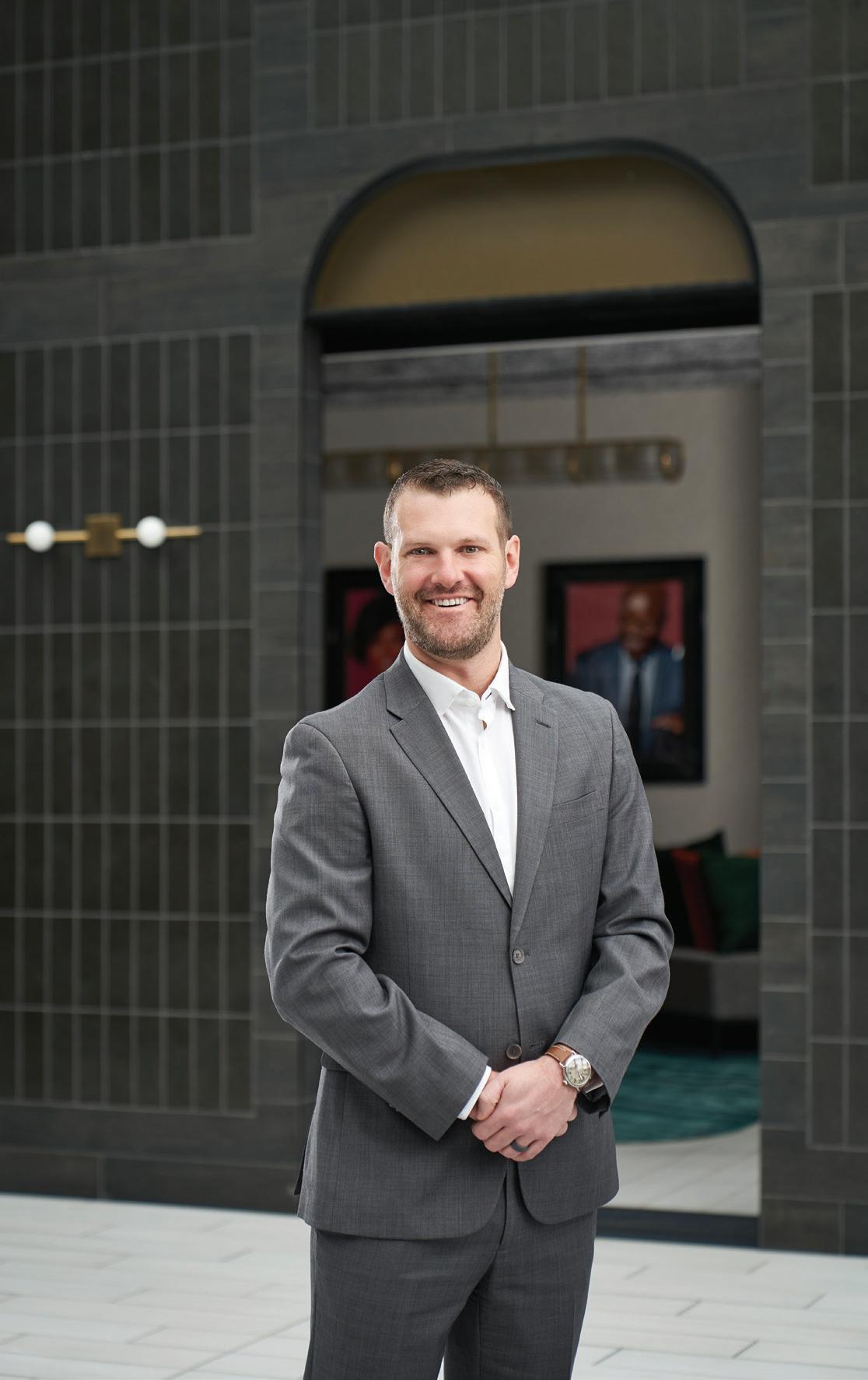
When Jennifer Borowy enrolled at Walsh University in North Canton, Ohio, in 2005, her goal was to teach math or English to middle school students. A part-time job as a bank teller, however, changed her life and career path.
“I just absolutely fell in love with it, helping people and advising them, and teaching them how to save and borrow and do anything with their banking needs,” Borowy says. “I ended up going into (the university’s) retail development program and banking.”
A year after graduation, Borowy won an award as the top teller in sales at the same regional bank where she had been introduced to the industry. Next on her career ladder was a promotion to assistant branch manager.
Her early success prompted a move to PNC Bank, where she quickly excelled and became a vice president and a branch manager.
In 2016, Borowy joined the Buckeye State Credit Union, a struggling lender in the Akron area with $85 million in assets. A net worth restoration plan she led boosted the credit union’s value by nearly 2 percent in one year.
That performance earned her a move north to metro Detroit in 2019, where she joined Michigan First Credit Union in Lathrup Village, a nearly 100-year-old lender with $1.5 billion in assets and 168,000 members.
“This was a unique opportunity because it had a well-designed succession plan. The CEO had been here, at that time, for 20 years, and I had the opportunity to work side by side with him for over four years in anticipation of his retirement,” she says.
Joe Bamberger likens his company’s talent development efforts to the way a college football team builds its roster. Schools that want to excel can look to the transfer portal, where they might find established talent who can come in from another school and help them right away.
But the most consistently successful programs, according to Bamberger, recruit outstanding freshman classes and then develop the talent.
This is the same type of thinking Bamberger wants Michigan companies to embrace as they build their own teams. He established Emerge in 2017 to help make that happen.
Emerge’s clients are employers, and Bamberger’s role is to connect them with as many places as possible where talent can be found.
“Creating relationships with educational institutions is the majority of our work,” Bamberger says. “Obviously, what entry-level looks like depends on the industry and depends on the client. It could be high school, CTE programs, trade schools, boot camps. The funnel into full-time positions is the area we focus on most.”
Bamberger talks about talent aggregation as working like any other supply chain. “Students are the raw material and employers are the end user,” he explains. “Education is the resource that shapes that talent along the way.”
First, the talent has to be procured. To help make that happen, Bamberger has developed a technology platform called EmergeNET. Launched in 2020, it’s a cross between LinkedIn and a dating app. Students
can create online profiles with digital resumes at EmergeNET, and can use virtual reality and gameplay to explore career paths and develop their credentials in a safe environment.
Bamberger also has played an active role in the Michigan Career Educator and Employer Alliance, where he currently serves as president (it’s a threeyear term). The organization is a nonprofit entity connecting two-year and four-year schools to the companies that hire college talent for positions ranging from internships to full-time positions.
The key to recruiting success, Bamberger believes, is for employers to not only value the development of younger talent, but also to reach out and make connections with them. To that end, he has formed partnerships between Emerge and public institutions like the Michigan Chamber of Commerce and the workforce development agency Michigan Works. Both tout Emerge’s offerings via its app and its willingness to visit schools to promote employment opportunities.
As the state brands itself as a place for young people to stay and build careers, Bamberger encourages companies to brand themselves as desirable employers while maintaining a commitment to developing young talent.
“We need to be able to work with people who buy into the philosophy of entry-level talent,” Bamberger says. “Many still want someone who can solve their problem right away, not invest in a couple of years of developing someone.”
— Dan CalabreseSince taking over as president and CEO in 2022, Borowy has increased statewide growth to 30 branches from 20 branches, mainly in Walmart, Meijer, and Kroger stores.
In addition, under her stewardship, Michigan First was certified as a Community Development Financial Institution (CDFI) and a member of the Detroit CDFI Coalition. The dual distinction allows the institution to provide banking and investment services to lowincome communities.
“Our No. 1 priority is to serve our membership very well, and what’s unique is that we offer an individualized approach to every member who walks in our doors or calls us,” she says.
Borowy also is expanding Michigan First Mortgage Co., which now services more than $1 billion in mortgage loans, along with introducing new services. An active member of the community, Michigan First’s foundation last year awarded $75,000 in scholarships and $100,000 to local nonprofit organizations.
“We’re creating a digital branch this year to meet our members where they are,” she adds. “If a member wants to do their banking from home, we can serve them that way.”
Next up is a youth account that will offer the cashless products younger members prefer, while also providing financial education.
“It’s very important that we continue to find ways to be able to financially educate our members,” Borowy says.
— Norm Sinclair

President, CEO Michigan First Credit Union, Lathrup Village Employees: 500 Revenue: $123.6M College: Walsh University (North Canton, Ohio)
Fortunately for Chris Brownell, the recently minted CEO of Kirlin Lighting in Detroit, his rise to the top of the family business was nothing like the HBO series “Succession.”
Unlike the TV show, where the patriarch of the family was reluctant to give up power to any of his children, Brownell’s mother, Jana Kirlin Brownell, now the company’s chair, had to practically plead with her son to join the business.
Kirlin manufactures lighting fixtures and systems with integrated controls for hospitals, schools, transit stations, theater house lights, and some residences. Kirlin’s products can be found at Detroit Opera, the University of Michigan Women’s Hospital, the neonatal intensive care unit at C.S. Mott Children’s Hospital, and several Corewell Health and Henry Ford Health facilities.
The company also installed the lighting systems in the MRI departments of the top 25 hospitals in the nation. “Every single screw and bolt in that light fixture needs to be non-metallic or else it could impact the MRIs,” Brownell says.
After graduating from Princeton University, Brownell landed a job in New York City doing technology consulting with clients on infrastructure for things like high-frequency (stock) trading and digitizing mundane banking services and protocols.
“I specifically didn’t want to go into the family business,” Brownell says. “If I went right into the family business, I’d have a great job, a great title, and a lot of responsibility, but I’d never know if I deserved it in any meaningful way.”
He started his career as an analyst at CSTechnology, where he stayed from 2013 to 2015. He then became a product manager at Sitehands until late 2017. Following that, he worked as a principal product specialist at PredictSpring Inc.
When Brownell came back to the Detroit area for the Christmas holiday season in 2017, his mother asked him to get his MBA and come to work for Kirlin. He agreed, and got his master’s from Cornell Tech, a New York-based offshoot of Cornell University.
Brownell joined Kirlin in June 2019 as a senior product manager. A year later he was named vice president of sales and marketing, then executive vice president. He became president in 2022 and CEO in February 2024.
“My goal for Kirlin is to continue our head start in spaces like health care, transit, and infrastructure by incorporating the best technology from areas like offices, high-end residential, and retail.”
— Tim Keenan
CEO Kirlin Lighting, Detroit Employees: 40 Revenue: NA College: Cornell Tech (Cornell University)
Executive Director Fox Run, Novi Employees: 800 Revenue: $55M College: University of Minnesota

Ashley Bulat, executive director of the Fox Run senior living complex in Novi, knew she wanted to be a businesswoman at a very young age.
“I have a picture of myself at 3 years old wearing a suit,” Bulat says. “I always wanted to carry a briefcase around. I was kind of an entrepreneur in elementary school, making and selling things on the playground.”
At the age of 16, as a young high school senior, Bulat would get out of school early to work full time leasing apartments. But it wasn’t until she was in her late teens, while in college, that she got an opportunity to work with senior citizens.
“I absolutely fell in love with helping people take that next step in their life,” she says. “These (were) people making decisions about senior living, assisted living, memory care. It was an area where I could take my love and passion for business and match that with something purposeful (and) rewarding, and giving back.”
Her passion for working with seniors led her to pursue an MBA with a health care focus.
While she was at Oakland University, she worked at Singh Management in West Bloomfield Township. Then she became executive director and director of operations at Ashford Martin Corp. in Madison, Wis. After that, she
took a similar position with United Methodist Retirement Communities in Chelsea.
She joined Fox Run — first as associate executive director, and then as vice president and executive director — after earning her master’s degree.
Fox Run is one of 20 continuing care retirement communities developed and managed by Maryland-based Erickson Living. Its 108-acre campus in Novi is home to more than 1,300 residents and around 800 employees.
“I think there’s a misconception out there about what retirement living looks like,” Bulat says. “I enjoy Fox Run because it’s a very active and engaging community. These aren’t your typical grandpas and grandmas. These are educated, cultured, well-traveled people. Some are former CEOs. We have so many clubs and activities. They want to give back and mentor.”
Bulat says her emphasis is on the future of Fox Run.
“I’m focused on the strategic plan for the future of Fox Run and leadership development, coaching, and developing our talent. We’re looking at how to attract talent and introduce them to this industry, and how (to) retain them and inspire them. This is special work.”
— Tim Keenan
CEO CJC Cruises, Grand Ledge Employees: 100 Revenue: $5M College: Lansing Community College
If you’re ever a passenger on the Detroit Princess riverboat, cruising the Detroit River and listening to the Motown sound, you might be surprised to discover the CEO and owner of the craft, Chris Chamberlain, is often at the helm.
“I still drive (the boats) pretty regularly,” Chamberlain says. “It’s nice to get out and interact with your customers.”
Chamberlain grew up in the Grand Ledge-based CJC Cruises business, which was started by his parents in 1970 as a canoe rental company. Over the years, the enterprise grew to include boats that held 49 people, then 110, then 300. The Detroit Princess holds 1,900 passengers.
“We just kind of kept growing over the years,” Chamberlain says. “I guess I always knew I’d be doing this as a career.”
His father passed away when Chamberlain was in his mid-20s, and he took over the business. At that point, the enterprise consisted of three large boats — the Detroit Princess along the Detroit River, the Michigan Princess in Lansing, and the Grand Princess Riverboat in Grand Ledge.
He has since added two boats in Petoskey, one of which is a 70-year-old vessel that began its life as a Mackinac Island ferry. The Petoskey fleet shuttles customers between Harbor Springs, Petoskey, and Bay Harbor.
Chamberlain continues to think about expanding the business.
“There are definitely some places along Lake Michigan where I don’t currently have boats that I’d like to bring boats,” he says. “A lot of people get into the dinner cruise business as a retirement job. After 20 years they get tired of it, and I’m sure there are some of those we can add to the fleet.”
Chamberlain says there are three elements to his business: the boat ride, entertainment, and food service. The boat part concerns him most.
“I can easily hire people to provide entertainment, and cook and serve food,” he says. “The boat stuff is the hardest part. It’s tough, especially in the smaller markets, to find qualified people.”
Prior to taking over the CEO role in 2021, Chamberlain was president of CJC’s food service division, J&K Catering, for 10 years. During that time, he earned a U.S. Coast Guard 100 Masters license, which certifies him to pilot most any large vessel. He also is a USCG Merchant Marine captain.
“If we went to war, I could be called up,” says Chamberlain, who spends his free time with his family, as a sailing member of the Bayview Yacht Club, and as a downhill skier in winter.
— Tim KeenanPresident Chunk Nibbles, Troy
Employees: 9
Revenue: NA College:
Michigan State University

Working in Chicago for a commercial insurance company, Brad Cocklin was living a 20-something’s dream: He had an expense account to use for entertaining clients in the big city.
But when Berkley native Cocklin started talking about the future with his colleague and then-girlfriend (now wife), Katie, they realized they wanted to do something professionally that would better align with their passions. And, in this case, their taste buds.
Cocklin thought about his family’s longstanding holiday tradition of making a sweet, crunchy recipe that had been developed by his grandmother, Cuddy. The treat was made with a mixture of pretzels, rice cereal, peanuts, and white chocolate.
“Growing up, it would always be in bowls under the (Christmas) tree,” Cocklin says. “My mother would make 300 cookie tins of it, and everyone loved it.”
Cocklin was convinced the product could be a hit if it got enough distribution. In 2018, he and Katie began putting together the framework of a business model. Finally, one day, they marched together into their boss’s office in Chicago and told him they were quitting so they could move back to the Detroit area.
The company tried its best to keep them, making an attractive offer to let them manage the Detroit-area operations “and run our little snack operation on the side.”
It was a good offer, and Cocklin says he
seriously considered it. But Katie didn’t want to wonder what would have happened if they’d gone all in.
They branded the snack Chunk Nibbles, found a commercial kitchen on Northwestern Highway, and set up corporate offices in Troy.
With $24,000 from a liquidated 401(k), their margin for error was small. Cocklin started reaching out to grocery store managers, even though he knew little about the retail food sector.
“When I look back at some of the e-mails I sent in 2018, I can’t believe anyone gave me a chance,” he says.
The big break came when Cocklin contacted Brad Busch, director of category management at Busch’s Fresh Market, by retrieving Busch’s cell number off his LinkedIn profile (it’s no longer there).
“At first, he was like, ‘Who is this?’ ” Conklin recalls. “But we drove from Rochester to Ann Arbor to drop off samples, and before we were even back in Rochester we had a call asking if we could produce enough to supply all of their stores.”
That’s 16 stores, which would require a lot from a workforce that mainly consisted, at that time, of family and friends. But the Cocklins knew they couldn’t miss the opportunity.
Today, the company employs nine people, and Chunk Nibbles can be found in 3,500 stores nationwide. They’re also available on the Home Shopping Network and QVC.
— Dan Calabrese

Director Woodward Park Partners, Bloomfield Hills
Employees: 10
Revenue: NA College: Hobart College

As an investment banker, Nick DeCroo is exactly where he wants to be. It just took a while for him to get there. His first job was in 2011, at PNC Bank in Troy.
“It was a traditional institutional lending environment,” he says. “In 2012, I joined Quarton Partners, a small M&A shop in Birmingham. I think there were five or six employees at the time and we grew every year, expanding to 60 bankers and 10 offices by 2018.”
Quarton was eventually acquired by an even larger firm, which also swelled in size.
“That was the impetus for us to spin out some of the industrial and M&A stuff in the lower-middle market and start our own shop,” DeCroo says. “We’re so excited about what we’re doing now, because it’s very similar to how we started at Quarton.”
Woodward Park Partners, DeCroo’s new venture, is barely a year old, having launched last August. As a director, he’s one of only three members of the upper management team, and the rest of the firm is just as lean.
“There are 10 of us, but not all partners,” he explains. “We have a few senior adviser members and some mid-level and junior team members, but our core leadership dates back to the Quarton days.”
Apart from running a lean operation, the firm’s ideal client niche is very specific.
“There’s a lot of companies in that $3 million to $7 million range that are either not getting advice, or getting bad advice,” DeCroo says. “A lot of times they take the advice of their accountant or a family friend, and do a transaction that might not be the best for them.
“We pride ourselves on bringing that big bank expertise to small business owners and small private equity groups in our area, and delivering an unmatched level of quality and service.”
Most of the deals DeCroo and his team handle are similar in nature.
“The bulk of what we do is sell-side M&A, about 85 percent, usually in a couple of different forms. It could be a total sale and exit, because the client wants out completely. Or it’s (selling) a portion of the business to de-risk a little bit. So we build a financial package and go to the broad set of buyers that would most likely invest in that business.”
No matter how disparate the clients and their respective businesses, invariably all share at least one characteristic.
“It’s usually a private business owner who’s grown everything from the ground up over the years, or it’s been in the family for generations,” DeCroo says. “It’s one of the top two or three life decisions they make. It’s really personal and emotional, and there’s ebbs and flows in deals, and it can be stressful. We just try to help level the playing field for them relative to bigger, more sophisticated companies that don’t necessarily have those challenges.”
As a result, DeCroo concedes, possessing a sophisticated grasp of the M&A business is only part of his job. “Half the time we’re playing bankers, and the other half we’re playing psychologists.”
— Ronald Ahrens

Founder Detroit Aerial Cleaning, Warren Employees: 15 Revenue: NA College: Michigan State University
Paolo Fabbri was preparing to graduate from Michigan State University with a degree in economics when his father, Thomas A. Fabbri, CEO of Aaro Cos. in Warren, tried to convince his son to work outside the family business for a while. That wasn’t something the young Fabbri was interested in.
“My dad was encouraging me to go out and get some experience working somewhere else, but I told him I wanted to learn from him,” says Fabbri, who’s now general manager of Aaro Cos. and founder of Detroit Aerial Cleaning. “I thought I was going to have a desk job, but that didn’t happen. It wasn’t easy. I was doing post-construction cleanups in the field with the crews.”
As GM, Fabbri runs Aaro’s daily operations — quoting jobs, overseeing budgets, setting and meeting revenue projections, managing employees, and more.
Founded in 1945 by Fabbri’s grandfather Emilio, Aaro Window Cleaning has evolved into Aaro Cos. Today, the company provides building maintenance, exterior glass cleaning, janitorial services, and janitorial supplies.
The company prides itself on its use of reverse osmosis technology to deliver the highest quality
cleaning with the added benefit of having a low impact on the environment. In most cases, Aaro can clean fourth-story windows from the ground, allowing crews to work faster and more safely, and pass any savings on to customers.
What about windows higher than the fourth floor? Fabbri, a graduate of De La Salle Collegiate High School in Warren, discovered an opening in the local window cleaning market that he decided to fill in 2016. At the same time, he was exploring his entrepreneurial drive.
“When I graduated, I saw a niche in that market and I kind of wanted to branch out and start my own thing,” he says.
That thing is Detroit Aerial Cleaning, a subsidiary of Aaro that scales as high as 600 feet to clean building windows, including those of the Ally Detroit Center downtown.
“We specialize in rope-access cleaning in very hard-to-get areas,” Fabbri says. “The line of work is very dangerous, and we wanted to separate it from Aaro from a liability standpoint.”
Does Fabbri ever venture out onto the ropes on the side of skyscrapers? “I’m the smart one. I keep my feet on the ground.”
— Tim KeenanPublic accounting was a natural way for Ryan Gross to start his career after he earned bachelor’s and master’s degrees from John Carroll University — and a very appealing job with PwC certainly fit the bill.
After a year of working on the audit side of the company, Gross realized something. While he liked the company and the people, he wasn’t finding satisfaction in chronicling, after the fact, what had happened. He wanted to be able to impact the outcome for his clients.
His father, an attorney who handles turnaround restructuring cases, kept telling his son he would find the field interesting. Gross put him off, until eventually the day came when he could no longer do that. “Finally I told him to give me some names of who to talk to,” Gross recalls.
Initial conversations with major firms like Alix Partners and Alvarez and Marsal piqued his interest, and he ultimately landed a job with Riveron (formerly Conway MacKenzie in Birmingham). He had found his thing. “I really fell in love with it,” Gross says. “You’re helping clients that are in trouble.”
After five years, Gross joined New York-based turnaround firm Getzler Henrich & Associates as director of its Detroit-area operations.
Today, Gross finds every opportunity to bring a client back from the brink rewarding. Of course, such situations are also filled with stress — especially for company executives and their employees, who know it’s not a good sign when a turnaround management company has to be called in.
“Employees can look us up and see who we are,” Gross says. “I try to be transparent. It’s how I’ve always done it. I’ll tell the clients, ‘Here’s the situation as I’ve discovered it. I’ll try to keep you updated as much as I can, but I’ll always do what’s best for your family.’ ”
Turnaround firms are usually brought in by banks when one of their business customers is in financial distress and isn’t able to maintain its obligations. The problems can arise from a variety of situations — sales can dry up, financial strategies don’t work, or overhead gets out of control.
While many turnaround firms are brought in primarily to manage bankruptcy cases, Gross says he usually works in situations designed to save a company from bankruptcy.
“Our job is to figure out the problem and resolve it to keep the cash flowing,” Gross says. “The majority of our cases aren’t bankruptcies, and we’re able to get in there ahead of time (and) solve the problem so the company avoids bankruptcy — or we can take them down a different path so they can sell the company or do something else.”
Often, the key for Gross and his team is to bring an objectivity the management team doesn’t have.
“I’ve been brought in and the management team is like, ‘Sales will get there, the product will sell,’ and they can’t step back and be objective,” Gross says.
One of the best rewards, he says, are the relationships he builds with clients who keep in touch after he helps them save their business. “I always tell them, if you need anything, give me a call,” Gross says.
— Dan Calabrese
Director Getzler Henrich & Associates, Detroit office Employees: 35
Revenue: NA College: John Carroll University

Vice President of Strategic Finance and Analytics
Amrock, Detroit Employees: 1,100 Revenue: $245M College: Walsh College
On Katie Hersh’s bucket list of things to do is to be a teacher. But one semester of student teaching while she was an undergraduate student at Saginaw Valley State University convinced her to give up her early ambition and go into accounting.
“I would love to actually be a college adjunct professor, maybe at a community college, teaching accounting classes,” Hersh says. “I have a passion for learning like a lifelong student, but I also love teaching others.”
With her teaching career on hold, Hersh followed her college instinct and spent two years as a public accountant in Ann Arbor before returning to Walsh College to get her MSF in finance.
“I definitely love data,” she says. “Financial accounting is very black and white, just very much about debits and credits that balance out. But with finance you can tell the story of what the actual impact on an organization is and help drive strategy, and I’ve always had a passion for that kind of storytelling.”
Hersh says she found her niche leveraging data and financials with her 30-member team at Amrock, the title-insurance arm of Rocket Cos. in Detroit, where she’s vice president of strategic finance and analytics.
“The team really drives strategy for our organization, which has allowed me to be a
part of driving the overall strategy in the title insurance space,” she says. “People don’t usually go to school to get into title insurance, and it’s not a field I thought I would ever see myself in, but it’s been a great opportunity for me over the last decade.”
Rocket’s decision to go public in 2020, when it raised $1.8 billion, provided her with her biggest career challenge. The plan was executed against a backdrop of uncertainty during COVID-19. Hersh and her team were credited with mining, analyzing, and presenting Amrock’s comprehensive data required for the successful public offering.
Tackling such a monumental moment for her employer’s future didn’t faze her. “I thrive under pressure,” she says.
“There’s that adrenaline rush of taking something that we’ve never done before and building it, and to be able to really mold it and figure out how to tell that story and drive that vision forward, that’s awesome.”
Hersh, who joined Rocket in 2012, also leads business intelligence and data reporting teams that constantly scan the horizon to discern trends and monitor progress.
In addition, in 2021 she was honored with HousingWire’s HW Insiders Award, given to professionals who are “a company’s secret, yet vital to its success.”
— Norm SinclairOwner CHYDUK, Detroit
Employees: 1
Revenue: NA
College: Columbia University

Amonth-long stay in the Cleveland Clinic treating a rare congenital condition with an equally rare innovative surgery might be too much for most patients to endure.
That wasn’t the case with Christina Kalfaian.
Instead, from her hospital bed she created plans for a business, Papa’s Kitchen, that today produces gourmet salad dressings and at the same time honors her father, Jimmy Papadopoulos.
During his 40-plus years as a restauranter, Papadopoulos made his own signature pink Greek salad dressing for his restaurants — Sophia’s Family Dining in Troy and Ocean Breeze Family Dining in Shelby Township. Her father retired in 2015.
Kalfaian remembers laying in her hospital bed in midsummer 2019 and thinking: What can I do that would be honorable to him without him having to lift a finger? “So, I came up with honoring his legacy by bringing his pink Greek salad back to life for people to experience and enjoy in their homes every day,” she recalls.
Soon after, she made sketches of bottles and labels for the dressings, concocted two flavors of her own, and added one from her great-grandmother’s recipes. She says she left the hospital after becoming the 64th person worldwide to successfully undergo the surgical procedure she endured.
“Once I was out of the hospital I started researching and developing the knowledge of how to manufacture the products, and I paired up with Michigan State University’s Product
Chelsea Hyduk, founder and owner of CHYDUK architectural firm in Detroit, is far from the sole proprietor that her one-person shop might suggest. She’s all about working with others.
“It’s so inspiring to me to be living and working in Detroit because there’s a vibrancy to this place,” Hyduk says. “It has such a rich history, but it also has this incredibly dynamic future, and designers are playing such a critical role in shaping that future. There’s this sense of collaboration.”
Her company acts as the design architect on projects that contribute to enhancing and uplifting the respective local context and communities.
“I’ve begun to focus on heart-centered projects for clients who are aspiring to create beautiful spaces that make an impact beyond the bottom line,” Hyduk says. “Architecture is this bridge between materials and spirituality in the way we experience space.”
The firm also acts as an umbrella enterprise for multiple companies to foster people working together on various projects. “That allows me to collaborate with other designers, architects, and friends while also maintaining autonomy over my practice and my life,” she says.
One example is MCD Development & Design, founded in 2021, which focuses on
contributing to the fabric of the Core City neighborhood of Detroit. Projects use architecture to facilitate multigenerational living opportunities, access to nature, and community-building.
Another is the School of Intuitive Yoga Cooperative, which turned a sole-proprietor virtual yoga studio into a cooperative.
“It’s an example of innovating on this idea of the traditional yoga studio to create something that truly is … the students and teachers evolving and growing to shape the needs of the people who are involved with it every day.”
Hyduk grew up in the suburbs of Detroit, moved to New York to attend graduate school at Columbia University, spent 12 years there, and returned to her home state with her husband after the pandemic.
While working in New York at SHoP Architects, she was project manager for the 400,000-square-foot mass timber YouTube headquarters in San Bruno, Calif.
“That project opened up for me a deep understanding of my desire and drive to balance the built with the natural environment,” she says. “You can make something that neglects that and is more of a product, or you can become deeply connected to a place and its history, which has me so drawn to Detroit.”
— Tim KeenanCenter. It really helped me understand the process and guided me to get from my idea to an actual bottle,” she says.
With her mother, Cleo, Kalfaian founded Papa’s Kitchen in 2021. Within six months the women-certified startup sold 10,000 bottles, thanks to help from a social media campaign.
A local food distributor now supplies their four unique salad dressings — Dill, Greek, Harvest, and Vinaigrette — to more than 120 retail locations and restaurants in Michigan. Kalfaian says she recently moved into the Ohio market.
Fresh Thyme, Nino Salvaggio International Marketplace, Papa Joe’s, Busch’s, Hollywood, and Meijer are among the metro Detroit markets offering her products.
“Our story is a true testament of the American dream meets a miracle,” she says.
Kalfaian’s business acumen began taking shape at an early age. “I was 4 years old, taking cash at the cash register at Sophia’s, and I was probably the only 4-year-old that could count money properly,” she laughs.
If creating Papa’s Kitchen wasn’t enough of a challenge, Kalfaian did it while working as a licensed real estate agent with Berkshire Hathaway.
“I just took the knowledge I had from my real estate world and implemented it into the salad dressing world,” she says. “I’ve partnered (the two worlds). My closing gift to my clients is salad dressings for their first meals in their new homes.”
— Norm Sinclair Owner, CEO Papa’s Kitchen, Troy Employees: 3 Revenue: NA College: Eastern Michigan University

Senior Vice President, Co-owner

Nikki Little had her eye on a career in public relations since high school.
Now she’s a senior vice president and co-owner of Franco, a communications firm in downtown Detroit that’s celebrating its 60th anniversary in 2024. It’s also a fully women-owned and women-led business.
“I’ve always loved writing, but I didn’t want to go into journalism,” Little says. “When I was in high school, I learned about public relations from a family friend who had a PR role at a bank. I did a job shadow with her and really liked it.”
Shortly thereafter, she found out about the integrated communications program at Central Michigan University in Mount Pleasant and enrolled. After graduating in December 2006, she went right to work for Franco. She spent the first three years of her career working her way up from an assistant account executive to a senior account executive.
During those early years, she struck up a professional and personal friendship with current Franco majority owner Tina Kozak — a relationship that would pay dividends later.
Looking to gain more experience in the industry, Little left Franco to become director of communications at White Glove financial advisers in Troy, where she managed all internal and external communication efforts for the company. She also spent seven years at Identity PR in Birmingham, starting as a social media specialist and eventually moving into the director of social media role.
In September 2019, Kozak asked her to come back to Franco. “I stressed that if I was going to come back that I wanted to be involved in leadership and growing the agency,” Little recalls. In 2022, she was offered a chance to invest in the business.
In March 2024, the agency completed an ownership transition from former Chairman Dan Ponder to CEO Kozak. COO and President Tina Sullivan and Little maintained their minority stakes in the business.
Little credits relationships, among other factors, with her rise in the PR business.
“Had I not maintained the relationship I have with Tina Kozak, I wouldn’t be here today,” she says. “I’m a very organized, determined, passionate person. I very much value accountability and doing what you say you’re going to do. I’ve built a lot of trust with the people I’ve worked with over the years.”
Little, who oversees Franco’s efforts to market itself, says the firm’s 60th anniversary is one of the highlights of her career so far.
“What we’re doing right now with our 60th anniversary campaign, we really are practicing what we preach to our clients — showing the value and importance of integrated communications.”
— Tim KeenanWith multiple family members serving as health care providers, Jason Lockard always figured he would go into the field.
But while majoring in health sciences at Oakland University in Rochester Hills, his path took a turn when he began learning about business. Lockard soon realized that while he wanted to go into the health care field, he wanted to do it on the business side.
So he supplemented his bachelor’s degree with an MBA from Walsh College in Troy. Following graduation, he moved into administrative positions with health care organizations such as Concentra Medical Centers, Dane Street, and Great Expressions Dental Centers.
When Beaumont Health System (now Corewell Health) came calling in 2019, Lockard initially took a position as a regional practice administrator working with adult care providers. In 2022, he found his true calling when he was appointed director of operations for Corewell Health Children’s in the eastern part of the state.
“My wife and I had just had our second daughter,” Lockard says, “and I have 14 nieces and nephews, including three foster nephews and one foster niece, who are incredibly important to me. So to be able to serve pediatric patients (at a time when) kids are such a big part of my personal life was really important to me.”
While his position in operations doesn’t put Lockard in direct care of pediatric patients, he knows how important it
is to run a tight ship and support practicing physicians and their respective teams.
To broaden his perspective, Lockard serves as a volunteer at Hope for the Hungry Pantry in Macomb Township, and he often brings his 6-year-old daughter with him. He’s also active with the American College of Health Care Executives and the Michigan Society of Hematology and Oncology.
“What has really come to light for me is the tenacity and the tireless resolve of our physicians, who dedicate their lives to the patients they serve,” Lockard says. “They’re unwavering in doing the right thing for our patients at all times, every time, and I think that’s what’s really encouraged me. It’s not just that we’re trying to deliver the best care to patients; it’s how hard our physicians work at doing the right thing and making sure our patients are taken care of.”
Since the Beaumont/Spectrum merger that made Corewell a statewide system, Lockard coordinates closely with his counterparts on the west side of the state. He also has to grapple with the reality that health care finance is unique.
“In a traditional business, the focus is on your bottom line and being a profitable business,” Lockard says. “In health care, the mission is to serve patients and take care of people. So when you move into health care administration, you really have to have that perspective.”
— Dan Calabrese

One day in March, Giuseppe Lucido was busy with preparations for UWM Live! — United Wholesale Mortgage’s huge convocation of brokers. For the third annual edition of this event on May 15-16, United Wholesale Mortgage plans to welcome up to 7,000 mortgage professionals to its Pontiac campus.
“It’s just a day about getting better, a day for (mortgage) originators to get away from their o ce and come to take one or two things away,” Lucido says. Mat Ishbia, president, CEO, and chairman of UWM, “likes to announce some big, fun things or di erent things we’re rolling out.”
Working on details of the upcoming event is an example of what Lucido means when he tells people he helps run a mortgage company. As senior vice president of operations, he divides his duties into two parts. Being “Leader Joe” consumes roughly half his time, as he heads UWM’s lending support, closing, post-closing, and client experience teams.
“I have about 2,300 people that roll up to me in some form or fashion,” he says. This mass of talent, about one-third of the company’s sta , covers 30 di erent functions. More specifically, he works with 20 to 30 middle- and senior-level managers to refine internal processes.
“It’s all about people,” he says. “I don’t have inventory. I don’t have patents. I’m not competing with people on how cheap I can buy aluminum. For me, it’s about creating a leadership culture in my group that makes people want to stay, (and) gives people an opportunity to grow and develop

Corewell Health
Children’s, Royal Oak Employees: 233

Revenue: $81M

College: Walsh College
into a version of themselves bigger and better than they were before.”
The other half of his job is concerned with corporate initiatives such as implementing TRAC — Title Review and Closing. He says it’s “basically an alternative to traditional title insurance as a mechanism for saving consumers money.”
Lucido took a roundabout path to his present position. Throughout his college years, he tended bar at Carrabba’s Italian Grill in Sterling Heights. He was still there in February of 2013, just a few months after receiving his degree. Serving the parents of a friend, he heard them extol United Shore Financial Services, as the company was then known.
Underwriting was a familiar concept, Lucido says, and he knew he wanted to stay out of the auto industry, which was “brutal” for his father. So he applied online. At first he worked in underwriting before joining a business innovation group. Next, he managed the underwriting business. He became senior vice president of operations at 29.
“Then we went home for COVID-19 six months later,” he recalls. But mortgage lending boomed during that time, and his team grew fast, and he says, “it really was a crazy couple of years in my life.” As things settled, Lucido sought more of a work-life balance. He helps to coach his two boys in hockey, and still plays a bit himself. “When I’m not (at work), I’m usually on the ice.”
Retirement is far in the future, but he says that when it happens, “I’ll still be here. I tell Mat all the time, I’m good doing this for the rest of my career.”
— Ronald AhrensMark Mann was a high school student in Charlotte, N.C., when he caught the bug. “I had a love and excitement for cars in general,” he says. “I knew early on that I wanted to do anything that had to do with engines and performance parts. That led to me being the first member of my family to go to college.”
After earning a bachelor’s degree in mechanical engineering and a master’s degree in engineering management, Mann didn’t have to venture too far to land a job.
“At the time, Auria was in Charlotte, so I could stay close to home,” he says. “I got an interview and that’s how everything started.”
Not bad for a guy whose previous gigs didn’t exactly tee him up for a career in engineering. “When I was 16, I was pushing carts at Target,” Mann says. “In college, I worked in the deli department at Costco. This is only the third job I’ve had in my life.”
Mann has come a very long way in his 10 years at Auria, a Tier-1 automotive supplier. Today, as director of engineering – North America, he’s in charge of four distinct subgroups: advanced manufacturing engineering, capital equipment, manufacturing engineering, and tooling engineering.
“The company specializes in automotive interior and acoustic components, not the speakers,” Mann says. “It’s more sound-deadening and dampening, and keeping all the engine and road noise out of the
passenger cabin so the ride is a more enjoyable experience for the occupants in the car. We do everything from floor carpets to the P shelf in the rear back, the inner dashes, the wheel arch liners, and the trunk floors and side trims. It’s a vast commodity base.”
At the company’s North American headquarters in Southfield, Mann oversees the engineering operations. “Our footprint ranges from St. Clair, Mich., all the way down into Mexico. Since I’ve inherited my position, we’re still very data-driven, but I’m constantly trying to push our team to new innovations that will deliver us the opportunity to gain more business.
“The more innovative we are, the more cost-competitive we become, and the more business we get. To me, unless you’re an industry leader, you’re not in an acceptable place.”
When Mann earned his master’s degree in engineering management, he also completed what’s known as a Six Sigma Black Belt.
“It’s a certification that means you’re a statistician and you can use statistics to influence processes,” he casually explains.
Does this mean that his black belt has nothing to do with karate, and Mann’s hands aren’t registered as lethal weapons? “I wish! That’s a lot cooler than math. Unfortunately, it’s just an uber nerd designation that means my calculator is always on me.”
— Tom Murray
Director of Engineering North America Auria, Southfield Employees: 4,000 Revenue: $467M College: UNC Charlotte
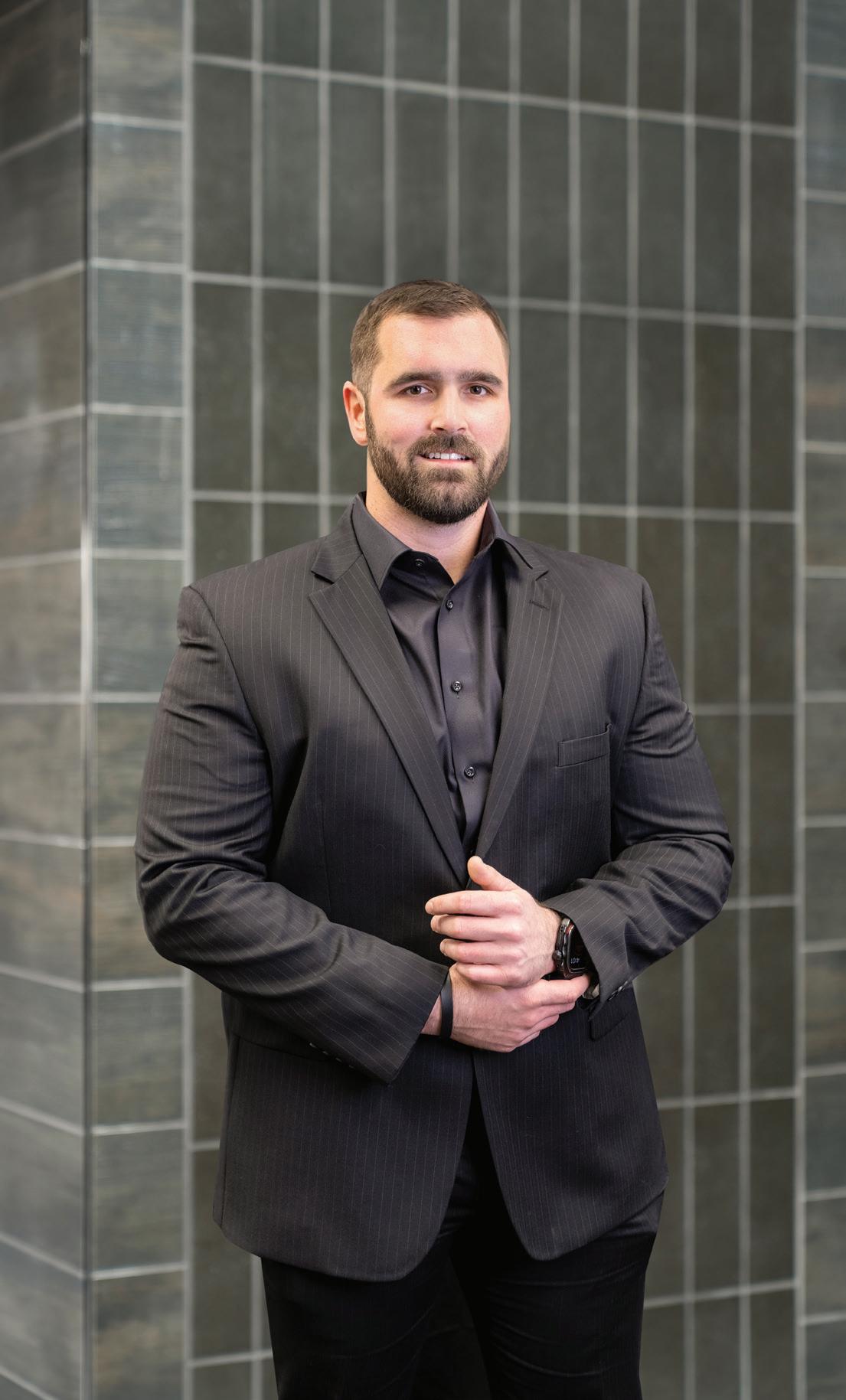
President Display Group, Detroit Employees: 150 Revenue: $25M College: Macomb Community College
Between 1903 and 1956, the Packard plant in Detroit churned out luxury automobiles and Rolls Royce Merlin engines for P-51 Mustang fighter planes, the latter produced during World War II. Today, in a well-maintained warehouse from 1939 that’s at the north end of the once sprawling campus, you’ll find the Display Group, led by President Mike McConnell.
The 255,000-square-foot building has become the creative and production center for world-class events like Detroit’s Movement Festival, a Mercedes AMG Petronas F1 Racing Team party in Miami, the 420 Liv Cannabis event, and the Consulate of Italy’s LoveITDetroit design soiree.
“We love it here,” McConnell says of the Packard plant’s last standing structure. “We’ve poured millions in investment into this building.”
The Display Group does all of its fabrication using 3-D printers and other equipment, while other areas of the building are used to store sets and props for multiple themed activities such as hoedowns and rodeos, a Parisian palace, a tropical luau, and Christmas scenes.
McConnell was a 13-year-old freshman at Lakeview High School in St. Clair Shores when he was bitten by the production bug.
“I started working at the high school auditorium my freshman year,” he recalls. “I fell in love with production. I fell in love with the emotion that drives people when they’re seeing something and experiencing
something. I like being behind the scenes and creating the atmosphere that evokes that emotion.”
He started Fairway Productions, a school dance deejay service, at age 14, and convinced many high schools in Macomb County to sign contracts for his company to provide the music for all of their annual dance events. “Over the years I learned that there was a production industry, which was great because I hated deejaying,” he says.
When he graduated, McConnell sold off the deejay contracts, kept the company name, and transitioned into production, equipment rental, and fabrication. In 2017, he joined forces with a competitor and formed AVL Creative. In December 2022, AVL Creative became the Display Group, with McConnell at the helm.
Of all the events he’s produced, the one of which he’s most proud is the annual holiday party at United Wholesale Mortgage in Pontiac.
“That’s a 300,000-square-foot convention center with brick walls and concrete floors and we come in, work on the design for eight months, and completely transform the space,” McConnell says. “We bring in 30 to 40 semi trucks with equipment and set up for three weeks.
“It’s a really big undertaking and really lets us spread our wings and do what we’re really good at doing.”
— Tim KeenanOwner, CEO
Hot Commodity
EyeWear, Detroit
Employees: 1
Revenue: NA
College: Wayne State University

Shalandria McGlown is turning her passion for fashion into a business that produces eyewear as the owner and CEO of Hot Commodity EyeWear in Detroit.
Growing up, McGlown wanted to be a fashion designer — but she got sidelined into a career at various Meijer locations.
She spent 11 years as a pricing supervisor for Meijer, working on pricing, inventory, and supporting store product flow. From there, she became an assistant store director, organizing customer service, product, and production.
Today, in addition to the eyewear enterprise, she’s working part time as a store human resources manager, providing HR support and assistance to store leadership through coaching and guidance on HR-related matters including staffing, workforce planning, training and development, retention, onboarding, employee relations, compensation, EEO, safety, and policy.
Four years ago, McGlown decided to exercise her fashion muscles. “The last purchase I made from a standard optical store was very expensive and I said, ‘I’ve just got to try this,’ ” she recalls.
“I’m really passionate about fashion and originally I wanted to be a fashion designer. So, I decided to take my passion for fashion into optical. I started out doing sunglasses as a hobby because I like sunglasses. Eventually I said, ‘Why not go into optical frames and readers?’ ”
In 2021, she took Hot Commodity EyeWear into eyeglass frames, which are being sold online, wholesale, and by small, independent opticians in Highland Park, Hamtramck, and Detroit.
Hot Commodity’s sunglasses and optical frames are bright, colorful, and come in shapes and sizes one might not find in a typical optical store.
“We usually go with a square or cat eye,” she says. “We tend to do bold and bright colors, something you can’t find at an optician. We try to make sure they’re in unique, bold statement colors as well as (fun) shapes.”
McGlown’s frame designs are manufactured in Italy and China. “Italy is really good with buffalo horn material when it comes to pricing,” she explains. “China is good with normal plastics and metals. They also do well with custom logos.”
Future plans include expanding into stores in Tennessee, Florida, Alabama, and other southern states. Additional goals include opening her own optical shop and partnering with a school like Wayne State University, and maybe even hospitals, where future opticians can have a space to get training in their field.
“Hopefully by age 44, I’ll be doing this full time,” she says.
— Tim Keenan
Not long ago, it certainly seemed as if Jack Miller was destined for a career in football — on or off the field. Miller, who was the starting center for most of his playing career, earned three letters at the University of Michigan in Ann Arbor, along with honors as the Wolverines’ top offensive lineman as a junior. As a senior, he was the team’s co-captain.
After graduating in 2015, he jumped right into coaching as an assistant at the University of Toledo.
The coaching stint lasted for one season before Miller moved into the booth for several years as the color commentator for Toledo’s games. This fall, he’ll take a seat for his third straight season as an analyst for the Michigan football radio network.
In addition to his accomplishments as a football player, coach, and commentator, Miller earned a bachelor’s degree in political science, along with a minor in sales and marketing from the Ross School of Business. That made the abrupt turn in his career less jarring than it perhaps appeared when Miller began working for Hylant, one of the largest privately held insurance brokerages in the country.
“Let me tell you,” Miller says, “nobody grows up as a little boy or girl and says, ‘I can’t wait to get into insurance.’ ”
Miller has settled into what he calls his “first big-boy job,” and has been with Hylant for seven years now. He’s enjoyed a rapid rise at the company, which has its headquarters in Toledo; in his current position, he serves as the market president of southeast Michigan.
“I oversee two offices between Birmingham and Ann Arbor,” he says, “and I have the sales team under me — probably 130 people in all.”
It’s a lot of responsibility, especially for someone who’s just 30 years old. But Miller isn’t your average 30-year-old.
“When you play sports at a high level, you understand the concept of teamwork, being accountable, and doing what you say you’re going to do,” he explains. “As a center, you weren’t only worried about your job, but you had to make sure everyone else on offense was on the same page. So there’s a ton of overlap between my football career and what I’m doing now. I feel fortunate that I was preparing for a niche for years, but I didn’t really know as I was doing it.”
Not surprisingly, Miller has lofty aspirations for his sales team.
“I think the insurance industry has a reputation of being a bit old and outdated,” he says. “Our approach is more focused on building quality relationships. Hylant is one of the few companies left in the country that’s sizable, yet family owned, and we (work with everyone from) Fortune 500 companies all the way down to a mom-and-pop store on the corner.
“We compete with publicly traded and private equity-backed companies, and they do things a little different than we do, but insurance is a relationship game. It’s about who knows you and trusts you, and there’s no reason that Hylant shouldn’t be the dominant independent brokerage for the state of Michigan — and that’s my goal.”
— Tom MurrayPrincipal Designer, CEO
Concetti, Detroit
Employees: 10
Revenue: $1.9M
College: Kendall College of Art and Design

Southeast Michigan President Hylant, Birmingham
Employees: 1,100 • Revenue: $230M
College: University of Michigan

Working for a construction firm and an interior design showroom taught Rachel Nelson many things about the creative process, but none more important than this: Most people don’t understand the interior design process.
A third-generation Detroit business owner — her grandfather owned a butcher store and her father operated a steel company — Nelson thought she could do something to promote a better understanding of the design process.
So, in 2014, the Kendall College of Art and Design graduate acted on her belief by forming Concetti. The firm does interior design work for both business and residential clients, with the mission of making a space reflect the identity of those occupying it. If it’s for a business, the space should reflect the company’s brand identity. If it’s a residence, the space should echo the personality of those living there.
But before Concetti can get clients to that point, Nelson and her team have to make them comfortable with how it all works. That’s a type of company culture she thought was missing in Detroit, and part of what motivated her to start her own business.
“We did a bunch of market research, and out of this research we found that people are confused by the design process — renovations, building a home,” Nelson says. “It’s an industry for a reason, and people were like, ‘I’m not sure what’s going on.’ So I wanted to create a process that alleviates the stress. We’re your ambassadors. Let us be the translator in the process.”
The process Nelson and her team developed is based on the concept of design thinking, which requires empathy, defining, ideation, prototyping, and testing.
“It’s this balance of left- and right-brain thinking,” Nelson says. “You expect us to design a beautiful space, but more importantly we’re going to be a good strategic partner for you.”
Concetti intentionally avoids being identified with any particular style of design.
“We’re not going to impose ideas and trends,” Nelson says. “A successful project, to us, means the space is a unique reflection of this person or brand. We’re not afraid to do different things, use bold colors and patterns. We empower our clients to want to take the risk because it’s authentic to them.”
Nelson also seeks to make a positive impact on both the community and on her employees in various ways. Since 2017, the company has pursued an initiative called Gratitude Attitude.
“It’s our way of giving thanks to our community,” she says. “It’s looked different through the years. We’ve supported a women’s shelter, where we raised money and purchased products for the home, to make it feel more residential and less institutional. We’ve also supported various dog rescues.”
Internally, she gives her employees quarterly mental health breaks during which they’re able to work with wellness coaches. “It’s so important that we fill our cups and not burn out,” Nelson says. — Dan Calabrese
What do you want to be when you grow up?” The answer to that question to a child rarely becomes reality. Courtney L. Nichols, a partner at the Plunkett Cooney law firm in Bloomfield Hills, is an exception.
“I’ve wanted to be a lawyer since I was 8 years old,” she says. “I was really inspired by wonderful TV shows such as ‘The Practice,’ ‘True Crime,’ and news stories about trials, and fell in love with the concept of being a trial attorney.
“I was also told at a young age that I would argue with anyone. I didn’t take no for an answer and I asked a million questions, so being a lawyer seemed like a perfect fit. It’s something I never really looked away from.”
She kept her eyes on the prize while attending Clarkston High School, Michigan State University, and the Chicago-Kent College of Law at the Illinois Institute of Technology.
One element of Nichols’ dream did change. Once an aspiring criminal defense attorney, she was introduced to employment law at Plunkett Cooney during her second year of law school. She ended up enjoying that area of law and focused on it at Chicago-Kent.
“Now, I don’t do criminal law but I’m still a defense attorney representing employers and companies that have been accused of wrongdoing,” Nichols explains. “If it turns out the company did something wrong, we identify it, we discuss it, and we find a way to deal with that. Usually, the strategy is to find a resolution, not to bury it or hide it.”
Nichols truly is living her dream, becoming the second-youngest person to make partner at Plunkett Cooney in the more than 100-year history of the firm.
“I’m extremely driven and goal-oriented,” Nichols says. “I heard about another individual who made partner in six years, so that was a benchmark for me to hit. That’s something I really strived (for).”
She made partner in five years.
While Nichols still spends time in court with clients, the bulk of her work is consulting with businesses on employment policies and protocols, reviewing employee handbooks, and assessing individual cases.
Now that’s she’s an established attorney, does she still enjoy watching TV shows about her profession?
“I avoid legal shows like the plague,” she says with a chuckle.
— Tim Keenan
Special Litigation Department Leader and Partner
Plunkett Cooney, Bloomfield Hills Employees: 300 Revenue: NA College: Chicago-Kent College of Law




IPresident, CEO Next Travel, Ann Arbor Employees: 42 Revenue: $40M College: University of Michigan Co-owner, Managing Partner
After starting her career in commercial real estate, Michelle Rafalski joined Gleba & Associates, the financial planning firm her mother, Jill Gleba, founded in 1985. “I would call it very tedious,” she says of the business. “There’s a lot of nitpicky, need-to-know-this-specificrule, law, (or) number.”
For Rafalski, though, the testing and certifications were a natural step — plus, she grew up around the o ce. “I joke that (the firm is) baby No. 1, I’m baby No. 2, and my brother is baby No. 3,” she says. She became managing partner in 2022, allowing her mother to pull back a bit and reduce her role.
Now things have come full circle. Rafalski just delivered her own first child, a girl, and she turned over business matters during her maternity leave to co-owner Moiz Kharodawala, the banking, mortgage, and taxation expert who joined the firm in 2013.
Together, they’re slowly buying out Gleba. The seamless interaction and family-friendly atmosphere are by design, Rafalski explains. “It was set up that way for our employees’ sake, because work-life balance is really important, and for our clients’ sake.”
Following graduation from the University of Tennessee, Rafalski came back to metro Detroit. She spent eight years as a real estate associate at Marcus & Millichap before her mother finally succeeded at coaxing her into the family firm.
Enjoying her management role, Rafalski says the best part of a recent day was attending two networking
t was 2010, Charlie O’Neill’s sophomore year at the University of Michigan in Ann Arbor, when it occurred to him that he just might be able to create a business out of a passion for travel and exploration.
“My family took trips to di erent places over summer breaks and other times,” O’Neill says. “I knew a lot about travel from doing it growing up, and I really saw an opportunity to put a travel company together and plan group trips for spring break to Mexico, the Caribbean, and areas that weren’t being targeted by larger companies at the time.”
Initially, O’Neill called his company HD Travel, for High Definition. “I operated it at U-M as I was struggling to decide if it was what I wanted to do for the rest of my life. When I graduated, I decided to stick with it.”
O’Neill was the sole owner and employee until 2018, when he merged with another travel business in Ann Arbor and created a new joint venture, Next Travel. “We grew that significantly,” he says. “Then COVID-19 hit, travel went to zero, and everybody said what a horrible business (it was) to be in.”
But O’Neill had a vastly different take on the situation.
“It was a great time to go out and acquire companies,” he says. “Everyone thought we were crazy. They’re like, ‘What are you doing? You’re increasing your overhead at a time where there’s no profit.’ But we were very strategic, and we believed eventually people would be getting back on airplanes.”
Beginning in January 2021 and continuing over the next two years, Next Travel gradually expanded. It now has four locations in Michigan, one in Indiana, and more than 40 employees.
“Our winters are big drivers for people to do trips,” O’Neill says. “The bulk of our revenue is generated in Q1, when people want to get out of the cold. We do a lot of group trips, and run incentives for (o -site) meetings during that time of year.”
O’Neill is well on his way to accomplishing a goal he set for himself years ago: to be one of the largest travel agencies in the Midwest. “I want to keep acquiring more and more agencies, but only in Illinois, Ohio, Michigan, and Indiana. It’s much easier to manage when we can drive to the o ces and see our people and meet with our clients in person.”
The personal attention means everything for O’Neill. “It’s a relationship business,” he says.
“Plus, we have great relationships with our vendors and suppliers, so we can make things happen for our customers that are outside of the ordinary.”
Which reaps a welcome benefit for O’Neill’s bottom line.
“We spend no money in marketing,” he says. “All our business is the result of repeats and referrals. We have a great client base; they’re very loyal. Once you take care of someone and fix a problem, it really goes a long way in building goodwill and they keep coming back.”
— Tom Murrayevents — a vital part of business strategy. “There are days when I just feel like a pregnant person, and I felt like I was a business owner again that day.”
She fielded the question of whether all the tests and certifications are a useful barrier of entry in financial planning by saying that compared to real estate, the licensing is “10 times worse.” She adds that she uses “maybe 10 percent” of it, “but I understand the hurdle that needs to exist to get into this business. It’s appropriate when you think about what we’re handling all day.”
While the most basic issues for clients are about individual retirement, a business sale, or a succession, the approach remains pretty basic, too. “It sounds so cheesy, but what do you want to do?” The adviser’s job is to help figure out how to get there.
When the sale of a business is involved, things can get tricky. “It’s your baby, you built this thing for however many years, and when it’s not worth as much as you think, that can be heartbreaking. But you can set up your business so that you’re saving yearly for retirement and not just counting on that big chunk when you sell it to someone else.”
From first balking at becoming a financial planner, she says she finds enjoyment in running the firm’s operations and handling the marketing process as well as tempering clients’ emotions and building relationships. They’re skills, she notes, that she inherited from her mother.
— Ronald Ahrens

Founder, CEO
Heirloom Hospitality, Birmingham Employees: 350 Revenue: $30M College: University of Miami (Florida)

With a palate developed through fine-dining experiences in Miami and New York, and finding himself somewhat flush after a few short years in the solar energy brokerage business in the Big Apple, Jeremy Sasson returned to Detroit in 2010 and started his first restaurant, Townhouse Birmingham. It was just after the Great Recession.
Sasson took the unique view that brokerage services and hospitality were “very different but very similar at the same time,” he says. Namely, both are about people. He also viewed the local restaurant scene as being less mature than most people thought.
He was 25 when he launched Townhouse Birmingham, the neighborhood bistro located at 180 Pierce St. The formula emphasized comfort food, in combination with culinary technique and prompt service. Since then, his restaurant company, Heirloom Hospitality, has added four more restaurants.
“The brands evolved as Detroit became a destination for us as a restaurant group,” Sasson says. Today, the company operates Prime + Proper, a fine-dining steakhouse, and the Cash Only Supper Club, both in the Griswold Lofts Building in Capitol Park. Townhouse Detroit offers modern American cuisine in an elegant setting at 500 Woodward Ave. The fifth restaurant, Mad Nice, at 4120 2nd Ave. in Midtown, features contemporary Italian cuisine in a Mid-century Modern setting.
Sasson, who grew up in Bloomfield Hills, says he doesn’t see himself in the restaurant business, per se. “Our differentiator, our special sauce if you will, is that we’re fanatic about cultivating relationships with all who we touch, whether that’s our guests, our vendors, our community, or our team members.” The idea is to make people feel good, thereby creating great experiences and memories.
“That’s where the hospitality part comes in,” he reveals.
During the recent NFL Draft in downtown Detroit, Sasson’s reservation book was filled with private curations and dining-room buyouts. In this sense, Heirloom Hospitality is banking on establishing relationships with organizations and companies from out of town. Sasson says the guests included “some of who you would imagine are the usual suspects to the NFL — certain teams, sports agencies, branding organizations, and other sponsorships.”
Now, Sasson reveals that a new metro Detroit project has been signed. “We haven’t announced it yet, but it looks like a late ’24, early ’25 development for us and hopefully all things continue to progress in the right direction to get that online here.” There are also restaurant projects he’s working on in several locations in Florida — Miami, Delray Beach, and Palm Beach.
In the longer run, differentiators such as “enlightened hospitality” can translate to other formats besides restaurants. “Hotels and real estate are probably the next move, and those are the biggest targets on our radar at the moment.”
— Ronald Ahrens

Managing Partner
Bluewater Technologies, Wixom
Employees: 180
Revenue: NA
College: Wayne State University
It was late one night in the summer of 2020, and neither Scott Schoeneberger nor his wife, Chanel, could sleep.
“We ended up chatting through the night about what we could do to get through the pandemic,” says Schoeneberger, managing partner of Wixom-based Bluewater Technologies, which creates live experiences for corporate and convention clients.
“There’s two things we were looking for. One was to keep our team largely employed when they were all just sitting around with nothing to do. And, two, everyone in our community was harbored inside and uncomfortable. So the next morning, we went into work and told everyone, ‘We’re gonna take all our gear and throw it in the woods.’ ”
The result was the creation of what the couple called Glenlore Trails, which offered people an opportunity to step out of their homes and into an immersive evening walk along a half-mile path in a rustic area in nearby Commerce Township.
“We just lit up the woods,” Schoeneberger says. “We put in these really cool video displays and told a story. We launched in August of 2020, and a handful of people came through and took pictures and put them online. On the second weekend, ticket sales went through the roof. Every spot sold out, and we ended up opening additional days.”
Glenlore Trails not only thrived, but in 2023, its fourth year of operations, more than 95,000 people were welcomed four nights a week during a 14-week period — many from far beyond the immediate area.
“In the fall, we probably get 1,800 to 2,200 people a night,” Schoeneberger says. “Once we hit the Christmas season, it’s upward of almost 3,000 people because it gets darker earlier and, weather-permitting, we’re able to stay open until 11 o’clock or so.”
Once the pandemic receded and Bluewater’s regular business — they’re a systems integrator and provider of creative technology for events — resumed, there wasn’t a chance Schoeneberger was going to shut down Glenlore Trails. “People were telling me it had become their new family tradition,” he says. “I’m gonna be the guy that kills a family tradition? I don’t think so.”
Instead, Schoeneberger offers his corporate and convention clients the opportunity to create events and experiences similar to Glenlore Trails.
With a collection of several entities that were consolidated under the Bluewater brand, the firm was a front-runner in touch-screen kiosks before evolving into creating and operating multimedia presentations for General Motors, Chrysler, Kellogg’s, and Nike, to name a few.
In turn, Bluewater’s themed-entertainment division is projected to account for 25 percent of the company’s revenue by decade’s end. And due to their popularity, the night walks have been expanded from a half-mile to a mile.
“It’s been fun, and now it’s part of our culture and DNA,” Schoeneberger says. “I like making people smile, and I’m happy when we’re able to make a positive impact in the world.”
— Tom Murray
Aaron Siepierski pulls his truck over to do a Zoom call and explains he’s spent “many, many nights studying and researching” how to make Aaron’s Estate Sales in Birmingham more successful.
The first book he bought when starting out 12 years ago helped him understand and evaluate antique metal-mesh purses. “I found one in a house and needed to know everything about it,” he says.
Siepierski also loves Mid-century Modern artifacts, and collected them for a while, but then stopped. “I realized my targets and goals weren’t to have stuff, but to help others relieve themselves of stuff,” he says.
Siepierski often refers to being helpful as a fundamental part of his service. He notes that estate sales are often an emotionally fraught time for clients, so empathy is just as necessary as being savvy about Eames chairs.
“We find a lot of people come to work here because they have a passion for helping others versus just looking for a job,” Siepierski says. “Or they have a passion for antiques or collectibles.”
The team books 1,600 appointments a year, but only takes on 300 estate sales. There are 150 cleanouts, on average, as well. Siepierski started in the profession by doing cleanouts for a Southfield neighbor’s firm, and eventually became a certified appraiser. He also launched an online division, Block Auction House.
“One of the other services we’ve been asked for, over and over again, is to sell the real estate. We’ve just recently launched our real estate company, and we find that it’s going to be a pretty big endeavor for us as we move forward.” The brokerage soldbyvie.com — new in February — listed 11 properties right away.
Siepierski refers to estate sales as a “cottage industry,” and says he’s worked on processes for scaling up: “I want to help all (58 million) seniors in America downsize,” he asserts. To get there, look for Aaron’s Estate Sales to emerge in new markets beyond metro Detroit, where they do about 40 auctions per month.
A challenge in consolidating the estate-sale industry is establishing and maintaining trust and credibility. Five years ago, Siepierski was instrumental in founding the National Estate Sale Association with other companies from coast to coast. NESA adopted a set of bylaws and a 21-point code of ethics to provide self-governance.
“Having that for my business helps me think on a bigger scale,” he says.
One metric for gauging the company’s growth is the quantity of supplies needed for a sale and the means of getting them there. At first, only a modest box truck was required. Then a van was needed. Staff members also began using their own vehicles. Now there’s a fleet of three vans and a box truck.
The fleet could grow further. And expect Siepierski — “I know way more about tools than I should” — to continue filling his head with facts. “I have to be a generalist and a specialist at the same time.”
— Ronald Ahrens
Founder, Owner
Aaron’s Estate Sales, Birmingham Employees: 40+ Revenue: $7M

Chief of Staff Lawrence Technological University, Southfield Employees: 400 Revenue: NA College: Lawrence Technological University
In his spare time, Christopher Stefani teaches Irish stepdance. At work as Lawrence Technological University’s chief of staff in Southfield, he’s more of a juggler. It’s lists and more lists as Stefani pursues LTU’s initiatives.
Tarek M. Sobh, president of Lawrence Tech, explains that Stefani manages high-priority programs as chief of staff, and contributes to long-term goals that will bolster metro Detroit’s technology and designfocused industries.
Two areas of emphasis are of particular interest to Stefani. One is the dual-enrollment programs LTU has with more than 50 high schools in the region. “Instead of doing AP calculus, why wouldn’t you just do a dual-enrollment course so you can guarantee your students get (college) credit?” he asks.
LTU’s Early Middle College program is an example of dual-enrollment on steroids. Students can graduate with a high school diploma and an associate degree — at no cost — in five years.
“When that student says, ‘Hey, I want to turn around and finish a bachelor’s degree,’ we offer them a half-off scholarship to come to the university and finish. So you’re technically at that point of getting a bachelor’s degree at a 75-percent reduced cost.”
A second program Stefani juggles involves industry sponsorships. “(LTU’s) Transportation Design program has always done that,” he says, referring to support from automakers and Tier 1 suppliers for focused design challenges. He says he sees potential for similar involvement by real estate developers, interior designers — even nonprofits.
Dan Vasquez’s rise to leading Rocket Mortgage’s artificial intelligence (AI) future began when David Vasquez, his uncle and mentor, flipped from being a CPA and turned his computer programming hobby into a full-time job.
At the time, Vasquez was 12 years old and was spending a lot of time with his uncle, who lived two blocks away.
“If you needed something that had to do with the computer in the 1990s, and you were a small business, you called my uncle,” Vasquez recalls. “He was a one-man consulting business. He was one of the early work-from-home folks.”
Vasquez was in middle school when his uncle proposed paying him one summer to come to his home office and learn the latest technology programing.
“I’m too busy to sit down and learn this stuff, but you’re young and you seem to have a passion for this,” he remembers his uncle saying. “You learn this stuff and teach it to me, and if you hit certain milestones, I’ll cut (you a) check and that could be your summer job.
“That was my very first paycheck, the very first thing somebody paid me to do,” Vasquez recalls with an air of wonder.
Over the following summers, his work with his uncle evolved to where he went out on jobs with him and handled low-level tasks. Through his later years in high school and into college, he says he was almost partners with his uncle.
“I think that really taught me a lot, growing up in an environment where you were accountable and you were responsible for the entire solution with the client,” he says.
Vasquez joined Quicken Loans, the predecessor of Rocket Mortgage, in 2013. Since then, he’s led teams that have developed some of the company’s most transformational products.
He was the software architect on the companywide team that built and launched Rocket Mortgage, unveiling the company’s digital automated mortgage application process with a Super Bowl commercial in 2017.
He’s especially proud of his lead role developing True Rocket, a program that changed the company’s login and account systems, making them more secure and customer-friendly, with a single signup across all the different Rocket properties.
“It really moved the business forward technologically so we could get to where we are now,” he says.
Vasquez says the goal of AI is to bring Rocket’s experience to clients in the best possible way, wherever they are.
“We’re currently using AI mostly to assist our team members (and) help them focus on our clients,” he says. “As a philosophy, we want to let the machines do what the machines are good at, so the humans can do what the humans are good at doing.”
— Norm SinclairStefani can think of three selling points for such programs. From a human resources perspective, it gives a company first access to new talent. Another benefit is low-cost R&D. For a hypothetical case, he names Lawrence Tech’s near-neighbor, Lear Corp. Assigning employees to flesh out a new idea is expensive and diverts resources, Stefani says.
Instead, mindful of LTU’s motto “Theory and Practice,” he explains, “Lear can come to us. We have an expert. We have young students who are thinking a little bit outside the box. Maybe the price point becomes $30,000 or $40,000 to engage students in that studio space, and then they (Lear) own the outcome. So you’re double-dipping them because they’re getting access to research and development, and to young talent they can start watching under their guise.”
Marketing is the third benefit, Stefani notes. “People want to say they’re doing well; companies want to say they’re doing good in the community.”
Stefani holds a Master of Architecture degree from LTU and founded C.L. Stefani Co. in 2016, but “it’s on the bookshelf.” He was a first-generation college graduate in a family with six children. His grandparents were immigrants, his mother was a homemaker, and his father worked on an assembly line. He has “student debt that would make your toes curl,” but is fervent about higher education leading to opportunity.
Still, his own design talent is on hold. He finds himself thinking that, whenever his time is up at LTU and he retires from the 9-to-5 job, he may relaunch C.L. Stefani Co. “I want to keep it to dabble,” he says.
— Ronald Ahrens

After graduating from the University of Michigan in 2007, Nick Vettraino spurned the family business, packed up his freshly minted psychology degree, and moved to Connecticut, where he took a job with ESPN.
After two years of compiling statistics and information for sports broadcasts, the 24-year-old became homesick and decided to move back to metro Detroit.
“I wasn’t sure what I was going to do,” he says.
The family business, KLA Laboratories Inc. in Dearborn, was an option he hadn’t explored. His uncle, Matt O’Bryan, is the president, CEO, and second-generation owner of the 95-year-old company.
KLA integrates advanced technology solutions for wireless networks, DAS, IT networks, A/V technologies, network cabling, and audio/visual productions. From its headquarters in Dearborn and offices in Las Vegas and Irvine, Calif., the company services customers in the U.S., Canada, and Mexico. Local clients include Comerica Park, Ford Field, and Little Caesars Arena.
“My uncle said, ‘Why don’t you come over and see what we’re about?’ So I started off in the warehouse, learning the business from there — organizing, cleaning, getting material out to job sites, (and) scheduling installation teams,” Vettraino recalls. “I think it was a broad way for my uncle to share all the different aspects of the company and just see what I could do with it.”
One year later, in 2011, Vettraino was promoted to operations manager. In 2015, he coordinated the
opening of the company’s new technical engineering center, which doubled KLA’s capacity.
Vettraino is also credited with leading the digital transformation of many of the company’s operational disciplines including purchasing, labor scheduling, travel, expenses, and field project management.
During COVID-19, he directed the switch to working from home, the company’s response action, safety protocols, and coordinating the field team for critical infrastructure workers. In 2020 he was promoted to executive director of operations, planning, and strategy. Last May, he was named vice president of operations.
Even as he was moving up the corporate ladder, Vettraino found time for another passion: football. For 14 years, he was a defensive line coach for the Brother Rice High School football team; during that period, the Warriors won three consecutive state titles. He stepped back from football after last season to spend more time with his 7-year-old son, Felix.
Vettraino, who played defensive end in high school, says he never lost the urge to be part of the game. “I like being part of the team, and I miss that competition aspect. (I enjoy) … working together with other people on something that I like doing — whether it’s at work or outside of it,” he says. “Those are real drives for me. I really like the X’s and O’s of football, trying to figure out what other teams are doing, and seeing what we can do to beat them.”
— Norm Sinclair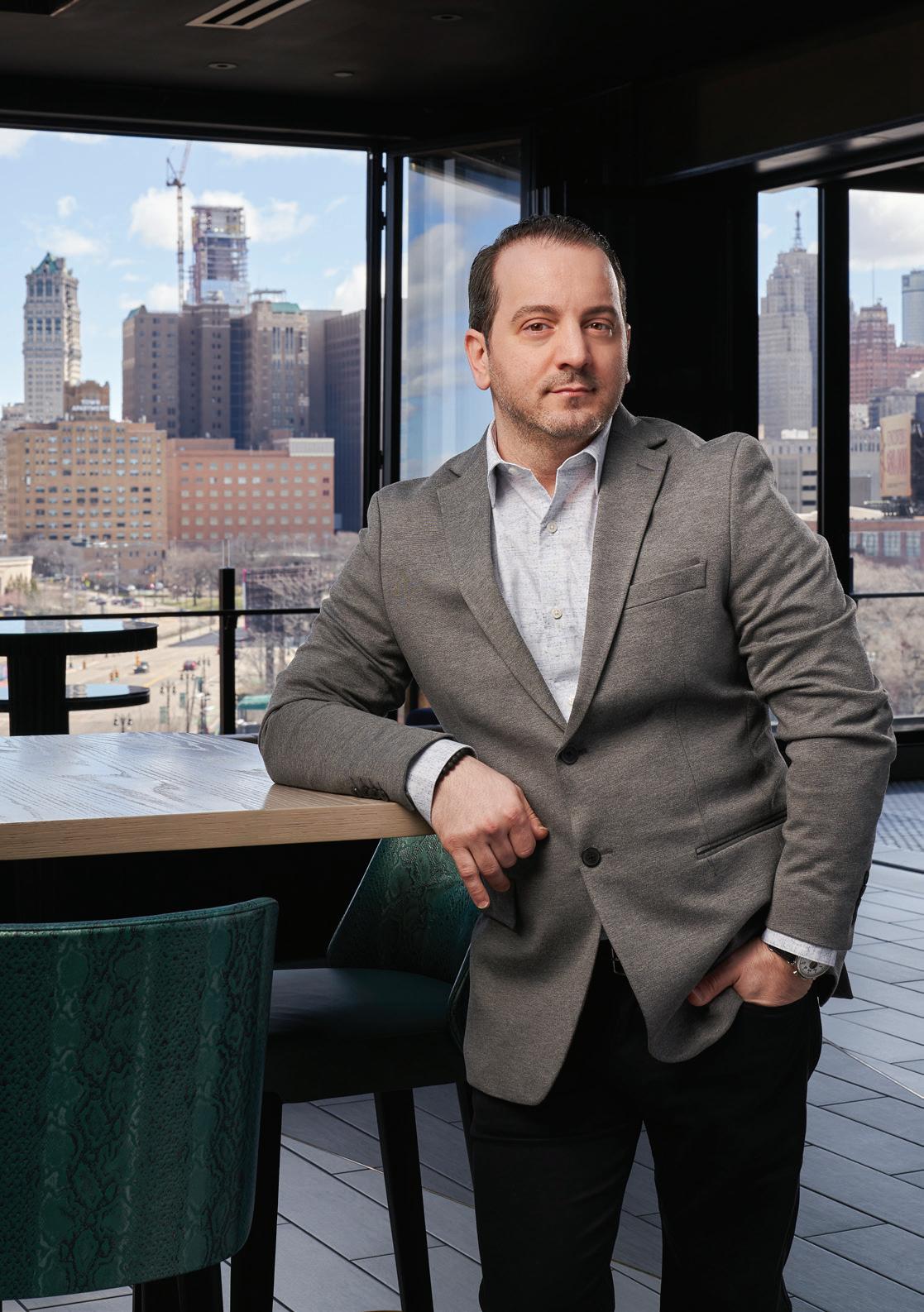

Vice President, Operations
KLA Laboratories Inc., Dearborn
Employees: 225
Revenue: $67 million
College: Wayne State University
Owner
FPAV Audio & Visual
Electronics, Shelby Township
Employees: 7
Revenue: $1.5M
College: Macomb Community College
Ateenage obsession with all things electronic has led to a $1.5 million business for Matt Vocino, owner of FPAV Audio & Visual (FPAV) Electronics in Shelby Township.
“I had an older half-brother and he would come home from college and bring his big speakers home,” Vocino recalls. “That got me interested. Since I was young, all of my birthday and holiday money went to AV stuff. My Christmas list would be this speaker or that speaker, instead of toys.”
Growing up, Vocino says his circle of friends would hang out at his house to play video games and watch movies. “I had surround sound,” he says.
That interest led to a job selling and setting up displays at Circuit City, which he and a co-worker transformed into the region’s top-selling audio department. When competitor Best Buy started its Geek Squad team of technicians and sent them out to perform house calls, Circuit City countered by sending Vocino and his partner on the road doing installations.
Then, when Circuit City began outsourcing house calls, the pair decided to start a business focused on electronics installations.
“We fought for the Circuit City contract and got that, and started doing a lot of Circuit City work in Oakland, Macomb, and Wayne counties,” Vocino recalls. “Then we picked up the Sears contract. That
was probably the bulk of our business for the first four to six years, and we’d get a private job every now and then. It just kind of grew from there.”
FPAV operated out of Vocino’s house for the first few years the company was in business. After that, he sublet office space before sharing an office with a landscaper.
“Six years ago, we moved into our own showroom in Shelby Township,” Vocino says. Last year, the business was relocated to a larger space nearby.
“It’s kind of a weird business. It’s a trade, like an electrician or a plumber, but it has a heavy retail front to it,” Vocino says.
In addition to audio visual equipment, FPAV Electronics provides networking wiring, security cameras, alarm systems, Wi-Fi, wiring for TV, and motorized window treatments.
“We do everything from basic TV mounts to crazy $150,000 residential home theaters,” says Vocino, who predicts that the future of his industry is in wholehouse automation including lighting, music, window treatment and shade control, and one-button lock-up and shut-down capabilities for a whole house.
“At my house, at dusk, the outside lights go on, the shades go to 50 percent, and the under-cabinet lights go on,” he says.
— Tim Keenan










At Kaiser Enterprise in Troy, the overall $1.5-billion business that in 1952 started out as a pollution-control company has now come full circle in circulating and controlling air, and eliminating any airborne particles that can impact paint shops, data centers, and EV battery production facilities.
BY DALE BUSS | JOSH SCOTT

General Motors had a big manufacturing problem after sales began recovering in the aftermath of the Great Recession more than a decade ago, and Bob Kaiser and his company, Gallagher-Kaiser, were there to solve it.
The automaker was sitting on promising new-product programs for major nameplates, including fresh versions of the key Chevrolet Silverado and Cadillac Escalade lines. But when it came to building or refurbishing the assembly plants where those new models would be finished, GM was finding it couldn’t count on one of its most important contractors — paint-shop builders — to stay within budget, keep their promises, and work with the automaker on improving the process.
Kaiser stepped into that breach in a major way. Gallagher-Kaiser long had been a paint-booth supplier for the Detroit Three automakers. “We used to have an adversarial relationship with the OEMs,” concedes Kaiser, CEO and owner of Gallagher-Kaiser in Troy.
Much of the bad blood stemmed from a sort of reign of terror initiated in the early 1990s by José Ignacio López de Arriortúa, General Motors’ purchasing chief at the time, whose modus operandi of beating suppliers into pricing submission was copied by other automakers. “They’d try to get the most out of you, and you out of them,” Kaiser recalls. “It was bad.”
But early in the last decade, the second-generation leader of the Kaiser family business grasped how the situation could be changed and provided a solution that Gallagher-Kaiser and GM enjoy to this day: a strategic partnership formed in 2013 that has taken paint shops off the automaker’s worry list.
During this time, GM was frustrated with the performance of some of its paint-shop suppliers in fulfilling their bids. The automaker wanted a long-term partner, and Gallagher-Kaiser already had completed the most difficult paint shops for GM, at the lowest cost, on time and safely, taking on high-risk projects and demonstrating prodigious planning to complete them.
Indeed, since the beginning of the strategic partnership, “We’ve done every paint shop in North America for GM in one way or another,” Kaiser, 67, says.
Since that time, GM has recognized Gallagher-Kaiser as a supplier of the year 11 times, out of a total of about 20,000 suppliers to the OEM, and Kaiser is one of 17 members on the company’s esteemed Supplier Council.
The latest showcase for the partnership is GM’s “Factory Zero” in Hamtramck, the plant that originally was known for its colliding assembly-line robots after it opened in 1985 but lately became the company’s first fully developed EV plant.
It produces the GMC Hummer EV pickup and SUV, and the Chevrolet Silverado electric pickup, and is slated, someday, to be the home of the Cruise Origin, the company’s planned autonomous vehicle. Factory Zero “was a big project and a difficult job, but we got it done on schedule and on budget, and during COVID-19,” Kaiser notes.
Products: Paint-finishing supplier, sheet metal fabrication, outfitter of data centers and EV battery plants, and more Companies: Gallagher-Kaiser, Universal Piping Industries, Kais-AIR, CCCI Commerce Controls, BladeRoom Data Centres, ModuleCo, Rival Insulation, Tann Corp., and Ventcon
Headquarters: Troy Revenue: $1.5B
Employees: 1,500
Owner and CEO: Robert S. (Bob) Kaiser
Forming the strategic partnership with GM also exemplified how Kaiser works: seeing opportunity, throttling into and beyond it, and coming out on the other side as a winner. Whether it’s as a national boat-racing and a sporting-clays shooting champion, in growing a highly successful Tier 1 component of Detroit’s native industry, or in making a big-stakes bet on diversifying into other industry verticals, Kaiser keeps getting the jump on rivals and beating down obstacles on his way to success.
Or, as he puts it, “Dominate, win, excel.”
For Kaiser Enterprise, winning has meant becoming the largest independent, privately owned unionized custom sheet-metal manufacturer in the United States, initially through its paint-booth business. “We used to have eight competitors, and now it’s down to just two or three of us,” Kaiser says. “We’re a survivor in this industry and we have a lot of room to grow.”
For example, Gallagher-Kaiser is building the paint shop for Volkswagen’s new $2-billion plant in South Carolina, where it will produce its Scout SUVs.
The company’s empire is growing even more through diversification into serving more industries. Altogether, Kaiser’s companies — known collectively as Kaiser Enterprise — now enjoy annual revenue totaling about $1.5 billion, up from just $70 million for Gallagher-Kaiser a mere decade ago. Kaiser Enterprise now employs some 1,500 full-time employees at 15 facilities around the continent and utilizes another 6,000 contract workers at any given time.
But winning is about more than plotting a grand strategy and executing it well. For Kaiser, it’s also about those people, and it’s about equipping them to succeed. In his view, business is a team sport.
“I want to win and dominate. To do that in a race boat, you can be the best driver in the world, but without a good piece of equipment and without the best people, you can’t win,” he says. “You can’t win in business without the best people, and if you don’t give them the best tools.”
No doubt, the “best people” for Kaiser includes his family. The third generation in family-owned companies is typically where the guidance from previous generations and interest among the youngest members often begins to fall apart — but that’s not the case with Kaiser Enterprise.
Joseph Kaiser III, Bob’s late father, founded Gallagher-Kaiser 72 years ago and built the company for decades. He retired at age 60, in 1984, when his sons bought the company. His wife, the late Marguerite, initially worked at the company, but later became a homemaker.
Both parents imbued their sons, Bob and Joseph IV, and their daughter, Jacqueline, with competitiveness. Their father was “the driving force to get it done and complete the task,” says Joseph Kaiser IV, eight years Bob’s senior, while their mother understated it. “She’d say, ‘I’ll help and wish and pray that you do well and get that contract,’ ” Joseph recalls. “And then, once we got it, she’d say, ‘Are you going to make any money on it yet?’ ”


When the auto industry scaled back during the Great Recession, Gallagher-Kaiser pivoted to HVAC projects to keep its people working at the GK Detroit Manufacturing Campus.
There were times when that was a serious question, most recently during the Great Recession of 2008 and 2009, when the Detroit Three automakers slashed capital expenditures. “(Gallagher-Kaiser was) basically close to going broke, but it was very well hidden from me,” says Robert S. Kaiser II, Bob’s son. “The company put up everything it had, and survived to make payroll and keep people employed. A lot of people would have panicked.”
Bob Kaiser says during 2008 and 2009, “We had to figure out how to stay alive. We even went to Las Vegas and did HVAC work for casinos and McCarren Airport (now Harry Reid International Airport), and at a prison and a few nightclubs. We were flexible and pivoted.”
Joseph Kaiser IV was CEO of Gallagher-Kaiser until 2014, then retired and sold his share to Bob. “Joe has been the best teacher, and my father was my mentor,” Kaiser says.
Tracy E. Roberts is a longtime executive of the company and a family confidant, having been with them for 27 years. Today he’s president and COO of Kaiser Enterprise. “I’m (Bob’s) partner in everything we do,” Roberts says. “We bounce ideas off of each other like brothers, have debates. It’s business and personal.”
He appreciates the management style his boss has developed over time. “Bob lets the entire organization do things,” Roberts says. “We’ll make decisions in 10 minutes to pivot and go do something; it’s not like a giant corporation where you have to go through layers of approvals. If it makes sense and we can put it on paper, then execute it, he allows us to do that.
“He’s smart enough to know that he doesn’t know it all, and surrounds himself with a good team and gives us the flexibility to succeed. He doesn’t micromanage things.”
A key member of the current management team who’s also family is Joseph Kaiser V, who’s 47 years old and president of Universal Piping, a major company in its own right that joined the Kaiser Enterprise umbrella via acquisition in 2010. “He’s doing a fantastic job in growing UPI,” Kaiser says of his nephew. “And there will be other opportunities for him as we continue to grow.”
Yet the father has made it clear his son is the heir apparent, and will eventually run Kaiser Enterprise. It’s an early call, Bob Kaiser concedes, and Robert II “has to prove himself as to when this will occur,” but “he’s the one that’s going to be taking over, and I’ve made that clear to everyone.” Bob Kaiser’s other offspring, Julia, has an interest in acting and manages a global real estate portfolio.
Robert II was a star hockey player at the University of Massachusetts at Amherst and had a shot at a career in the National Hockey League, but three shoulder surgeries short-circuited things. He joined Gallagher-Kaiser in 2021,
Kaiser (right), who maintains a close relationship with the International Association of Sheet Metal, Air, Rail, and Transportation Workers, speaks

and today is vice president of Kaiser Enterprise. “He’s taken his leadership skills and competitive fire from the ice to the business world,” Kaiser says. “He’s a very serious and intelligent young man, and I’ve prepared him and he listens well.”
One of Robert’s first gigs at the company was to learn how to perform the field installation of paint booths at Factory Zero, including how to deal with subcontractors. “Dad said I need to understand everyone’s daily aches and pains, and be in their shoes,” Robert II says. “He’s so adamant at putting me in every level of the business.”
The son then rotated around the company for a year, shadowing department heads, and for the past couple of years has served in sales and estimating, where he’s focusing on business development and customer relationships.
“Our mentality is to make sure each generation makes things better,” Robert II says. “My dad and my Uncle Joe took it to the next level, and I’d like to do the same thing they did. That’s the goal. Keep pushing it forward and make it more successful — but that’s when I’m ready and if I prove myself. Nothing is a guarantee in life.”
Bob Kaiser not only believes in the leadership he’s assembled around him, but also in the skill sets of the specialists he’s brought under the Kaiser Enterprise umbrella. He says they’ll provide the knowledge, technology expertise, and human-capital base for still more diversification and organic growth.
“We have more than 200 engineers who are very well-versed in air, humidity, and temperature control,” he says. “They’re the best in the world. They’re mechanical engineers, electrical engineers, conveyor engineers, and structural engineers. We have people with doctorates in computational fluid-dynamics modeling, and in-house design engineering. We use augmented reality and ghost facilities and digital twins, and within a matter of a very short time, we can show a customer what their paint shop or data center will look like.”
Having hundreds of specialists in in-house, from sheet-metal workers to plumbers, gives Kaiser Enterprise a great bullpen to pursue more diversification of its verticals.
Beyond management acumen and technical capabilities, Kaiser also takes pride in the company’s relationships with the manufacturing rank-and-file, the skilled tradespeople, and the production workers who fabricate and assemble the massively complex systems installed by his companies. “I started out at 17 years old in the shop,” he says. “I grew up with many of these people. I can walk through a shop and (I) know one-third of the workers and their wives and kids.”
One way Kaiser advocates for his employees is by making available to them an online wellness program called TLConnection, which is operated by his fiancée, Tanya Clark. Kaiser Enterprise companies are among the first to offer an instruction platform of what Clark calls a “wellness journey” that involves free weekly webinars with experts from around the world in such areas as nutrition, strength, and “mindfulness.”
Thirty years ago, Bob Kaiser was an offshore-powerboat racing champion. And, sure, he still has boats, including a doozy: a 48-foot MTI catamaran with 2,700-horsepower that clocks out at 170 mph.
But Kaiser’s days of competitive racing ended about a quarter-century ago after he hugged his little daughter, Julia, and started a world-championship race in Florida, ran out in front of the pack, and then hit a big swell of Gulf water that threatened to turn his 40-foot Cougar catamaran on its top — likely injuring pilot Kaiser and his throttleman in the process.
Kaiser’s parents owned a lakeside home in Ontario, and his family summered there. Kaiser also grew up in Grosse Pointe, plying Lake St. Clair in boats as a kid and even motoring down to Lake Erie.
“I had my first boat with a five-horsepower engine on it at 8 years old,” recalls Joseph Kaiser IV, Bob Kaiser’s older brother. “So I’d teach him how to drive it at a very early age, and we’d always wear life jackets and take safety courses.”
It wasn’t long before Bob Kaiser was pushing the limits in competitive speedboat racing. “I saw a race on Lake St. Clair and wanted to do that,” he says. After a stint driving for the Chrysler Laser team, in 1986 Kaiser started his own race team that “became a dominant force in offshore power racing.”
Over 14 years, Kaiser and his team notched more than 30 wins, including national and world championships, and he became the world speed record-holder for all boat types. He entered the sport’s hall of fame after he was done.
Although there’s a tight comparison between boat racing and auto racing — they’re both highly technical and require strength — major differences are evident, as well.
“With boat racing, you’ve got ever-changing conditions, unlike car tracks,” Kaiser explains. “You might have big seas or flat seas, you have to determine the size and depth of props, how to set up the boat with weight and ballast, and you have both a driver and a throttleman.”
Kaiser and regular throttleman Errol Lanier were “known as some of the hardest chargers in the sport’s history,” according to speedonthewater.com. Indeed, Kaiser spent several years “in a pretty wild lifestyle, while my brother took care of the business,” he says. “He held the fort down and let me do these crazy things.
“We had a lot of accidents,” Kaiser recalls. “One time we flipped over backwards and did a complete circle at 115 miles an hour and landed back on the bottom (hull). We were both thrown out of the boat and were picked up in a helicopter basket. I feared I was paralyzed. Three weeks later, I went to Bimini and back in a race boat.”
But there would be an end, soon after that ominous day in 1998 when Kaiser and throttleman Steve Curtis were participating under a Budweiser sponsorship in the world championships. Curtis “was aggressive, and coming out of Key West we hit the first wave and launched 50 or 60 feet up, and I said to myself, ‘Oh my God, I hope I don’t die today.’ I was worried because of my daughter. I raced one more time, took second in the worlds, and I stopped racing.”
— Dale BussFollowing a win at the 1988 Marathon Key Offshore Race in Florida, Kaiser, center, celebrates with his father, Joseph Kaiser III, and his throttleman, Errol Lanier.
 with Ray St. Clair of the union’s Local 292 in Troy.
with Ray St. Clair of the union’s Local 292 in Troy.
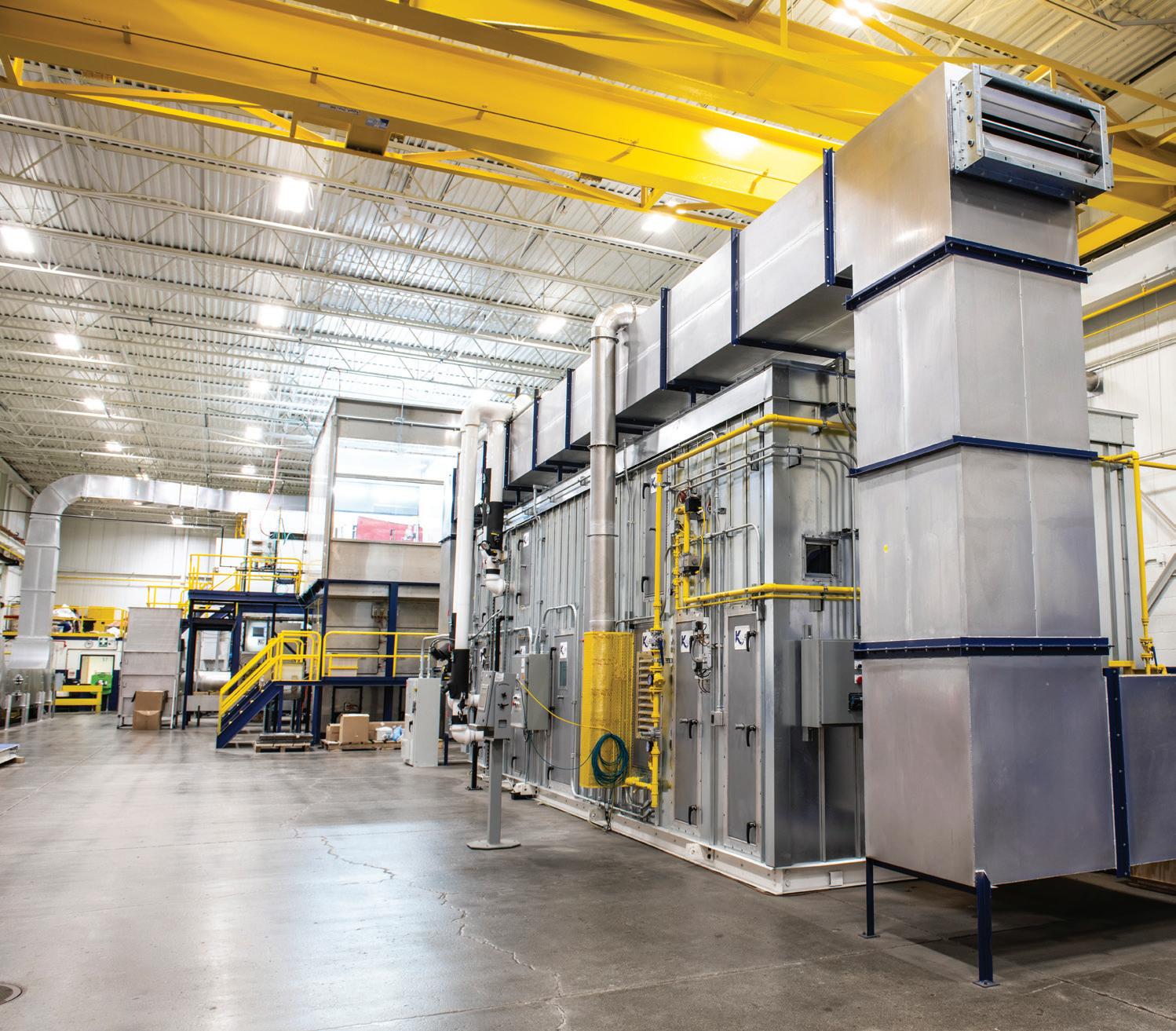

When it comes to traditional worker advocates, Roberts mainly handles dealings with the International Association of Sheet Metal, Air, Rail, and Transportation Workers union, which represents many hourly workers at Gallagher-Kaiser. “It takes transparency with unions, and we communicate extremely well with them,” says Roberts, who sits on the union’s apprenticeship-training committee in Detroit. “We’re up front. We need them to be successful, so why be confrontational?”
The two corporate leaders aren’t fazed by the militance shown by United Auto Workers President Shawn Fain in last fall’s strikes against the Detroit Three automakers, which produced double-digit pay raises in new contracts. “I try to make sure we have a non-adversarial relationship with the union, just as I encourage and insist on not having an adversarial relationship with a customer,” Kaiser says.
Kaiser’s care for his people extends in a particular way to worker safety. “It’s paramount,” Roberts says. “With our thousands of activities every day, if there’s an incident on any of our projects, or even a near-miss, (Bob) and I are notified within 30 minutes and we make sure the job is secured, the customer is secured, and those individuals are taken care of.”
Consider, building paint shops isn’t a risk-free, hazard-free environment. People can be working 200 feet in the air. Kaiser’s view is that, as human beings, every individual deserves to go home to their family safe each night. Still, some workers can be like cowboys; they’re macho and want to prove themselves. To offset this, Kaiser works hand in hand with his overall team, as well as suppliers and unions, to affect workers’ decisions in a positive way.
In a not-so-roundabout manner, Kaiser’s concern about safety is an extension of his penchant for cleanliness. “The thought pattern,” Roberts says, “is that people won’t get hurt if things aren’t sitting around on the floor.”
There’s clean, and then there’s what associates call “Bob Kaiser clean.” The absolute white-glove-proof condition of Gallagher-Kaiser’s plant along Mount Elliott Street in Detroit, for example, is evident to any visitor — and it’s clearly not just being staged for a day.
A place for everything and everything in its place goes for Kaiser personally, too.
“In Dad’s pantry, everything is labeled with label-makers and organized a specific way,” Robert II says. Clark observes: “He kind of treats his home almost like a plant. He walks through and does a punch list, and then immediately corrects what isn’t in place — in a beautiful way, not a crazy way. He wants everything functioning to the greatest of its capacity.”
Still, everything about Kaiser’s approach to management and business would go for naught if he didn’t get the big picture, the strategy, right. And in that way, Kaiser has been succeeding mightily with a massive, years-long shift of his enterprise away from auto-industry dependence and into broader arenas. It’s an approach that’s looking better and better as automakers reallocate more capital spending to comply with the industry’s government-forced transition into electric vehicles.
“When the OEMs start spending more money on batteries and EVs, it leaves less money to build new paint shops,” Kaiser says. “They’ll slow down in that area. So we must pivot and be flexible, and adapt to the new situation. A lot of times, if you don’t jump on things right away, you’re too late.”
In diversifying into supplying air-purification and climate-control systems to other industries, Kaiser Enterprise has leveraged two main things: GallagherKaiser’s expertise in handling and cleaning air and taking care of pollutants, which can be applied in lots of factory settings, and its stable of tradespeople and their transferable skills.
Major acquisitions have provided much of the fuel for growth, such as Kaiser’s purchase of Universal Piping in 2010. The move made Kaiser Enterprise one of the leaders of America’s mechanical-piping industry and took the company into verticals ranging from wastewater treatment facilities to nonindustrial businesses including hotels, schools, and hospitals.
“When we acquired UPI, they were doing probably $10 million to $15 million a year in revenue,” Kaiser says. “Now, that company is doing well over $300 million, and Gallagher-Kaiser represents only about 30 percent of their business.”
UPI just built a new, 135,000-square-foot facility in Georgetown, Ky. — the same town where Toyota has assembled vehicles such as the Camry and RAV4 since 1986. The UPI plant came about through a consolidation of two local businesses.
“We built that new facility to give UPI the wherewithal and tools to put 40 feet under hook (overhead cranes) so we can build large modular sections” of piping systems, Kaiser says. “I learned through my life to build new rather than rework existing, because in the end, you don’t get what you want otherwise. Paint shops and large installations are all about modular build. That ensures quality and minimizes time in the field for the schedule of installation for the owner. And it’s safer. Just a better quality of work. Everything is plug-in-place, as long as you put in the engineering time upfront.”
GROUND FLOOR Kaiser is familiar with every piece of heavy equipment the company owns, including a sheet manipulator (yellow) and a hydraulic press brake made by Cincinnati Inc.Taking the organic route, Kaiser created Kais-AIR in 2020 to provide design, engineering fabrication, and installation of modular industrial equipment. In 2022, Kaiser bought Commerce Controls, a Novi-based provider of turnkey controls systems in all sorts of industrial plants.
“We acquired the best controls company in the world, and suddenly we have 60 more controls engineers,” he says. Last year, Kaiser Enterprise purchased Ventcon in Allen Park, an HVAC-sheet metal specialist — it uses sheet metal to build vent ductwork.
Combining all these capabilities has made Kaiser Enterprise something of a one-stop shop for the handling of air in practically any industrial setting. Now, for instance, the company is getting contracts to outfit EV battery production plants, with the hundreds of separate dehumidification units each requires to ensure the quality of the components.
Illustrating the sheer number of assemblies required in a lithium-ion battery plant while talking in a conference room at the Mount Elliott plant, Kaiser draws a bunch of smaller boxes within a much larger box on a whiteboard. “All of this is worth hundreds of millions of dollars in a battery plant, and we’re striving to provide them for many North American facilities,” he says.
From there, Kaiser Enterprise has “picked up all this ductwork. There are 30 miles of ductwork in a battery plant, and we’re in six battery plants right now.”
The company also has tapped into the explosive wave of data-center construction across America to support the latest artificial-intelligence technologies.
“It’s a similar deal,” Kaiser says. “Also with major financial institutions. All those computers get really hot and they have to be cooled. If they go down, the financial institutions can stop. When we bought a majority interest in Ventcon, it was doing $100 million in business. We have $500 million in Ventcon’s backlog right now.”
One method Kaiser has brought to “the battery world” as it competes for business at new multi-billion-dollar facilities is to build Ventcom sheet-metal shops in smaller installations close to its customers, which cuts what often is the extreme cost of logistics for ductwork and stops the necessity of what Kaiser calls “shipping air.”
“You’ve got a load of pipes as big as this room that are just air inside,” Kaiser says, sweeping an arm across his office. “And we’re talking about a half a billion dollars of ductwork a year. That’s a lot of air.”
Kaiser Enterprise also further verticalized its capabilities last year by acquiring Ferndale-based Rival Insulation, which specializes in mechanical insulation in a variety of verticals, including automotive and heavy industrial.
As Kaiser puts it, every element of his diversification push is in some way “about air, which is what we’ve done our whole life. We’re very conscious about the fact that the company started out as a pollution-control company, and we’re going back full circle to minimize any pollution that paint shops could cause, and data centers, and battery facilities.
“We care about the environment. Our R&D focus is heavy on developing sustainable products.”
Gallagher-Kaiser’s paint-shop work has taken the company into plants in Canada as well as in Mexico, as more automakers have opened assembly plants there. And its geographic diversification continues: Gallagher-Kaiser recently opened an office in Stuttgart, Germany, to pursue paint-shop work with automakers in Europe.
“I like where we are with our footprint,” Kaiser says. “We have to be flexible and versatile, and we can go anywhere. But that doesn’t just come because you go out and buy (capabilities). You take the success of these individual corporations and put money back into them to hire more people and grow organically and increase revenues and get into different marketplaces. That’s how this has grown.”
Kaiser continues to stoke a competitive fire that provides energy to all of this. It helps that from a young age he set and met high standards, whether it’s leading and winning major speedboat races or shooting sporting clays.
“I’m motivated by competition,” he says. “We work hard and play hard. (But) I’m a victim of my own passion, because I think about business 90 percent of the time. I’m happy with the business, but I’m never satisfied. We can always improve.”

Avehicle’s paint job is a huge point of scrutiny among consumers. Modern vehicle designs that entail two tones and bright, unconventional colors make the coating process even more challenging.
So constructing and outfitting a modern paint booth in a U.S. assembly plant — that enclosed, pristine, 1-million-square-foot space where much of the car’s magic happens — is complex and typically comprises about one-quarter of the entire cost of the facility, which can cost $2 billion or more.
“A car goes into a paint shop and never sees the outside atmosphere again until it’s a really pretty car,” says Bob Kaiser, CEO of paint-shop builder Gallagher-Kaiser, part of Kaiser Enterprise in Troy. “It takes miles and miles of piping, wire, and ductwork to get it to that point.”
And, notes Kenny White, General Motors’ former paintshop manufacturing director, “there are so many levels of variation” to take into account in the construction of a paint shop, including line speed, levels of automation, production schedules, buffers and enablers, and if there will be three shifts painting vehicles. Putting a paint shop in a brownfield site versus a greenfield factory can drive up costs, and the chosen paint technology can have a financial impact, as well.
“These are 30-plus-year assets that have to serve multiple product programs” that only “start to pay for themselves over time after being amortized over several programs,” White says.
Once inside the confines of the system, the vehicle is pre-treated, “electrocoated” in a dip tank, sealed, primed, run through “base coat” and “clear coat” applications, then travels on to what is called the “finesse deck” for light repair.
One key operating technology where GallagherKaiser has excelled is known as a “scrubber,” which removes excess paint particles from the air so they don’t pollute the enclosed environment. The company offers either a dry method, using filtration to collect the particles, or a water-wash method.
“Getting it right on a consistent basis is where the magic is,” Kaiser says.
— Dale Buss
Milestones in business are magical and are becoming as rare and difficult to achieve as pulling a rabbit out of a hat. In 2020, the average lifespan of a company on Standard and Poor's 500 Index was just over 21 years, compared with 32 years in 1965.
Milestones
Here in these pages of DBusiness, you will find a number of local companies celebrating impressive milestones. These companies not only make money and are successful but also employ people, support their local communities and provide a sense of pride with not only their own employees but their clients, customers, suppliers and associates.
Success can be measured in many ways but it can only be achieved through hard work and creating a team atmosphere where everyone is working towards the same goal. Consider what Charles Gleeson II, CEO of C.E. Gleeson Contractors Inc., recently said about his company’s 100 years in the construction business.
“Our relationships are built on trust and loyalty and not just with our clients and customers but with our employees,” Gleeson II says. “The best way to be successful starts from within. You have to treat your employees as a team and share profits and successes with them. If you create that philosophy within your team then your team implements that with the client.”
Taking the organic route, Kaiser created Kais-AIR in 2020 to provide design, engineering fabrication, and installation of modular industrial equipment. In 2022, Kaiser bought Commerce Controls, a Novi-based provider of turnkey controls systems in all sorts of industrial plants.
“We acquired the best controls company in the world, and suddenly we have 60 more controls engineers,” he says. Last year, Kaiser Enterprise purchased Ventcon in Allen Park, an HVAC-sheet metal specialist — it uses sheet metal to build vent ductwork.
Combining all these capabilities has made Kaiser Enterprise something of a one-stop shop for the handling of air in practically any industrial setting. Now, for instance, the company is getting contracts to outfit EV battery production plants, with the hundreds of separate dehumidification units each requires to ensure the quality of the components.
Illustrating the sheer number of assemblies required in a lithium-ion battery plant while talking in a conference room at the Mount Elliott plant, Kaiser draws a bunch of smaller boxes within a much larger box on a whiteboard. “All of this is worth hundreds of millions of dollars in a battery plant, and we’re striving to provide them for many North American facilities,” he says.
From there, Kaiser Enterprise has “picked up all this ductwork. There are 30 miles of ductwork in a battery plant, and we’re in six battery plants right now.”
The company also has tapped into the explosive wave of data-center construction across America to support the latest artificial-intelligence technologies.
“It’s a similar deal,” Kaiser says. “Also with major financial institutions. All those computers get really hot and they have to be cooled. If they go down, the financial institutions can stop. When we bought a majority interest in Ventcon, it was doing $100 million in business. We have $500 million in Ventcon’s backlog right now.”
One method Kaiser has brought to “the battery world” as it competes for business at new multi-billion-dollar facilities is to build Ventcom sheet-metal shops in smaller installations close to its customers, which cuts what often is the extreme cost of logistics for ductwork and stops the necessity of what Kaiser calls “shipping air.”
“You’ve got a load of pipes as big as this room that are just air inside,” Kaiser says, sweeping an arm across his office. “And we’re talking about a half a billion dollars of ductwork a year. That’s a lot of air.”
Kaiser Enterprise also further verticalized its capabilities last year by acquiring Ferndale-based Rival Insulation, which specializes in mechanical insulation in a variety of verticals, including automotive and heavy industrial.
As Kaiser puts it, every element of his diversification push is in some way “about air, which is what we’ve done our whole life. We’re very conscious about the fact that the company started out as a pollution-control company, and we’re going back full circle to minimize any pollution that paint shops could cause, and data centers, and battery facilities.
“We care about the environment. Our R&D focus is heavy on developing sustainable products.”
Gallagher-Kaiser’s paint-shop work has taken the company into plants in Canada as well as in Mexico, as more automakers have opened assembly plants there. And its geographic diversification continues: Gallagher-Kaiser recently opened an office in Stuttgart, Germany, to pursue paint-shop work with automakers in Europe.
“I like where we are with our footprint,” Kaiser says. “We have to be flexible and versatile, and we can go anywhere. But that doesn’t just come because you go out and buy (capabilities). You take the success of these individual corporations and put money back into them to hire more people and grow organically and increase revenues and get into different marketplaces. That’s how this has grown.”
Kaiser continues to stoke a competitive fire that provides energy to all of this. It helps that from a young age he set and met high standards, whether it’s leading and winning major speedboat races or shooting sporting clays.
“I’m motivated by competition,” he says. “We work hard and play hard. (But) I’m a victim of my own passion, because I think about business 90 percent of the time. I’m happy with the business, but I’m never satisfied. We can always improve.”

Avehicle’s paint job is a huge point of scrutiny among consumers. Modern vehicle designs that entail two tones and bright, unconventional colors make the coating process even more challenging.
So constructing and outfitting a modern paint booth in a U.S. assembly plant — that enclosed, pristine, 1-million-square-foot space where much of the car’s magic happens — is complex and typically comprises about one-quarter of the entire cost of the facility, which can cost $2 billion or more.
“A car goes into a paint shop and never sees the outside atmosphere again until it’s a really pretty car,” says Bob Kaiser, CEO of paint-shop builder Gallagher-Kaiser, part of Kaiser Enterprise in Troy. “It takes miles and miles of piping, wire, and ductwork to get it to that point.”
And, notes Kenny White, General Motors’ former paintshop manufacturing director, “there are so many levels of variation” to take into account in the construction of a paint shop, including line speed, levels of automation, production schedules, buffers and enablers, and if there will be three shifts painting vehicles. Putting a paint shop in a brownfield site versus a greenfield factory can drive up costs, and the chosen paint technology can have a financial impact, as well.
“These are 30-plus-year assets that have to serve multiple product programs” that only “start to pay for themselves over time after being amortized over several programs,” White says.
Once inside the confines of the system, the vehicle is pre-treated, “electrocoated” in a dip tank, sealed, primed, run through “base coat” and “clear coat” applications, then travels on to what is called the “finesse deck” for light repair.
One key operating technology where GallagherKaiser has excelled is known as a “scrubber,” which removes excess paint particles from the air so they don’t pollute the enclosed environment. The company offers either a dry method, using filtration to collect the particles, or a water-wash method.
“Getting it right on a consistent basis is where the magic is,” Kaiser says.
— Dale Buss“We go the extra mile to bring real authentic Italian to the table”.
For six decades - and counting - the Rugiero family has worked hard preparing fresh, authentic Italian dishes including awardwinning pizzas, calzones, Lasagna, veal dishes, soups and, of course, their famous fresh baked bread. Everything is made the old fashion way “Fata in Casa” (in house) and the pasta at all five locations is made fresh daily. Andrea Bocelli prepared Spaghetti Carbonara in their kitchen, but nothing beats Mama Rita’s gnocchi with Rita sauce.
Antonio Francisco Rugiero Sr., a native of Calabria, Italy, came to America in 1960 and realized his version of the American Dream when he opened his own restaurant, Roman Village, in Dearborn where he met his wife Enrica that soon became his greatest asset. Their sons have established the familiar name, Antonio’s Cucina Italiana, in multiple locations and all feature authentic Italian dining combined with Rugiero family hospitality.
“The quality is in the details,” says Anthony Rugiero, also known as Antonio Jr. “We go the extra mile to bring real authentic Italian to the table”. Like a great dish of pasta, it starts with simple fresh ingredients. A business needs a simple, but effective protocol that everyone supports to achieve 60 years of success and a lot of hard work.
There is always a family member at the restaurants, including the new generation overseeing the day-to-day operations, and their extended family of 300 staff, many of whom have been part of the 60-year journey. This is quite a leap, considering the beginning when Antonio Sr. employed four people, including himself.
The Rugiero’s have been blessed over the past 60 years with the number of wonderful people that have walked through their doors to break bread with them and host many celebrations held at their restaurants. They want to thank you for being part of their journey.




Established 1964
Dearborn, Dearborn Heights, Farmington Hills, Canton, and Livonia antoniosrestaurants.com
The War Memorial, located in Grosse Pointe Farms, serves as a gathering place for southeast Michigan that honors and celebrates military veterans and supports arts and enrichment activities for the betterment of the surrounding area. Housed inside the former mansion of the Alger family, originally named The Moorings, the architectural marvel and community landmark is recognized as a Michigan State Historic Site and is listed on the National Register of Historic Places.
As The War Memorial celebrates their 75th anniversary as a community nonprofit, they are filled with a reenergized determination to be a regional driver of arts, learning, patriotism, hospitality, and connectivity.
The magnificently constructed Fred M. Alger Center, newly opened at the end of 2022, is a state-of-the-art event space with the capacity to host up to 600 guests. The floor-to-ceiling windows of the ballroom provide stunning views of Lake St. Clair and Les Braves II: At Water’s Edge.
Les Braves II: At Water’s Edge , the sculpture that adorns the back lawn, is dedicated to the D-Day Operation of WWII. This sculpture is the sister to the original work that lives on Omaha Beach in Normandy, France. The original work was made to commemorate the 60th anniversary of the mission.
Outside of the veteran programs and celebrations, The War Memorial also hosts live music and culture-related events, and classes for adults and children to learn new skills and make lasting memories.
The facility boasts multiple different sized event spaces to host private, public, and corporate events in both the house and the Fred M. Alger Center.



Maria Miller President & CEO
Nikki Charbonneau COO
Leah Celebi Vice President of Community Engagement and Programming

Established 1949
32 Lake Shore Drive Grosse Pointe Farms, MI 48236 warmemorial.org
Kelly Oliver Senior Director of Development
Jennifer Sutton Director of Public Programs and Special Events
Brett Pulte Director of Marketing and Communications
C.E. Gleeson Constructors Inc. was founded in 1924 by Clarence M. Gleeson, who emigrated from Canada as a mason contractor. One hundred years later, the company has constructed over 50 million square feet with over $2 billion in contracted projects.
From humble beginnings in Michigan to establishing a national presence, the company’s success has been shaped by the dedication of an amazing team, the support of dedicated and professional partners, and the trust of their valued clients.
Charles E. Gleeson II, President/CEO of C.E. Gleeson Constructors Inc., is extremely proud that his company is a fourth generation, family-owned general contractor, and construction manager whose focus has always been client-driven.
“When we started out our backyard was about 30-60 miles and now it’s 39 states and still growing,” says Gleeson II. “The keys have always been constant communication, building strong relationships that last, and providing quality results that add to an already strong and respected reputation in the industry. You are only as good as your last job.”
C.E. Gleeson Constructors Inc. draw upon their rich heritage of old-school integrity, along with cutting-edge innovation in materials, technologies, processes, and methods, to meet 21st Century building challenges.
“We are part of a team and it’s important to create a team that has the same high expectations and client-driven philosophy that we have,” says Gleeson II. “We only use the best sub-contractors, people we can trust and know as part of our team. We have the ability to create great relationships with end-users.”
The company’s long list of projects includes over 100 Walgreens and more than 150 new



fitness centers for LA Fitness along with numerous senior living facilities, logistics centers and much more.
When you own a family-owned construction business it’s a 24-hour, sevenday a week commitment, and it’s that availability and dedication that is a big part of building those lasting relationships that leads to 100 years in business.
“That success is largely due to the diligence and expertise that our Vice President of Operations Brad Baker brings to the forefront,” said Gleeson II. “Brad’s strategic planning and project oversight are all integral to the continuity of our company’s focus and goals.” The company remains on a solid path towards another 100 years.
Gleeson II has three boys and a daughter and wanted each one to work somewhere else before they joined the family business.

“It’s an important aspect in growth and learning,” he says. “They learn other skills and can bring those here if they choose to come work here.”
Gleeson’s eldest son, Charles III, has accomplished exactly that following a sevenyear tenure at Cisco Systems. He currently holds the position of Director of Business Development, where he immerses himself in all facets of the construction industry, ranging from pouring concrete to various departments within the company. C.E. Gleeson Constructors Inc., is headquartered in Troy, MI with regional offices in Austin, Texas; Charlotte, NC; and Delray Beach, FL.
“To be successful in life and in business, it isn’t about ego or the profits, it’s about the relationships you make and the loyalty, trust and the respect you earn in creating those relationships,” Gleeson says.

Established 1924
984 Livernois Road
Troy, MI 48083
248-647-5500
gleesonconstructors.com
Charles E Gleeson II President/CEO
Brad
Dan




One-of-a-kind networking opportunities and compelling business content across a wide range of industries and topics await you at the DBusiness Breakfast Series.
DBusiness magazine’s event series are bi-monthly panel discussions and award shows.
2023 topics presented have included: Top Corporate Culture Awards, Commercial Real Estate Awards, 30 in Their Thirties Award Show and Powered by Women.
May 21st, 2024 30 in Their Thirties
August 1st, 2024 Powered by Women
November 1st, 2024
Commercial Real Estate Awards
Submit your nominations May 6th - July 1st







For more information and event tickets:












To suggest a restaurant in Northern Michigan for our annual list, email rjking@dbusiness.com.
NOMAD
Located on the waterfront in Bay Harbor, NOMAD o ers a vibrant atmosphere that pairs well with its sharable plates, evolving wine list, and house cocktails.
795 Front St., Bay Harbor, 49770 231-881-9090 nomadbayharbor.com
D Mon.-Sun. 25-56
VINTAGE CHOPHOUSE & WINE BAR
Welcoming, stately, and rich in history, Vintage Chophouse & Wine Bar embodies the charm of the classic all-American steakhouse, complemented by elements of an upscale lounge. 3600 Village Harbor Dr., Bay Harbor, 49770 844-717-2072 innatbayharbor.com
L & D Mon.-Sun. 27-80
CORNER BISTRO
Enjoy lounging in the intimate bar area, the up-front Bistro seating, or on the front porch. 102 N. Bridge St., Bellaire, 49615 231-409-7088 cornerbistrobellaire.com
D; Open every day but Tue. 16-38
TOONIE’S FISH & STEAKHOUSE
A casual dining atmosphere where no one leaves hungry.
216 N. Bridge St., Bellaire, 49615 231-533-8513 tooniesfishandsteakhouse.com
B, L & D Mon.-Sat. 10-27
BELLA VITA
The goal at Bella Vita is to provide guests with a true dining experience, from exceptional service and delicious food to a friendly and relaxed atmosphere.
2911 Boyne City Rd., Boyne City, 49712 231-582-3341 bellavitaboyne.com D, Seasonal 25-45
CAFE SANTÉ
A casual, European-style bistro serving “The Classics” simply and with flair.
1 Water St., Ste. 100, Boyne City, 49712 231-582-8800 magnumhospitality.com
L & D Mon.-Sun. 20-27
PROVISION LOUNGE
The Lounge is an adult-centric bar o ering curated wine by certified wine specialists.
123 Water St., Boyne City, 49712 231-582-2151 provisionsbc.com
D Tue.-Sat. 26-36
EVERETT’S
Everett’s is named after Everett Kircher, founder of Boyne Resorts. Choose from a menu of steaks, seafood, pasta, sandwiches, burgers, salads, and more.
1 Boyne Mountain Rd., Boyne Falls, 49713
231-549-7959 boynemountain.comdiningeveretts D Mon.-Sun. 22-52
FORTY ACRES TAVERN
Guests are invited to stop in, quench their thirst, and stick around until they’ve had their fill of food, spirits, and 40-acres-worth of fun.
1 Boyne Mountain Rd., Boyne Falls, 49713 231-549-7270
boynemountain.comdiningforty-acres-tavern L & D Mon.-Sun. 36-46
DAM SITE INN
One of the many charms of dining here is the spectacular view of the north country at its best. Sta strives to maintain the excellence and grace of fine dining.
6705 Woodland Rd., Brutus, 49716 231-539-8851 damsiteinn.com
D Tue.-Sun., Seasonal 21-70
TROVATO
Trovato is more than just a place to eat; it’s a destination for food lovers and anyone who appreciates a great dining experience. 7688 Maple River Rd., Brutus, 49716 231-529-4653 trovatohr.com
D, Seasonal 24-53
ARGONNE HOUSE
The Argonne House is a full-service restaurant
where one can walk in a stranger and leave as friends.
11929 Boyne City Rd., Charlevoix, 49720 231-547-9331 argonnehouse.com
D Wed.-Sat. 24-44
GREY GABLES
Sta is dedicated to making every experience guests have a memorable one, whether they’re dining in or enjoying a catered event. 308 Belvedere Ave., Charlevoix, 49720 231-547-9261 greygablesinn.com
D Tue.-Sat. 26-62
STAFFORD’S WEATHERVANE RESTAURANT
Sta ord’s Weathervane Restaurant o ers signature and regional cuisine in a relaxed atmosphere and is true waterfront dining, nestled along the busy Pine River Channel in downtown Charlevoix.
106 Pine River Lane, Charlevoix, 49720 231-547-4311 sta ordsweathervane.com
D Tue.-Sat. 21-50
TERRY’S
Terry’s o ers excellent full-course dinners in a warm, casual dining atmosphere. 101 Antrim St., Charlevoix, 49720 231-547-2799 terrysofcharlevoix.com
D, Closed Tue. 36-68
HACK-MA-TACK INN
The Hack-Ma-Tack Inn is a fine dining restaurant located on the Cheboygan River right at the mouth of beautiful Mullett Lake. 8131 Beebe Rd., Cheboygan, 49721 231-625-2919 hackmatackinn.com
D Tue.-Sun. 29-60
LEGS INN
Housemade Polish cuisine is the specialty, but a variety of American dishes including fresh, locally caught Great Lakes whitefish offerings also can be found on the menu.
6425 North Lake Shore Dr., Cross Village, 49723 231-526-2281 legsinn.com
L & D Mon.-Sun., Seasonal 20-40
PEARL’S NEW ORLEANS KITCHEN
Pearl’s offers authentic and enduring Southern specialties like etouffée, jambalaya, and fried green tomatoes, alongside crawfish, shrimp, and other fresh seafood.
617 Ames St., Elk Rapids, 49629 231-264-0530 magnumhospitality.compearls
L & D Mon.-Sun. 15-30
BENNETHUM’S NORTHERN INN
Rustic refined dining, featuring consistent quality and variety. From unique daily features to signature entrées and an upscale pub fare menu, there truly is something for everyone.
3917 Old U.S. 27 South, Gaylord, 49735 989-732-9288 bennethums.com
D Tue.-Sat. 30-70
LEGENDS ON THE HILL
This cozy hilltop lodge with incredible views serves American classics in a relaxed atmosphere. The service is impeccable.
625 Resort Blvd., Ste. A, Gaylord, 49735
855-337-3110 treetops.comlegends-on-the-hill
B, L & D, Seasonal 15-26
BLU
European techniques fused with local ingredients and the finest from afar influence daily changing menus with an emphasis on the products, simplicity, and flavor.
5705 South Lake, Glen Arbor, 49636
231-334-2530 glenarborblu.com
D Tue.-Sat., Seasonal 44-63
LA BECASSE
La Becasse offers French classics, an encyclopedic wine list, craft cocktails, locally sourced produce and provisions, and friendly and knowledgeable staff.
9001 S. Dunns Farm Rd., Maple City, 49664 231-334-3944 restaurantlabecasse.com
D Tue.-Sat. 32-55
GATES AU SABLE LODGE
The restaurant at Gates Lodge serves breakfast, lunch, and dinner in a casual setting beside the Au Sable River.
STAFFORD’S PIER RESTAURANT, HARBOR SPRINGS
471 Stephan Bridge Rd., Grayling, 49738 989-348–8462 gateslodge.com
B, L & D Mon.-Sun. 24-32
CROW’S NEST
Locally sourced produce and the freshest ingredients means food that’s exceptional in taste. 4601 N. State Rd., Harbor Springs, 49740 231-526-6011 crowsnest-harborsprings.com
D Thu.-Sat. 24-48
NEW YORK RESTAURANT
The New York Restaurant in downtown Harbor Springs offers eclectic cuisine in a comfortable setting, overlooking Little Traverse Bay’s waterfront.
101 State St., Harbor Springs, 49740 231-526-1904 thenewyork.com
D Wed.-Sun. 22-48
PAPER STATION BISTRO
Bistro dining in Harbor Springs, serving lunch and dinner.
145 E. Main St., Harbor Springs, 49740 231-242-4680 paperstationbistro.com
L & D Mon.-Sun. 25-41
STAFFORD’S PIER RESTAURANT
A tribute to the maritime heritage of beautiful Harbor Springs, Stafford’s Pier Restaurant offers true waterfront dining.
102 E. Bay St., Harbor Springs, 49740 231-526-6201 staffordspier.com
D, Closed Wed. & Sun. 26-56
MICHAEL’S TAVERN & STEAKHOUSE
Michael’s Tavern & Steakhouse is a go-to destination for delicious food and a warm, welcoming atmosphere in Indian River.
4653 S Straits Hwy., Indian River, 49749 231-238-2137 michaelstavernandsteakhouse
D Tue.-Sat. 24-38
VIVIO’S
Vivio’s Northwoods Inn Restaurant is famous across northern Michigan for its pizza, pasta, and salads.
4531 S. Straits Hwy., Indian River, 49749 231-238-9471 viviosfood.com
D Thu.-Sun. 23-46
THE RIVERSIDE INN
Delicious seasonal fare, an eclectic wine list, and excellent service all overlooking the picturesque Leland River.
302 River St., Leland, 49654 231-256-9971 theriversideinn.com
D Thu.-Sun. 30-50
1852 GRILL ROOM
Enjoy fine dining on Mackinac Island at the 1852 Grill Room, a casually sophisticated restaurant with first-class selections and a romantic ambience. Inside Island House Hotel, 6966 Main St.,Mackinac Island, 49757 906-847-7222 1852grillroom.com
B, L & D, Seasonal 28-125


CARRIAGE HOUSE
Discover Mackinac Island’s most exceptional waterfront dining experience.
7485 Main St., Mackinac Island, 49757 906-847-3321 carriagehousemackinac.com
L & D, Seasonal 40-79
CHIANTI
A destination for foodies and wine lovers. One won’t find another culinary adventure like Chianti on Mackinac Island or in northern Michigan. One Lakeshore Dr., Mackinac Island, 49757 906-847-3007 missionpoint.com
D, Seasonal 2024 menus not posted
GRAND HOTEL (MAIN DINING ROOM)
The main dining room offers one of the most picturesque dining experiences in an elegant setting for breakfasts, lunches, and formal dinners.
Mackinac Island, 49757
906-847-3331 grandhotel.com
B, L & D, Seasonal 25-50
ICE HOUSE BBQ
Indulge in Ice House BBQ’s selection of classic home-style smoked barbecue favorites and stone-fired pizza, all while basking in the ambience of the beautiful hideaway garden.
Behind Island House Hotel, 6966 Main St., Mackinac Island, 49757 906-847-7223 icehousemackinac.com
L & D Mon.-Sun., Seasonal 18-34
JOCKEY CLUB AT GRAND STAND
With welcoming and inclusive hospitality, the Jockey Club is a gathering place for all; families with kids can feel just as comfortable as a couple on a date or a group of colleagues gathering by the bar.
1 Grand Ave., Mackinac Island, 49757 906-847-9212 grandhotel.com
L & D, Seasonal 28-39
MARY’S BISTRO
Mary’s is a downtown favorite, featuring homestyle cuisine and draft craft beer and cocktails. It’s one of the best places to eat on Mackinac Island.
7463 Main St., Mackinac Island, 49757 906-847-9911 mackinacmarys.com
L & D, Seasonal 28-41
PINK PONY
The Pink Pony is said to be the best bar and restaurant on Mackinac Island. Thrillist has voted it Michigan’s most iconic bar and grill. 7221 Main St., Ste. 103, Mackinac Island, 49757 800-241-3341 pinkponymackinac.com
B, L & D Mon.-Sun., Seasonal 28-47
SEABISCUIT CAFÉ
Delicious food and creative cocktails. Seabiscuit Café is one of the most popular downtown restaurants on Mackinac Island. Breakfast, lunch, and dinner.
7337 Main St., Mackinac Island, 49757 906-847-3611 seabiscuitcafe.com
B, L & D, Seasonal 26-37
WOODS RESTAURANT
Woods Restaurant offers a unique Mackinac Island dining experience and is just a short, scenic horse-drawn carriage ride into the island’s wooded interior. 8655 Cudahy Circle, Mackinac Island, 49757 906-847-3699 grandhotel.com
L & D Mon.-Sun., Seasonal 42-75
TRATTORIA FUNISTRADA
Nestled in ‘Burdickville’ on the east side of Big Glen Lake, the building is over 90 years old and has enjoyed a history of being a popular neighborhood gathering place.
4566 W. MacFarlane Rd., Maple City, 49664 231-334-3900 trattoria-funistrada.com
D, Tue.-Sat. 28-43
FISCHER’S HAPPY HOUR TAVERN
Fischer’s Happy Hour Tavern has been family-owned and operated since 1971 and is a third-generation restaurant. 7100 N. Manitou Trail, Northport, 49670 231-386-9923 fischershappyhour.com
Mon.-Wed. 24-MKP
DOUGLAS LAKE BAR & STEAKHOUSE
The Douglas Lake Bar & Steakhouse, known to locals as the “DLB,” has a rich history of providing great food and service in a rustic log building overlooking Douglas Lake. 11001 Douglas Lake Rd., Pellston, 49769 231-539-8588
douglaslakebarandsteakhouse.com
Seasonal 25-48
1911 RESTAURANT
From a quiet location atop a bluff overlooking Little Traverse Bay in Petoskey, the 1911 Restaurant offers casual fine dining to the public year-round. 1549 Glendale Ave., Petoskey, 49770 231-347-2410 1911restaurant.com
Wed.-Sat. 30-49
BEACON BISTRO
Dinner consists of high-quality steaks, pasta, salads, proteins, and creative burgers. 319 Bay St., Petoskey, 49770 231-489-7999 beacon-petoskey.com
L & D Mon.-Sun. 31-50
CHANDLERS
Chandler’s has three dining areas for guests to enjoy: the main dining Room, which includes the bar; the patio, available in warmer months; and Symons wine cellar.

215 12 Howard St., Petoskey, 49770 231- 347-2981 chandlersarestaurant.com
L & D Mon.-Sun. 43-59
PALETTE BISTRO
A warm, double-decker cafe with bay views, serving gourmet-style Mediterranean fare and wine.
321 Bay St., Petoskey, 49770 231-348-3321 palettebistropetoskey.com
L & D Mon.-Sun. 24-49
POUR KITCHEN & BAR
An eclectic menu with worldly flavors, made from scratch daily.
422 E. Mitchell St., Petoskey, 49970 231-881-9800 pourpetoskey.com
D Mon.-Sun. 20-56
SPRING & PORTER
Indulge in an unforgettable dining experience at Spring & Porter, where staff blends the artistry of new American cuisine with the warmth of its charming locale.
887 Spring St., Petoskey, 49970 231-347-1440 springandporter.com
B, L & D Mon.-Sun. 39-55
MARTHA’S LEELANAU TABLE
A charming spot serving scratch-made regional specialties with European accents, plus beer and wine.
413 N. St. Joseph, Suttons Bay, 49682 231-271-2344 marthasleelanautable.com
D Thu.-Mon. 32-45
WREN
Located in the heart of Suttons Bay, Wren offers a small seasonal menu with a farm-to-table approach, served in a casual atmosphere.
303 N. St. Joseph St., Suttons Bay, 49682, 231-271-1175 wrensuttonsbay.com
D Tue.-Sat. 30-50
AMICAL
Located in the heart of downtown Traverse City, Amical has been offering eclectic European cuisine to patrons since 1994.
229 E. Front St., Traverse City, 49684 231-941-8888 amical.com Mon.-Sun. 32-59
ARTISAN RESTAURANT
Daily menus feature fresh and in-season ingredients sourced from local and regional vendors. 615 E. Front St., Traverse City, 49686 231-421-2150 artisantc.com
D Mon.-Sun. 25-95
BOATHOUSE RESTAURANT
Nestled on the shores of beautiful Bowers Harbor, the Boathouse takes full advantage of its delightful view of the docks and bay with wideopen windows and a summer deck. 14039 Peninsula Dr., Traverse City, 49686 231-223-4030 boathouseonwestbay.com
D Tue.-Sun. 32-85

COOKS’ HOUSE
A Traverse City food destination, Cooks’ House is built on the bounty of locally grown and foraged foods, and offers a quality experience. In addition to the menu, there are five-cource and seven-course tasting menus.
115 Wellington St., Traverse City, 49686 231-946-8700 cookshousetc.com
L & D Tue.-Sun. 32-34
FARM CLUB
Farm Club is a farm, restaurant, brewery, and marketplace nestled in Leelanau County. 10051 Lake Leelanau Dr., Traverse City, 49684 231-252-3079 farmclubtc.com
L & D Wed.-Sun. 18-32
MODERN BIRD
Modern Bird is a seasonal American restaurant by Chefs Andy Elliott and Emily Stewart. 541 W. Front St., Traverse City, 49684 231-421-5046 modernbirdtc.com
D Tue.-Sat. 21-63
PEPE NERO
An upscale restaurant and lounge with swanky decor serving Southern Italian cuisine in a former chapel.
700 Cottageview Dr., Traverse City, 49684 231-929-1960 pepenerotc.com
D Tue.-Sat. 28-58

RED GINGER
This upscale, chef-owned spot offers small plates of light Pan-Asian cuisine and signature cocktails.
237 E. Front St., Traverse City, 49684 231-944-1733 eatatginger.com
D Tue.-Sat. 32-55
SLATE
A relaxed choice spotlighting artful plates of traditional Italian fare, plus house-infused vodkas.
250 E. Front St., Traverse City, 49684 231-421-5912 slatetc.com
D Wed.-Sat. 24-52
TRATTORIA STELLA
Established in 2004 in The Village at Grand Traverse Commons, Trattoria Stella is a multiaward-winning Italian restaurant with an emphasis on authenticity.
830 Cottageview Dr., Ste. G01, Traverse City, 49684 231-929-8989 stellatc.com
D Wed.-Mon. 26-46
BARREL BACK
An airy, contemporary restaurant and bar featuring a new American menu and views of Walloon Lake.
4069 M-75, Walloon Lake, 49796 231-535-6000 barrel-back.com
B, L & D Mon.-Sun. 21-49
WALLOON LAKE INN
The Inn’s innovative menu borrows influence from local ingredients and the finest cuisines, then adds creative twists and distinct seasonal offerings.
4178 West St., Walloon Lake, 49796 231-535-2999 walloonlakeinn.com
D Mon.-Sun. 33-60
A longtime engineer at General Motors, Tony Posawatz today is leading Fermata Energy, which o ers a platform that both charges and discharges EV batteries.
BY TOM MURRAY | NICK HAGENIf anyone was destined from birth to end up pursuing a career as a “car guy,” look no further than Tony Posawatz, CEO of Fermata Energy.
“My folks came over to this country as immigrants from Austria,” he says. “ ey met on a boat to the United States in 1955. Dad was 20, Mom (was) 18. ey both had relatives in the Detroit area. My father was a skilled tradesman — the auto industry was ripe with opportunities — and he worked for Fisher Body and General Motors.”
e family ended up settling in Warren.
Posawatz was the rst in the family to be born in the United States, at what used to be called Bon Secours Hospital in Grosse Pointe.
“My family’s home was on Fina Drive in Warren, and I was outdoors all the time, playing all sports imaginable,” he says. “I have the knee surgeries to prove it. But that’s what we did back then, from season to season. I was one of the few soccer players back in that time frame of the 1970s and ’80s; as the son of an immigrant, that’s what my father taught me.”
Soccer wasn’t the only thing young Tony learned from his father.
“I just fell in love with the auto industry,” he says. “What attracted me to it in general was how unique it was, providing you with freedom and independence. And coming from modest means, all the cars we had were used. So they broke down a lot, and I had to learn how to keep them going so I could experience cruising Gratiot or Woodward, which was the culture and lifestyle that we embraced.”
Posawatz attended Woods-Tower High School in Warren, and when the time came to choose a college, there was no decision to be made.
“I had a full ride to Wayne State University,” he says. “ ey had a great automotive program. I had a number of other scholarships away from Detroit, but my father had kidney disease and I was a donor candidate, so I wanted to be close by.”
Posawatz attended Wayne State through GM’s Scholar & Engineering Intern program. “I worked two summers for GM’s Truck & Bus Group,” he adds. “It was a great experience for someone who was destined to be a car/truck guy.”
After earning a bachelor’s degree in mechanical engineering, he was selected for the GM Graduate Fellowship.


“ ey would take promising young professionals and pay for the entirety of their business school experience — tuition, computers, everything,” he explains. “And I got half my salary. ey don’t do it anymore.”
While Posawatz stayed close to home to attend college, business school was a di erent story. His father’s successful kidney transplant gave him the freedom to explore options far beyond his hometown.
“I was very fortunate to get into every business school I applied to,” he says. “I visited Harvard University, but I wasn’t sure I could trust a lot of the people I’d be going to school with, you know? And I was drawn to the Tuck School at Dartmouth because I felt (that) for my development, I needed a di erent experience.
“After growing up and spending all my time in the Midwest, I wanted something that was very di erent from what I would experience in being part of a business in a big city. I selected Dartmouth because it’s the oldest graduate business school in the world. Smaller, very team-oriented, not cutthroat at all. I had a wonderful experience there.”
When he returned home with his MBA, Posawatz had a life-changing conversation with his father.
“I was beginning my career in a white-collar, salaried environment,” he says. “He was an hourly union guy, so we had some interesting discussions and debates. To his credit, my dad said, ‘You’ve never really spent a lot of time working in a plant.’
“He told me, ‘If you’re going be a player in the car business, it’s important to see how (vehicles are) built.’
And so my job, after coming back from Dartmouth College with a fancy Ivy League MBA, was a production foreman in the plant — and I just loved it.”
Posawatz eagerly immersed himself in all aspects of the job. He started as a general supervisor and became an area manager at what was Pontiac East Assembly, which produced GM pickup trucks.
“I didn’t just have production responsibility in that role,” he relays. “I had tooling, I had maintenance and material, and it gave me the rst sense and feel of what it was like to run my own business, albeit part of a bigger business.
“At the end of the day, you knew you built so many vehicles out of your department, you had 50 or so people working for you, and you dealt hands-on with real-world problems, whether they (were) problems of engineering, mechanics and physics, or psychological problems, because a couple of your operators came in late or half-drunk.”
Bill Krzisnik, a longtime friend and GM executive who rst crossed paths with Posawatz in 1981 at the Pontiac plant, says his colleague was “Uncanny with his ability to select the right team members, and then also motivate them. Just a straight-shooter, a highintegrity guy, and a great communicator.”
Posawatz’s career at GM took o from there as he continued to, in his words, “realize a lot of cross-functional experiences” within the company, which was atypical for most ambitious executives. “Usually they want you to specialize in nance or purchasing, or engineering, manufacturing, and marketing.”
Posawatz did manage to move around, even getting some experience in GM’s corporate nance department before he was chosen to help manage the full-size truck vehicle line.
“ e whole thing was a Fortune 25 company by itself,” he says. “It was Tahoes, Silverados, Suburbans, Yukons, and Escalades — the lifeblood of GM that, frankly, has carried the company for years. And we had a lot of success.”
Posawatz and his team went on to develop the Avalanche, a hybrid between the Suburban SUV and Silverado pickup truck, which won Motor Trend’s Truck of the Year honors and ushered in the era of four-door, short-box pickup trucks, which is still a predominant model today.
“I still laugh when I remember what the Chevy Truck guy told me at the time,” Posawatz recalls. “ ‘A short-box, four-door pickup will never sell.’ Today it’s the only version they have.”
Posawatz was already established as one of GM’s most accomplished executives when the Prius was being produced and marketed by Toyota as “the car for the 21st century.” at prompted a visceral response from GM’s vice chairman, Bob Lutz.
“Bob said it’s an e cient appliance, but it’s not a great car, and they’re getting all this credit,” Posawatz recalls. “And the leadership of the company said, ‘We need to do something.’ Bob tapped me in mid-2006, and by the Detroit Auto Show that January we had developed a concept car for the Volt, which gave you 40 to 50 miles of range — enough for everyone’s usual daily drive.
“And when you went on vacation or a long road trip, you’d use the gas tank. We responded to a need with a fantastic team and got it production-approved, which was a great achievement, and it won the Motor Trend Car of the Year.”
But the good times didn’t last, and in 2009 GM found itself in bankruptcy.
“I worked with the Obama Auto Task Force and others to provide brie ngs on GM’s technology in the Volt because they thought the Volt was a reason to save GM,” he says.
e company survived, and Posawatz retired from the automaker in July 2012 after 30-plus years with the company.
“A whole new team came in,” he says, “and there was a question about whether we should be doing any plug-in or electri ed vehicles.”
at wasn’t happy news for the innovator who already was widely known as “the godfather of EVs,” although the accolade makes Posawatz uncomfortable to this day.
“I’m not sure that’s accurate,” he demurs, “but I did coin the term ‘range anxiety,’ which is still used all the time now.”
A month after leaving GM, Posawatz had a shortlived stint as CEO of Fisker Automotive, a California-based company making an early iteration of a luxury plug-in hybrid electric vehicle. He also helmed an automotive and technology innovation consulting
Fermata Energy ‘s V2X bidirectional platform both charges and discharges an EV battery, creating revenue opportunities.
company, and at one time served on as many as seven di erent corporate boards.



Last July, after serving for 10 years as an adviser, he was named CEO of Fermata Energy. Headquartered in Charlottesville, Va., the company’s V2X bidirectional platform both charges and discharges an EV battery, which not only creates revenue opportunities, but also more sources of resiliency for the grid.
“We have an auto industry that’s been reliant forever on internal combustion engines and on oil and gas,” Posawatz says. “We know that’s not the future. e idea of making money for customers when their EVs were parked was a compelling idea to pursue.
“Now we have this electric vehicle technology, with a really high-end battery or energy storage system. But how often do most people drive their cars? Maybe 5 percent of the time? So that expensive asset sits there 95 percent of the time being unused.”
When the battery in the car isn’t being used to drive it, Posawatz and his team at Fermata want to return the dormant energy to the grid.
“It’s like an Airbnb,” he says. “Instead of a home, you have this asset of energy storage, and when it’s not being used, you rent it out with minimal wear and tear. All those cars sitting there could be plugged into bidirectional chargers, to collect that energy and then deploy it when it makes the most economic sense.”
As part of the o erings, “We have a software platform that tells you when is the best time to discharge your vehicle and can make the most money. We’re














talking about thousands of dollars a year for most any customer. at’s like your car payment, while your car sits there parked, making money.”
Listening to Posawatz and hearing his passion for this new endeavor, it’s hard to believe he’s a grizzled 40-year veteran of the car business — but it’s not in the least bit surprising to his old pal, Bill Krzisnik.
“He’s been talking about this vehicle-to-grid idea for years, and his enthusiasm for anything he works on is contagious,” Krzisnik says. “When we were working together at GM and times got tough with whatever innovation we were working on, Tony would be adamant that we could get there. And we did, and we accomplished his vision. To this day, people call me up and say they’d go back to work for Tony.”
Posawatz shrugs o the praise, saying, “I’m going to turn 64 in April, and when you get to be my age, if I can help a little bit to make things better for generations to come, that’s pretty important to me.”
He pauses brie y, then adds, “My birthday is April 22, which is Earth Day, and the media has always gotten a kick out of that. ‘No wonder you’re doing what you’re doing,’ they say.
“And I always tell them: Hey, if you can’t remember how to pronounce my name, it’s Posawatz. Like kilowatts.”






















A multifaceted culinary and educational foundation in Center Line trains at-risk young adults to be self-sustaining in the business world.
BY R.J. KING | REBECCA SIMONOVAlongtime executive chef and educator, Mark Prentiss always wanted to open a restaurant operated by young adults with special needs. It helped that his wife, Deborah, was a high school teacher who understood how the public education system works.
Taking the plunge in 2012, the couple, over time, established a foundation, applied for and received a $500,000 state grant, and acquired a former school building and grounds in Center Line, which they converted into a multifaceted center for post-high school academics, work skills training, food production, and a community mental health program.
Welcome to Rising Stars Academy, a postsecondary charter school that includes a coffee shop called Gather + Grounds, the Donald Campbell Knights of Columbus Bakery, a wood shop, a commissary, a garden, and an educational hub dedicated to providing a path to sustainable independence for at-risk and underserved students with intellectual and developmental disabilities.
Initially a culinary school that began operations in 2013, the academy, which operates as its own school district, has since expanded to provide workforce readiness-based skills in areas such as sports arenas, restaurants, automotive dealerships, hospitals, and dentist offices. Among the local job providers are Henry Ford Health, Crest Ford, TACOM, The Apparatus Room, Little Caesars Arena, Comerica Park, Grey Ghost, Green Dot Stables, and Skowronski Dental.
“While I was working at restaurants, I likened myself to the character Bubba in the movie ‘Forrest Gump,’ ” says Prentiss, co-founder and president of the RSA Foundation. “As you may recall, Bubba knew everything about the shrimping business and asked Forrest to become his first mate.”

In the fictional movie, based on a novel by the same name, Bubba dies while serving in the Vietnam War before he can fulfill his dream. Following his military discharge, Forrest Gump promptly sets up a shrimping business in Louisiana. At first the company struggles, but when a hurricane comes through and wipes out the competition, the company thrives.
“It’s the same spirit of adventure and sustainability you see in the movie that we bring to the young adults we work with,” Prentiss says. “We found they mostly lack social skills, but they have a high school certificate of completion. Our young adults are between 18 and 26 years old, and we give them life skills so they can become gainfully employed and, in many cases, live on their own.”
When students earn a certificate of completion in Michigan, they’re entitled to services and support if they continue to meet special education eligibility. The services are mostly available through post-high school special education programming that focuses on independent living skills and transitioning to the community until the students are 26 years old.
CAFÉ AMORE
Mark and Deborah Prentiss, who founded and operate Rising Stars Academy in Center Line, tapped their respective culinary and educational careers to provide at-risk students with workforce readiness-based skills.
A community mental health program operated by the RSA Foundation provides assistance to students, as well, including after a person reaches 26 years of age. To that end, RSA administers academic training that covers reading, corrective reading, real-world math, career exploration and job skills training, and daily living and workforce readiness skills.
“The students often come to us and they’re typically shy, have anxieties, and need some help with their social skills,” says Deborah Prentiss, executive director of the RSA Foundation. “But I often say they’re the easiest people to teach because they thrive on repetition. When their parents see them crack an egg, some of the mothers break down in tears.”


Beyond academics, RSA provides work skills that cover communication, conflict resolution, listening techniques, empathy, self-control, problem-solving, time management, and teamwork. There are also elective classes, offered once per week, in woodshop, food processing, bicycle repair, framing, CNC machining, photography, gardening, graphic arts, theater and stagecraft, and robotics. The school even has an aquaponics lab, and every year it fields a team that participates in the FIRST Robotics competition.
Expanding its wings in the business world, the commissary supplies food products for Beyond Juicery + Eatery, a franchise based in Royal Oak that today has more than 40 locations in Michigan, Ohio, and Florida. The menu includes a wide variety of fresh, made-to-order juices, smoothies, wraps, sorbet bowls, and salads.
In turn, Gus Malliaras, founder and CEO of Detroit Wing Co. in Eastpointe, contracted with RSA’s commissary to produce handmade sauces that include Classic Buffalo, Creole Parmesan, Honey Chipotle, Whiskey BBQ, and Sweet Heat. The franchise operation has multiple locations in Michigan, including metro Detroit, as well as Indiana, Ohio, and Florida.




“I was introduced to RSA as a vendor two-and-a half years ago, and they began making our sauces and we grew it from there,” says Malliaras, who started his company in 2015. “Over the last year things settled down, and I took my own location (in Roseville) I owned with family partners and donated it to RSA. Today, it operates as a traditional franchisee.”
Source:
Prentiss says the 1,600-square-foot freestanding restaurant along Gratiot Avenue fully completes his dream of having special needs adults work hand-inhand with trained professionals. It also complements RSA’s Gather + Grounds coffee shop, which in June will expand with a location in Richmond (northern Macomb County).
“Our coffee shop has 4,000 square feet, so we use the added space for training activities and community events,” adds Deborah, who grew up on a farm.
“In addition, this year we’re opening a very short 18-hole golf course amid our gardens that will be open to the public. It’s for regular golfers and has an adaptive club and larger balls for children and special needs adults.”
Apart from the organic garden, the 6.5-acre space has a chicken coop, an apple orchard, a fruit and vegetable stand (in season), a food trailer for the golf course, and a honey bee farm.
“We also do weddings, showers, and celebrations, and we host our own fundraiser each year called Night Under the Stars (this year on Oct. 3). We have a long table for 120 people and our students work alongside 12 top chefs from restaurants like Shewolf, Grey Ghost, Green Dot Stables, the Godfrey Hotel, and the Detroit Athletic Club. The students never seem to stop talking about it.”
Number of restaurants served in metro Detroit Products produced Employees at the RSA Foundation Students in the academy/ community health program Rising Stars AcademyDetroit native John T. Parsons developed computer numerical control, or CNC, which allowed for the precise operation of tools, as well as the tube extrusion process that produced the massive fuel booster rockets for NASA’s Apollo space program.
BY NORM SINCLAIROne of John T. Parsons’ earliest memories was using a file on a piece of iron when he was 3 years old. It was a fitting precursor to a long career in engineering that earned him recognition as the father of the second Industrial Revolution.
Growing up in Detroit in the early 19th century, young Parsons developed a unique talent with metals. While others could identify flowers by scent, he learned how to distinguish different metals by their smell.
By the 1940s he was pursuing technological inventions that led him to develop the concept of “numerical control.” His concept was the earliest application of what would become the computer technology needed to control machines used in manufacturing processes.
Numerical control, later called computer numerical control, or CNC, allows the precise operation of tools including drills, lathes, mills, grinders, routers, and 3-D printers.
This approach changed the use of machine tools for manufacturing from an imprecise craft to an exact science, and is credited with touching off worldwide industrial developments in disparate fields ranging from machine tools to medicine; aerospace; computer chips; transportation on land, water, and in the air; oil and gas; clothing; electronics; and national defense.
“Every day, hundreds of thousands of CNC machines churn out millions of products,” Modern Manufacturing India magazine wrote in a column paying tribute to Parsons. The magazine is a publication of the Indian Machine Tool Manufacturing Association.
“Virtually, almost every product we use in our daily lives has been touched by CNC technology somewhere in the process. Parsons’ invention of numerical control has created employment for millions of people around the world and has changed
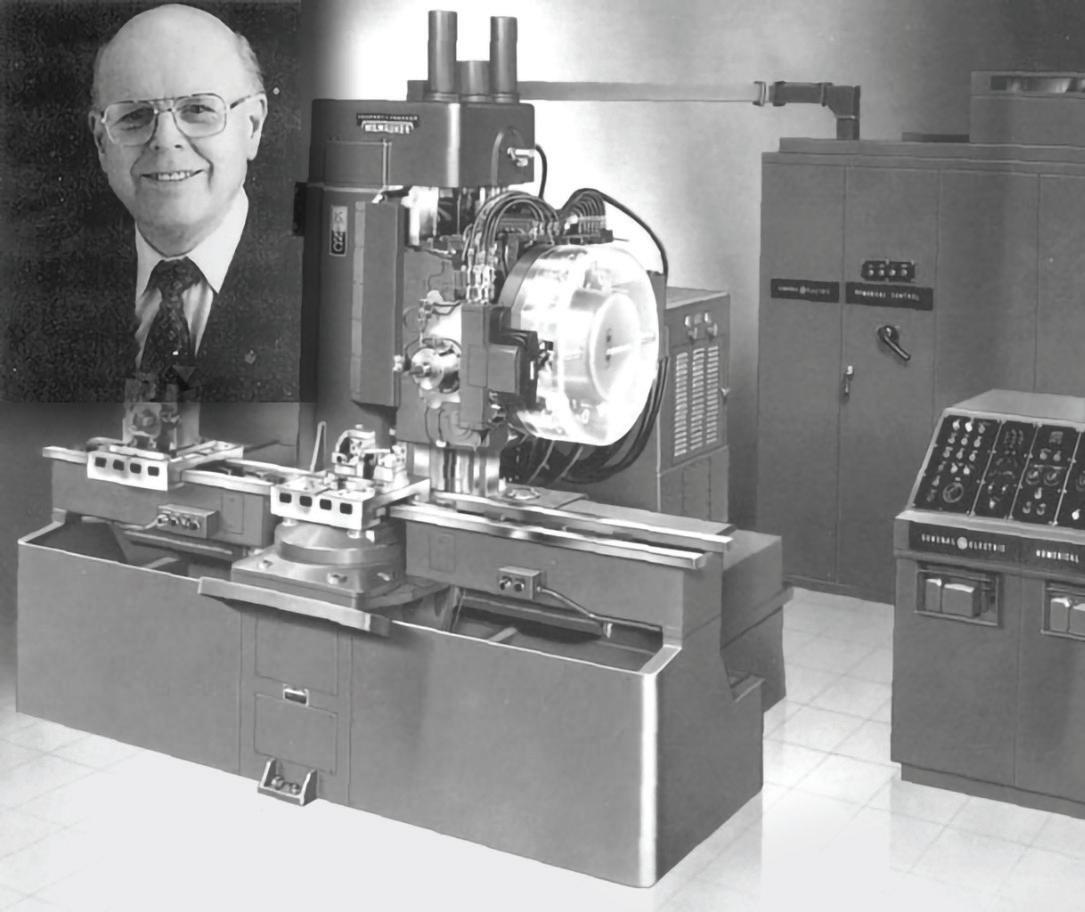
the way we approach manufacturing forever,” the article stated.
Parsons’ 60-year career of creative problem-solving involving metals and machines began humbly, when he took a job as a piece worker in a Detroit stamping plant. Later, he was a tool room apprentice. He didn’t have a college degree.
“He very much came up through the shops, his father’s shops,” says Steven Walton, an associate professor of history who specializes in technology and science at Michigan Technological University in Houghton. Walton is researching Parsons’ career.
The outbreak of World War II presented multiple manufacturing opportunities for the young inventor. At that time, the armaments industry required companies with military contracts to shrink their footprints by moving manufacturing plants out of cities to less densely populated areas, reducing their chances of becoming enemy targets.
Parsons moved a branch of his father’s Detroitbased automotive parts company to an unlikely location, Traverse City — then, as now, a major vacation haven and the state’s top cherry- and wine-growing region.
Walton says Parsons bought a factory building in Detroit, disassembled it, and reassembled it in Traverse City. In that bucolic setting, he established the Parsons Corp. and obtained military contracts to build bombs, rockets, and land mines.
Following the war, in 1946, Parsons hired Frank L. Stulen, an aeronautical engineer in the Material Command of the U.S. Army Air Force, the service branch responsible at the time for developing aircraft, electronic systems, munitions, and missiles. Stulen would become his invaluable collaborator and sounding board.
Stulen had a background in military manufacturing and was head of the Military Command’s helicopter lab at Wright Air Force Base, now Wright-Patterson, near Dayton, Ohio.
At the time of his hire, Stulen was working on problems with perfecting curves of helicopter rotor blades. Parsons had undertaken a similar challenge in Traverse City (Parsons Corp. had produced a single helicopter propeller prototype).
“They got a subcontract to build helicopter rotor blades, and that was completely different technology mechanically because rotor blades were built up out of handcrafted wood and then a plywood skin, which as far as I can tell was material and a process they never before had anything to do with, but John T. said, ‘Yes, we can do that,’ ” Walton says.
To bring precision to their work, Parsons and Stulen figured out how to use punch card technology and IBM tabulation machines to control a cutter to make templates for manufacturing the curved helicopter propellers. “That was the basis of all numerical control, now CNC machining, that’s all over the planet,” Walton says.
Soon after, Parsons Corp. became the country’s largest independent manufacturer of helicopter blades. It held that position through the Korean War until major helicopter builders like Sikorsky Aircraft brought that work in-house, Walton says.
Parsons’ partnership with Stulen spanned decades, with Stulen serving as the company’s chief engineer and vice president of engineering. Apart from rotor blades, the company successfully applied similar concepts to the design and production of fiberglass tail fins for aircraft for the U.S. Air Force.
Despite his early success, Parsons was nearly sidelined from the company he founded.
“By the 1950s, the bureaucrats who were in this now larger company thought he was putting too much money into research for the numerical control stuff and they couldn’t see where this was going to be a money-maker, so his CFO at the time engineered his ouster,” Walton says. “The whole company largely turned against the CFO, and Parsons came back in about two years and became the sole owner.”
PUNCH CARDS John T. Parsons, who was born in Detroit, was a pioneer in the development of numerical control systems, which led to today’s highly productive CNC machines, which are used in factories around the world.
Parsons’ inventions weren’t limited to military uses, but extended to a wide swath of industries. The company produced built-in kitchen units, fiberglass boats, and archery equipment.
Over his career, Parsons and his company filed more than 50 patents for his inventions with the United States Patent and Trademark Office. He pioneered adhesive bonding for titanium, aluminum, and alloy steel in metal aircraft structures, and used that technique to build the first all-composite airplane for the Office of Naval Research.
Parsons also applied his numerical control advancements to revolutionize the production of dies used for building automobile bodies.
In addition, Parsons Corp. became a key player in America’s space program. Parsons invented the
process of tube extrusion, which produced the massive fuel lines for NASA’s mighty Saturn V booster rockets that took U.S. astronauts Neil Armstrong, Michael Collins, and Edwin “Buzz” Aldrin to the moon in 1969. The blades on the helicopter that plucked the trio from the ocean after splashdown also were made by Parsons Corp.
“I used to say we took them to the moon and we brought them back home afterward,” Parsons told the Traverse City Record-Eagle upon the recovery of the astronauts.
Not everything Parsons invented made money. He had a brief foray into fiberglass boat-building in the 1980s, Walton says, describing a videotaped interview in which Parsons said, “We spent $3 million to make $1 million in sales.”
“This was another case of him pivoting into another industry using fiberglass construction, which they were doing with rotor blades, but the boat one didn’t work so well,” Walton says. “It was the marketing and consumer contact that the company didn’t have, and didn’t want to do. Going to boat shows was something Parsons had never done. They tried it, and it didn’t work.”
In the late 1960s, Parsons looked at expanding to Texas and Florida, but nothing came of it.
“He opened a small branch in Stockton, Calif., to be near the aerospace industry, and that’s what resulted in their demise,” Walton says. “They came to the attention of Hitco Carbon Composites, a California-based company that wanted Parsons’ patents for tube extrusions. Hitco bought out Parsons, promising to keep the Traverse City operation open, but closed it within two years. The deal went through in 1968, and Traverse City was closed in 1970 or 1971.”
Parsons went into private R&D until he retired, while Stulen became a prominent member of the Traverse City community. He served on several boards, was elected a city commissioner, and was mayor for one year. He received the Traverse City Distinguished Citizen Award in 1972.
In 1975, the Society of Manufacturing Engineers awarded Parsons a plaque naming him The Father of the Second Industrial Revolution. A decade later, former President Ronald Reagan awarded Parsons and Stulen the nation’s most prestigious scientific citation, the National Medal of Technology.
In 1988, the University of Michigan presented him with an honorary Doctor of Engineering degree, and Parsons was inducted into the National Inventors Hall of Fame in 1993, joining legendary predecessors like Alexander Graham Bell, Thomas Edison, and Henry Ford.
John T. Parsons died on April 18, 2007, at age 93. Stulen was 89 years old when he passed away on June 25, 2010.
Burt Raynes, a competitor of Parsons and CEO of Rohr Corp., once said of the inventor: “There aren’t 25 people in the United States capable of understanding the magnitude of John Parsons’ accomplishments.”
Because of his move to Traverse City in the early days of World War II, Parsons catalyzed industrial activity in Traverse City, a legacy that continues today, Walton says.
“Though his fundamentally important invention of numerical control machining — which revolutionized modern manufacturing the world over — didn’t spawn a local industry, the company’s coordination of engineers, craftsmen, programmers, material specialists, and then all the subsidiary companies that fed their production, including machine shops and lumberyards and aluminum and fiberglass suppliers, shifted Traverse City from being only an agricultural and vacation city to a region with an important aerospace and industrial base,” Walton says.
To improve the use of artificial intelligence in business, users should work in partnership with dedicated engineers to maximize outcomes and results.
BY DYLAN VANWORMERGenerative AI is poised to revolutionize multiple industries by rede ning how we engage with data, tackle challenges, and create content.
e primary focus so far has largely revolved around prompt-based formats, where users input a written outline describing what they’re looking for,
neural network. is network will take a grainy, low-sample render and “predict” the high-resolution outcome, free from any noise. e low-sample, low-quality inputs are very quick to produce, taking minutes rather than hours, and the AI predictions require only seconds per frame to complete.
and the AI model responds accordingly. e procedure often creates a palpable “wow” factor due to its wide range of potential use. However, the true value of the AI-driven industry lies not in these broad implementations, but in innovative approaches that meticulously target and resolve business-speci c problems.
Instead of focusing solely on prompts, businesses need to explore how to leverage their own data to train neural networks for more targeted solutions. is requires a basic understanding of what a neural network is, as well as its limitations. To better understand the potential of targeted AI solutions, let’s consider an illustrative example from the world of animation.
When creating 3-D animated content, one of the nal steps in the production pipeline is a process called rendering. is is where the nal frame, including the intricate lighting e ects that make modern animation so appealing, is calculated. e tech world calls this process raytracing, or path-tracing, where virtual “rays” are cast into the scene. ese rays bounce around emulating realworld light behavior, capturing the dance of light in every frame.
It’s an iterative process, where the 3-D scene is sampled with rays over and over again, each time increasing the quality of the image and reducing visual noise. But problems arise due to the time needed to produce a nal-quality render, often resulting in many hours per frame of animation. is is precisely where arti cial intelligence comes into play.
Rather than waiting countless hours for the nal high-quality renders to converge, we can train a
is particular model is trained by creating a large dataset of 3-D renders, which is then fed into the network. Each entry in the dataset contains a low-sample, noisy render, and an associated “ground truth” version that’s rendered at maximum quality. e type of network leverages a mathematical process called convolution, which allows the network to learn how to take noisy input and get it to look like the ground truth version through reduction and simpli cation.
time for iterations and re nement opportunities for the artist.
In short, this method reduces the studio’s computational load and gives artists more time to focus on their craft.
Achieving thoughtful implementation arises from meaningful collaboration between artists and AI developers or engineers. Artists should have a pivotal role in shaping the design, training, and implementation of the systems.
By engaging with AI engineers directly, creative professionals can ensure the resulting tools are aimed at supporting their e ciency and artistic capabilities — not just replicating or replacing them. Such partnerships underscore the importance of cross-disciplinary collaboration when looking at the future of AI in a human world.
e exploration of 3-D animation highlights a pivotal insight: AI’s transformative potential isn’t rooted in broad, generic solutions, but in precision-tailored applications with thoughtful implementation.
In simple terms, the model begins by making a random guess about how each image should appear random guess and the ground truth input is referred
where it dynamically changes its underlying parameters to try and reduce the loss value with each training pass. e lower the loss, the more accurate
In simple terms, the model begins by making a random guess about how each image should appear without any visual noise. e di erence between the random guess and the ground truth input is referred to as the “loss,” and represents the accuracy of the model. e network plays a game of hot or cold, where it dynamically changes its underlying parameters to try and reduce the loss value with each training pass. e lower the loss, the more accurate the model.
After training, users can input a low-quality render. Within moments, the model provides an accuhigh-sample render. While impressive, the true impact emerges when considering the
After training, users can input a low-quality render. Within moments, the model provides an accurate, denoised version, far quicker than a traditional high-sample render. While impressive, the true impact emerges when considering the broader implications.
ture lm, this AI application has the tional time, yielding considerable e -
In the context of an animated feature lm, this AI application has the potential to conserve thousands of hours of computational time, yielding considerable eciency gains. It also carves out more

promoting meaningful collaboration, businesses can unearth signi cant value from AI. As we look to the future, it’s these nuanced, targeted applications course of AI-driven industries.
By focusing on the unique challenges of each sector, leveraging ethically sourced datasets, and promoting meaningful collaboration, businesses can unearth signi cant value from AI. As we look to the future, it’s these nuanced, targeted applications that will steer the course of AI-driven industries.



May 2, 5:30 p.m. - 11 p.m turningpointmacomb.org
Turning Point, an agency whose mission is to empower survivors of domestic violence, sexual violence, and human trafficking through comprehensive services and resources, will host its eighth annual fundraiser, Stepping Out with the Stars, in partnership with the Arthur Murray Dance Studios of Sterling Heights and Royal Oak, at The Palazzo Grande. This year, the event will be emceed by Jessica Dupnack of Fox 2 Detroit and will feature five dancers: Tamara Flake of Mercantile Bank, Ashley Haack of Real Team Real Estate, Macomb County Executive Mark Hackel, Michigan State Police Forensic Scientist Anne Nessia, and survivor Karen Ruffino of Horizon Steele. In addition to the dance competition, the evening will include an open bar, seated dinner, silent auction, raffle baskets, wine pull, and other activities.
May 6, 6 p.m. - 8:30 p.m. acg.org/detroit
ACG Detroit will host its Ninth Annual M&A All-Star Awards at The Townsend Hotel on Monday, May 6, from 6-9:30 p.m. Guests will enjoy a short awards ceremony honoring this year’s award-winners, led by Diamond Sponsor Foley & Lardner. In addition, guests will have access to an open bar and delicious cuisine. Ticket prices are as follows: members, $130; nonmembers, $175; more than five attendees from the same company, $150 each.
May 15, 8:30 a.m. - 11:30 a.m. troychamber.com



What steps do you think can and should be taken in the workplace to make professional opportunities more equitable regardless of race, gender, age, ability, and sexual orientation? This half-day summit will discuss how to build a strategic approach to creating a diverse and equitable workplace, how to foster an inclusive environment for employees, and the steps one should take in building a business community free of racism and discrimination. Topics and presenters include: The Current State of DEI, Gary Abernathy, CDP/MBA, vice president and DEI practice leader, Marsh McLennan Agency; What’s in a Word, Michelle Cantor, certified coach and diversity executive, Volar Consulting; and The DEI Landscape After the SFFA v. Harvard Ruling, Michelle Crockett, principal, deputy executive officer and chief diversity officer, Miller Canfield.
May 22, 6 p.m. - 9 p.m. warmemorial.org

The War Memorial’s premier fundraising gala is back! An Evening of Red, White & Blue is planned for Wednesday, May 22. Join the festivities as The War Memorial celebrates 75 years as a patriotic, cultural and community leader. This year’s gala promises to be a delightful evening filled with live music, delectable cuisine, and exciting activities: a 75th anniversary celebration complete with a live auction. The funds raised at this event will play a pivotal role in restoring and preserving the facility’s historic buildings and grounds, specifically the 1910 Alger House. Your participation will demonstrate your support of the legacy and mission of this nonprofit organization, ensuring that future generations will continue to benefit from the many activities, services, and educational opportunities provided to veterans, guests, and the community. The evening includes cocktails and live music in new the Fred M. Alger Center and front circle, remarks and a gourmet dinner, a live auction, and dessert. Come dressed in patriotic chic. Reserve your seat today!
May 23, 8 a.m. - 9:30 a.m. detroitpublicsafety.org
Women in Blue is an annual event hosted by the Detroit Public Safety Foundation to celebrate Detroit’s female first responders. The event highlights the incredible women who serve with the Detroit Police and Fire departments. Women in Blue recognizes the first responders’ contributions and encourages women in leadership. Awards are given for the Women in Blue Officer of the Year and the DFD Woman of the Year. Keynote remarks will be presented by a strong female leader.

CHRISTINE M.J. HATHAWAY
The Medallion Gala 2024 took place on Feb. 24, at the Palazzo Grande in Shelby Township. The event was sponsored by Henry Ford Health, with proceeds dedicated to the transformation of Henry Ford Macomb Hospital — with a goal of establishing the first fully private-room hospital in Macomb. The black-tie themed celebration also recognized and honored physicians, volunteers, and community partners.
1. Val Poliuto, Mary Gallo Poliuto, Angela and Vince Manzella
2. Melanie and Steven Lochner, Joe and Jen Tandoc
3. Ross and Susan Buffa
4. Shanna and Jason Johnson, Laurel and Dr. Steve Kaukanis
5. Hon. Anne Marie and Vince Lepore








CHRISTINE M.J. HATHAWAY
The American Heart Association hosted the 2024 Detroit Go Red for Women celebration on March 13 at Huntington Place in Detroit. The event raised money for the association’s research and services. The gathering featured an awards ceremony and three different auctions. Sponsors included Blue Cross Blue Shield of Michigan, Gentherm, Delta Dental, Barton Malow, Corewell Health, Accenture, DTE Energy, Michigan Medicine, TriMas Corp., Amerisure, KPMG, and Trinity Health
11. Troy Chamber of Commerce
12. Kristi Stepp, Shanna Johnson, Denise Brooks-Williams, Tracy Means, Rhonda Walker
13. Jordyn Stephens, Erika Stephens, Maria Leon-Johnson, Cintia Stoehr
14. Amber Schilling, Jessy Field
15. Dr. Joan Crawford, Kristy Sidlar, Paula Silver

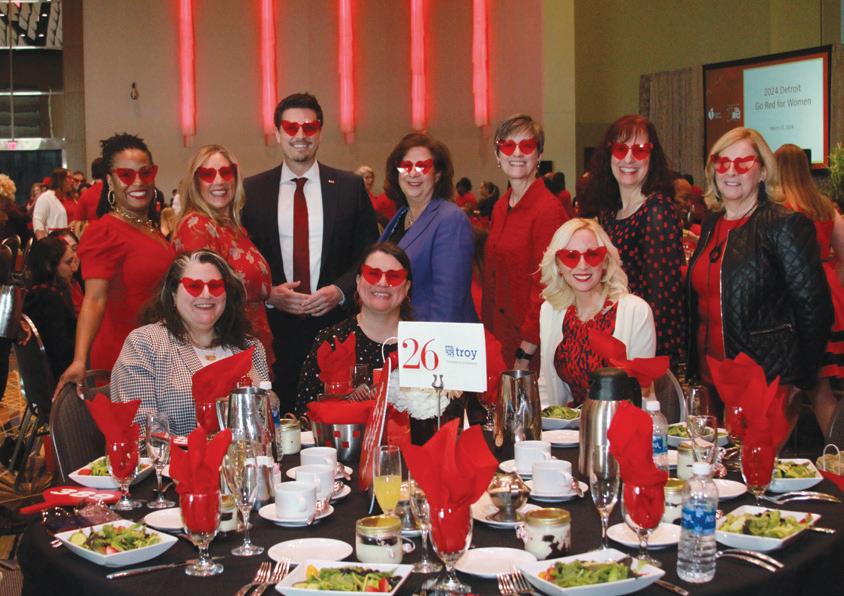


PATRICK GLORIA
Beyond Basics, a Southfield nonprofit that promotes literacy, hosted its annual fundraiser, A Journey Through the Pages, on March 1, at the Townsend Hotel in Birmingham. The nonprofit organization is dedicated to enhancing literacy among students through an individual-centered approach that’s intensive, holistic, and multisensory, and firmly rooted in phonics. Honorees included Samantha and Manuel Amezcua, the Wagerson family, the Liggett family, the Karen and Drew Peslar Foundation, the Farbman family, Linda Orlans, the Aronson family, Jared Davis, General Motors Foundation, and the Van Elslander family.
6. Pamela Good, Samantha and Manuel Amezcua, Selam Sanders
7. Michelle Cahoon, Sheeba and Jacob Cheriyan 8. Mike and Kristi Rogers
9. Bradley Foster, Katie Nienstedt, Kalie Foster 10. Deborah and Loren Venegas





June 3, 11 a.m. - 1 p.m.
auburnhillschamber.com
Women Empowered brings together women from the community to help them advance their careers through knowledge, acquisition, and networking. Listen as female executives provide key take-aways on how they position themselves at the top of their professions.
June 2, 5 p.m. - 9 p.m. therentparty.org
In the spirit of the rent party tradition, which offered a DIY solution for families facing eviction in the 1920s — playing a major role in the historic development of jazz and blues music — Lighthouse presents the Eighth Annual Rent Party. Funds raised from this event will support Lighthouse’s life-changing programs, including shelter and housing programs that work to find families and individuals a safe place to call home. The Eighth Annual Rent Party consists of an exciting jazz concert at the historic Meadow Brook Hall, a Tudor revival style mansion built between 1926-1929. Learn more at therentparty.org.
June 7, 8 a.m. - 5 p.m. bridgingcommunities.org



Come join the fun at the 14th Annual Bridging Communities Charity Golf Outing on Friday, June 7, at the beautiful Fox Hills Golf & Banquet Center in Plymouth. Since 1998, Bridging Communities Inc. has worked to connect older adults and families to resources and programs that promote healthy communities, housing stability, and senior independence. BCI is proud to partner with Professional Golf Planners of America for this golf outing, where your registration includes 18 holes of golf with a cart, the driving range, a golfer gift bag, lunch, dinner, an awards ceremony, a raffle, and more! Golfer and sponsor opportunities are available at progolfplanners.com/bccg.
June 8, 8 a.m. - 11 a.m. beaumont.org/walk-for-miracles
Superheroes of all ages are invited to the Corewell Health Children’s Walk for Miracles at the Detroit Zoo on Saturday, June 8, beginning at 7:30 a.m. Enjoy the zoo for the entire day by walking the two-mile loop and exploring the zoo exhibits. Attendees will also enjoy complimentary refreshments and meet popular comic book and fairytale heroes! Participants are encouraged to dress as their favorite superhero and will receive a superhero cape and finishing medallion. Walkers must register in advance and make a minimum donation of $12 for ages 13 and over and $8 for ages 2-12. Children under the age of 2 are free. All walkers are encouraged to raise $100 for the Children’s Miracle Network, but it is not required. Parking is complimentary. All proceeds benefit pediatric programs and services offered through the Children’s Miracle Network at Corewell Health Children’s. For sponsorship opportunities, contact charlotte.alex@corewellhealth.org. To register in advance, visit beaumont.org/walk-for-miracles.

June 10, 6 p.m. - 9 p.m. detroitriverfront.org/shimmer
Join the Detroit Riverfront Conservancy for an unforgettable evening at Shimmer on the River on Monday, June 10 at Robert C. Valade Park.

This magical night is the Conservancy’s largest fundraiser of the year. Shimmer is a family-friendly beach party with show-stopping music, a festive boardwalk lined with summer activities, an Adventure Park, a kids dance party, strolling dinner from Detroit’s favorite food trucks, and more.
A highlight of every Shimmer on the River is the presentation of the Shimmer Award, the highest honor the Conservancy bestows. This year, the Conservancy will honor Vivian Day & John Stroh and Robert Davis for their contributions to the Detroit Riverfront. Shimmer on the River tickets are $150 for the main event and $250 for VIP. Each ticket includes free admission for up to two children 12-and-under. Tickets and details available at detroitriverfront.org/shimmer.
PATRICK GLORIA
WJR-AM radio personality Paul W. Smith hosted the annual St. Patrick’s Day Celebration on March 15 in the lobby of the Fisher Theatre in Detroit. The annual broadcast event has been a mainstay for WJR for nearly 40 years. Guests featured at this year’s event included Detroit Mayor Mike Duggan, Macomb County Executive Mark Hackel, Oakland County Executive Dave Coulter, and Gardner White Furniture President Rachel Stewart.
1. Euel Kinsey, David Montera, William Giovan, Steve Sutherland
2. Marie Osbourne, Dayna Clark, Detroit Police Chief James White
3. Crystal Smith, Dawn Ison
4. John Paul Rea, Mark Hackel, Anthony Wickersham
5. Gary Kirsh








PATRICK GLORIA
Variety Cocktails and Cuisine took place at the Townsend Hotel in Birmingham on Feb. 15. The event raised money for Variety — The Children’s Charity of Detroit. The nonprofit organization provides core programs to support children with unique and special needs. The evening, co-chaired by Anthony Long, Justin Near, Dante Rosa, and Aubrey Tobin, included cuisine from Andiamo, Bella Piatti, Birmingham Pub, Crispelli’s, Joe Muer Seafood, and the Rugby Grille.
11. Bruce Ballard, Kathy Broock, Paul Venn, Lisa Bouchard
12. Nino and Liz Cutraro
13. Rod and Tammy Alberts
14. Michelle Murphy, Susan Pitrone, Rick Colcomb
15. Dante Rosa, Julie Ann Rosa




PATRICK GLORIA
On March 7, St. John’s Guild, which raises money to assist patients at Ascension St. John Hospital in Grosse Pointe, helds its 2024 Kickoff Reception at the Country Club of Detroit in Grosse Pointe Farms. The cocktail reception served as a prelude to the upcoming St. John’s Guild Annual Dinner, which takes place later this year. The kickoff drew honorees, guild members, and guests. Since 1948, the nonprofit organization has raised more than $15 million to provide medical equipment, technology, and services to Ascension St. John Hospital.
6. John DeWald, Greg DeMars, John Vicari, Joe Paluzzi, Larry Hurstr
7. Phil Myers, Michael Tindall, Dr. Kevin Grady
8. Joe Fikany Jr., Ryan Berns
9. Roland Cruickshank, Melissa DeGraw, Dr. Marrcus Degraw
10. Dan Roma, Jack Roma

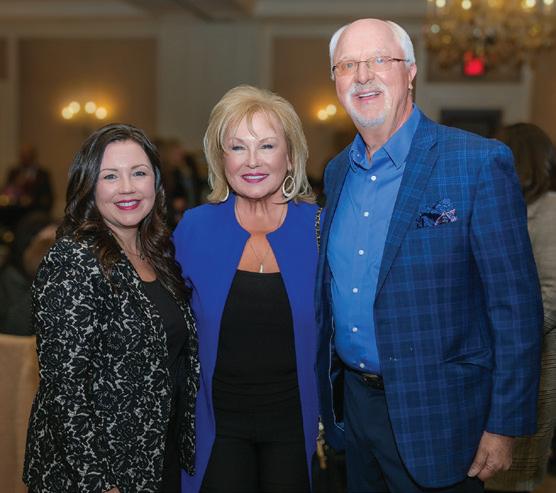

June 10, 8:30 a.m. - 5 p.m. beaumont.org/giving/events



Corewell Health Foundation Southeast Michigan presents the Women’s Health Care Classic on Monday, June 10, from 8:30 a.m.-5 p.m. Come out and support the women’s health services and breast care programs offered by Corewell Health hospitals in Dearborn, Taylor, Trenton, and Wayne. This is a two-course golf tournament, as exclusively women are invited to play at the Dearborn Country Club, while both men and women are welcome to take on the challenging TPC Michigan. Attendees will enjoy a day of golf complemented by breakfast, lunch, and an awards ceremony with beer, wine, and appetizers. Funds will also be raised through a silent auction. For sponsorship opportunities, please contact karen.whetter@corewellhealth.org. To register, visit beaumont.org/giving/events.
June 16, 10 a.m. - 4 p.m. eyesondesign.org/car-show
Attend the world-class car show, EyesOn Design, at the Ford House in Grosse Pointe Shores on Father’s Day — Sunday, June 16. The grand marshal is Tim McGrane, CEO of M1 Concourse in Pontiac. The 2024 honorary chairman is the founder of The Amelia Island Concours d’Elegance, Bill Warner. Together, they will preside over the annual show, themed “Design Masters: A Lifetime of Design Achievement,” which will feature significant automotive designs of historic winners of the EyesOn Design Lifetime Design Achievement Award. Walk among a spectacular array of significant automotive designs of the past, present, and future, and mingle with auto industry insiders during the elegant champagne brunch. Weekend events include a Friday driving tour of southeast Michigan and a Friday evening Vision Honored gala at M1 Concourse, celebrating the Lifetime Design Achievement winner for 2024: Prof. Gordon Murray, CBE. A Saturday symposium will explore the design history of the Ford GT through the designers who brought it to life. An invitation-only designer’s reception and tour will take place Saturday at the Toyota Calty Design Center in Ann Arbor. Proceeds support the visually impaired through the Detroit Institute of Ophthalmology. This is the ultimate Father’s Day gift and a must-attend for every car lover. Visit eyesondesign.org to reserve your tickets today!

June 17, 7 a.m. - 9 p.m. variety-detroit.com

The 35th annual Variety Kovan Golf Classic will take place on Monday, June 17, with a return to the venue where it all began: Tam-O-Shanter Country Club in West Bloomfield. The day includes morning and afternoon rounds, breakfast/lunch/dinner, beverages, a raffle, and an auction. This popular outing helps provide funds for children with physical and cognitive challenges in our community; funds raised benefit the Dr. Bradley S. Kovan Memorial Fund at Friendship Circle, the Jonathan Scott Kovan Memorial Fund at University of Michigan C.S. Mott Children’s Hospital, and Variety Core Programs serving children with unique and special needs.
June 20 8 a.m. - 6 p.m. powerconnectionsco.com/commercial-real-estate-event-2024/

Power Connections Commercial Real Estate isn’t just a conference; it’s a dynamic catalyst for collaboration and innovation. Its mission is to bring together industry leaders to foster face-to-face interactions and thought-provoking discussions going beyond business as usual. This one-day immersive conference offers exclusive insights into the latest market conditions, engaging panel discussions, and the region’s largest 1:1 speed networking session. Attendees will have an opportunity to connect with more than 400 professionals from the CRE community. CEOs and C-suite executives attend to share their stories, elevate their teams, source talent and capital, and, most importantly, to build a community. Discover new connections, learn from the experts, and leave with handshake deals. For registration and sponsorship information, visit powerconnectionsco.com/commercial-real-estate-event-2024/.
June 24, 5:30 p.m. - 11 p.m. theparade.org

You’re invited to join The Parade Company’s Ford Fireworks Rooftop Party, presented by Ford Motor Co., on Monday, June 24, from 5:30 to 11 p.m. The 66th edition of the Ford Fireworks promises to be one of the country’s largest and most stunning fireworks shows, and this night atop the Center Garage has the best seats in the city. Guests will overlook the beautiful Detroit River while enjoying delectable food by Andiamo, games, giveaways, live music, and more! Produced by The Parade Company, the Ford Fireworks will light up Detroit’s skyline at dusk, offering picturesque views of downtown. The Rooftop Party is one of the organization’s premier annual fundraisers, and proceeds benefit the Michigan Thanksgiving Parade Foundation. Tickets are $350; children 6 and under are $125. Tickets are subject to availability. To purchase tickets, please call 313-923-7400 or visit theparade.org.

















(SELECTED BY AAA AND DBUSINESS FOR HOSPITALITY EXCELLENCE)
MARRIOTT EAST LANSING AT UNIVERSITY PLACE
300 M.A.C. Ave. East Lansing
517-337-4440
marriott.com/lanea Rooms: 181
Meeting rooms: 9
Dining: Bistro 43, Great Room Restaurant and Lounge Meeting capacity: 12,927 sq. ft.
GRADUATE HOTEL EAST LANSING
133 Evergreen Ave.
East Lansing
517-348-0900
graduatehotels.com/east-lansing/ Rooms: 194
Meeting rooms: 3
Dining: Graduate Rock Bar, Poindexter Coffee
Meeting capacity: 2,673 sq. ft.
AMWAY GRAND PLAZA HOTEL, CURIO COLLECTION BY HILTON
187 Monroe Ave. NW Grand Rapids
616-774-2000 amwaygrand.com Rooms: 664
Meeting rooms: 42
Dining: Ruth’s Chris Steak House, MDRD, Lumber Baron Bar, Rendezvous, The Kitchen by Wolfgang Puck, Woodrows Duckpin, Starbucks Meeting capacity: 47,120 sq. ft.
CITYFLATSHOTEL
83 Monroe Center St. NW Grand Rapids
616-608-1720
cityflatshotel.com Rooms: 48
Meeting rooms: 4
Dining: CitySen Lounge Meeting capacity: 6,000 sq. ft.
EMBASSY SUITES BY HILTON GRAND RAPIDS DOWNTOWN 710 Monroe Ave. NW Grand Rapids
616-512-5700 hilton.com/en/embassy Rooms: 250
Meeting rooms: 6
Dining: Free breakfast and evening reception, Whitewater Lounge, Big
E’s Sports Grill Meeting capacity: 6,176 sq. ft.
JW MARRIOTT GRAND RAPIDS
235 Louis St. NW Grand Rapids
616-242-1500
ilovethejw.com Rooms: 331
Meeting rooms: 9
Dining: Margaux, Jdek at Margaux, Starbucks Meeting capacity: 15,756 sq. ft.
RADISSON HOTEL GRAND RAPIDS
RIVERFRONT
270 Ann St. NW Grand Rapids
616-317-6874
radissonhotel.com Rooms: 162
Meeting rooms: 2
Dining: River Rock Restaurant and Lounge Meeting capacity: 2,500 sq. ft.
CITYFLATSHOTEL HOLLAND, TAPESTRY COLLECTION BY HILTON
61 E. 7th St. Holland
616-796-2100
cityflatshotel.com Rooms: 56
Meeting rooms: 2
Dining: CitySen Lounge, CityBru Coffee
Meeting capacity: 5,332 sq. ft.
RADISSON PLAZA HOTEL & SUITES AT KALAMAZOO CENTER
100 W. Michigan Ave. Kalamazoo
269-343-3333
radissonkzoo.com Rooms: 340
Meeting rooms: 22
Dining: Old Burdick’s Bar & Grill, The Morning Dish, Brick and Brine, Starbucks, room service
Meeting capacity: 50,000 sq. ft.
GRAND HOTEL
286 Grand Ave. P.O. Box 286 Mackinac Island 800-334-7263
grandhotel.com
Rooms: 388
Meeting rooms: 17
Dining: Grand Hotel Main Dining Room, Grand Luncheon Experience, Grand Coffee & Provisions, Esther Williams Pool Bar, The Jockey Club, Woods Restaurant, The Gate House, Fort Mackinac Tea Room, Sadie’s Ice Cream Parlor. Cocktails available at Audubon Wine Bar, Cupola Bar, Geranium Bar, and Bobby’s Bar at Woods.
Meeting capacity: 24,878 sq. ft.
MISSION POINT RESORT
One Lakeshore Dr. Mackinac Island 906-847-3000
missionpoint.com
Rooms: 241
Meeting rooms: 20
Dining: Chianti, Round Island Kitchen, Bistro on the Greens, Boxwood Coffeeshop & Café, Lily’s Lemonade, Strait UP Coffee
Meeting capacity: 4,925 sq. ft.
THE H HOTEL
111 W. Main St. Midland
989-839-0500 thehhotel.com
Rooms: 130
Meeting rooms: 8
Dining: ONe eighteen, Café Zinc, Oxygen Lounge, 24-hour room service Meeting capacity: 10,000 sq. ft.
SOARING EAGLE CASINO & RESORT
6800 Soaring Eagle Blvd. Mount Pleasant GPS address: 2395 S. Leaton Rd. 989-775-5777
soaringeaglecasino.com
Rooms: 514
Meeting rooms: 17
Casino tables: 70
Dining: Ascend Sportsbook Bar and Lounge, Siniikaung Steak and Chop House, Legend’s Diner, Ruth’s Chris Steak House, Central Deli and Slice, Native Grind Coffee Shop, Little Eagle Café Meeting capacity: 70,000 sq. ft.

ST. JOSEPH
THE INN AT HARBOR SHORES
800 Whitwam Dr. St. Joseph 269-983-1111 harborshoresresort.com
Rooms: 92
Meeting rooms: 4
Dining: Plank’s Tavern on the Water, Plank’s Dockside Bar, Rise and Vine, Torch and Tapas Meeting capacity: 13,000 sq. ft.
GRAND TRAVERSE RESORT AND SPA
100 Grand Traverse Village Blvd. P.O. Box 404 Acme 231-534-6000
grandtraverseresort.com
Rooms: 525
Meeting rooms: More than 20 indoor and outdoor venues
Dining: Aerie Restaurant & Lounge, Sweetwater American Bistro, The Grille, Jack’s Taproom, The Den Bar, Grand Lobby Bar, Marketplace, in-room dining Meeting capacity: 86,500 sq. ft.
INN AT BAY HARBOR
3600 Village Harbor Dr. Bay Harbor 844-827-1959
innatbayharbor.com
Rooms: 105
Lakeside cottages: 23
Cottages at Crooked Tree: 15
Meeting rooms: 6
Dining: The Sagamore Room, Inn Café, Vintage Chophouse Wine Bar, Cabana Bar (summer only), The Links Grille (summer only) Meeting capacity: 11,425 sq. ft.
HOTEL WALLOON 4127 N. M-75 Walloon Lake 231-535-5000
hotelwalloon.com
Rooms: 32
Meeting rooms: 4
Dining: Barrel Back, Walloon Lake Inn, Hearth Room and Bar Meeting capacity: 3,700 sq. ft.
CAESARS WINDSOR CASINO AND HOTEL
377 Riverside Dr. E. Windsor, Ontario 800-991-7777
caesarswindsor.com
Rooms: 758
Meeting rooms: 10
Casino tables: 85
Dining: Neros Steakhouse, Legends Sports Bar, Spago Trattoria, Café 377, Johnny Rockets, Tim Horton’s, room service Meeting capacity: 100,000 sq. ft.
Source: DBusiness research
1. BARTON MALOW HOLDINGS
26500 American Dr. Southfield
248-436-5000
bartonmalow.com
2023 revenue: $6.4B
2022 revenue: $4.8B
Regional employees: 3,000
Top local executive: Ryan Maibach, President & CEO
2. WALBRIDGE 777 Woodward Ave., Ste. 300 Detroit
313-963-8000
walbridge.com
2023 revenue: $5.93B
2022 revenue: $3.6B
Regional employees: 1,500
Top local executive: Michael Haller, CEO
3. BELFOR HOLDINGS INC.
185 Oakland Ave., Ste. 150 Birmingham 248-594-1144
belfor.com
2023 revenue: $2.7B
2022 revenue: $2.1B
Regional employees: 1,659
Top local executive: Sheldon Yellen, CEO
4. COMMERCIAL CONTRACTING GROUP INC.
4260 N. Atlantic Blvd. Auburn Hills
248-209-0500 cccnetwork.com
2023 revenue: $1.03B
2022 revenue: $633.5M
Regional employees: 321
Top local executive: Stephen Fragnoli, President & CEO
5. IDEAL CONTRACTING 2525 Clark St. Detroit
313-843-8000
idealcontracting.com
2023 revenue: $537M
2022 revenue: $478M Employees: 476
Top local executive: Frank Venegas Jr., Chairman
6. ARISTEO CONSTRUCTION 12811 Farmington Rd. Livonia 734-427-9111 aristeo.com
2023 revenue: $818.4M
2022 revenue: $488.2M
Regional employees: 750
Top local executive: Michelle Aristeo Barton, President
7. ALBERICI CONSTRUCTORS INC.
26711 Northwestern Hwy., Ste. 255 Southfield 734-367-2500 alberici.com
2023 revenue: $367.4M
2022 revenue: $307.9M
Local employees: 24
Top local executive: Aaron Walsh, General Manager & Market Leader
8. AUCH CONSTRUCTION
65 University Dr. Pontiac
248-334-2000
auchconstruction.com
2023 revenue: $208M
2022 revenue: $187.5M
Regional employees: 90
Top local executive: Jeffrey Hamilton, President & CEO
9. TURNER CONSTRUCTION CO. 535 Griswold, Ste. 1525 Detroit
313-596-0500
turnerconstruction.com/ office-network/Detroit
2023 revenue: $207.5M
2022 revenue: $188.4M
Regional employees: 93
Top local executive: Robert Bowen, Vice President & General Manager
10. SACHSE CONSTRUCTION
3663 Woodward Ave., Ste. 500 Detroit
313-481-8200
sachseconstruction.com
2023 revenue: $246M
2022 revenue: $150M
Regional employees: 157
Top local executive: Todd Sachse, CEO
1. AMERISURE 26777 Halsted Rd. Farmington Hills 800-257-1900 amerisure.com
2023 revenue: $972.3M
2022 revenue: $806M 2023 premium volume: NA Local employees: 304
2. MARSH MCLENNAN AGENCY 755 W. Big Beaver Rd., Ste. 2300 Troy 248-822-8000 marshmma.com
2023 revenue: $52.4M
2022 revenue: $47.9M
2023 premium volume: NA Employees: NA
3. KAPNICK INSURANCE GROUP 769 Chicago Rd., Third Floor Troy 248-352-4455 kapnick.com 2023 revenue: $48.2M
2022 revenue: $42.1M 2023 premium volume: $371.7M Employees: NA
4. HYLANT GROUP 24 Frank Lloyd Wright Dr., Ste. J4100 Ann Arbor 734-741-0044
2401 W. Big Beaver Rd., Ste. 400 Troy 48084 248-643-8750 hylant.com 2023 revenue: $34.4M
2022 revenue: NA 2023 premium volume: $507M Employees: 160
5. MICHIGAN FINANCIAL COS. INC. 28411 Northwestern Hwy., Ste. 1300 Southfield 248-663-4700 michiganfinancial.com
2023 revenue: $30.5M
2022 revenue: $27.6M
2023 premium volume: NA Employees: 187
6. BROWN & BROWN OF DETROIT INC. 5250 Corporate Dr., Ste. 200 Troy 586-977-6300 bbrown.com 2023 revenue: NA 2022 revenue: $18M
Source: DBusiness research WALBRIDGE, DETROIT

2023 premium volume: NA Employees: 100
7. KOROTKIN
26877 Northwestern Hwy., Ste. 400 Southfield
248-350-5801 korotkin.com
2023 revenue: $11.9M
2022 revenue: $9.3M
2023 premium volume: $100M Employees: NA
8. RALPH C. WILSON AGENCY INC. (Sold to Risk Strategies February 2024) 26026 Telegraph Rd., Ste. 100 Southfield 800-638-1174 rcwa.net
2023 revenue: $10.5M
2022 revenue: $14.4M
2023 premium volume: $175M Employees: 54
9. ALLIANT INSURANCE SERVICES
1050 Wilshire Dr., Ste. 210 Troy 248-540-3131 alliant.com
2023 revenue: $8.5M
2022 revenue: $5.8M 2023 premium volume: $143.2M Employees: 34
10. GOODMAN VENEGAS*
2800 Livernois Rd., Ste. 170 Troy 248-740-9090 goodmanvenegas.com
2023 revenue: NA
2022 revenue: $4M
2023 premium volume: NA Employees: 15
*Did not respond to request for information.
Source: DBusiness research
1. BLUE CROSS BLUE SHIELD OF MICHIGAN MUTAL INSURANCE CO.
600 E. Lafayette Blvd. Detroit
313-225-9000
bcbsm.com
Assets: $10,077,189
Surplus: $6,402,430
Michigan direct premiums
written: 10,132,206
Market share: 24.77 percent
Type: LH-MUT
2. PRIORITY HEALTH
American Center, 27777 Franklin Rd., Ste. 1300
Southfield
800-528-8762
priorityhealth.com
Assets: $1,873,890
Surplus: $1,211,444
Michigan direct premiums
written: 4,700,815
Market share: 11.49 percent
Type: HMO-NP
3. BLUE CROSS BLUE SHIELD NETWORK OF MICHIGAN
20500 Civic Dr. Southfield
800-662-6667
bcbsm.com
Assets: $2,673,167
Surplus: $1,751,452
Michigan direct premiums
written: 4,185,224
Market share: 10.23 percent
Type: HMO-NP
4. MERIDIAN HEALTH PLAN OF MICHIGAN 1 Campus Martius, Ste. 700 Detroit 313-324-3700 mimerdian.com
Assets: $938,364
Surplus: $372,409
Michigan direct premiums written: 3,050,564
Market share: 7.46 percent Type: HMO-P
5. MOLINA HEALTH CARE OF MICHIGAN
880 W. Long Lake Rd. Troy 888-898-7969 molinahealthcare.com
Assets: $585,707
Surplus: $213,800
Michigan direct premiums written: 1,981,698
Market share: 4.84 percent Type: HMO-P
6. HEALTH ALLIANCE PLAN OF MICHIGAN
2850 W. Grand Blvd. Detroit
800-422-4641 hap.org
Assets: $511,902
Surplus: $239.261
Michigan direct premiums written: 1,540,517
Market share: 3.77 percent Type: HMO-NP
7. UNITED HEALTHCARE COMMUNITY PLAN
26957 Northwestern Hwy., Ste. 400 Southfield
800-903-5253
uhccommunityplan.com
Assets: $388,235
Surplus: $186,840
Michigan direct premiums
written: 1,390,823
Market share: 3.4 percent
Type: HMO-P
8. BLUE CROSS COMPLETE OF MICHIGAN
100 Galleria Officentre, Ste. 210 Southfield
800-228-8554 mibluecrosscomplete.com
Assets: $512,042
Surplus: $177,539
Michigan direct premiums
written: 1,380,609
Market share: 3.37 percent
Type: HMO-NP
9. MCLAREN HEALTH PLAN
G-3245 Beecher Rd. Flint
888-327-0671
mclarenhealthplan.org
Assets: $434,776
Surplus: $273,710
Michigan direct premiums written: 1,132,124
Market share: 2.77 percent
Type: HMO-NP
10. PRIORITY HEALTH CHOICE
1231 Beltline Ave. NE Grand Rapids 833-489-5443 priorityhealth.com
Assets: $424,007
Surplus: $226,972
Michigan direct premiums written: 1,066,472
Market share: 2.61 percent
Type: HMO-NP
11. UNITED HEALTHCARE INSURANCE CO.
26957 Northwestern Hwy., Ste. 400 Southfield
800-832-7734 uhc.com
Assets: $21,388,958
Surplus: $6,437,090
Michigan direct premiums written: 923,812
Market share: 2.26 percent
Type: LH-STK
12. HUMANA DENTAL INSURANCE CO. 2660 Telegraph Rd., Ste. 220 Southfield 248-234-1352 humana.com
Assets: $360,550
Surplus: $187,920
Michigan direct premiums written: 876,623
Market share: 2.14 percent Type: LH-STK
13. HUMANA INSURANCE CO.
2660 Telegraph Rd., Ste. 220 Southfield 248-234-1352
humana.com
Assets: $10,180,328
Surplus: $4,813,772
Michigan direct premiums written: 853,406
Market share: 2.09 percent Type: LH-STK
14. DELTA DENTAL PLAN OF MICHIGAN 4100 Okemos Rd. Okemos 800-524-0149
deltadentalmi.com
Assets: $725,440
Surplus: $540,183
Michigan direct premiums written: 747,667
Market share: 1.83 percent Type: HMDI
15. AETNA LIFE INSURANCE CO.
28588 Northwestern Hwy. Southfield 248-357-7766
aetna.com
Assets: $24,809,289
Surplus: $6,192,864
Michigan direct premiums written: 630,327
Market share: 1.54 percent Type: LH-STK
16. AETNA BETTER HEALTH OF MICHIGAN
28588 Northwestern Hwy., Ste. 3808 Southfield 313-465-1500 aetnabetterhealth.com/Michigan Assets: $223,936
Surplus: $70,005
Michigan direct premiums written: 412,509
Market share: 1.01 percent Type: HMO-P
17. PRIORITY HEALTH INSURANCE CO.
1231 E. Beltline Ave. NE Grand Rapids 833-489-5443

priorityhealth.com/about-us
Assets: $141,962
Surplus: $61,635
Michigan direct premiums written: 366,831
Market share: 0.90 percent
Type: LH-STK
18. HUMANA MEDICAL PLAN OF MICHIGAN 16600 Telegraph Rd., Ste. 220 Southfield 800-486-2620 humana.com
Assets: $134,885
Surplus: $72,611
Michigan direct premiums written: 366,672
Market share: 0.89 percent Type: HMO-P
19. ALLIANCE HEALTH AND LIFE INSURANCE CO. (Part of Health Alliance Plan of Michigan) 2850 W. Grand Blvd. Detroit 313-872-8100 hap.org
Assets: $137,649
Surplus: $45,399
Michigan direct premiums written: 359,337
Market share: 0.88 percent Type: LH-STK
20. UPPER PENINSULA HEALTH PLAN 853 W. Washington St. Marquette 906-225-7500 uphp.com
Assets: $133,843 Surplus: $72,517 Michigan direct premiums written: 342,431 Market share: 0.84 percent Type: HMO-P
SUBTOTALS
Assets: $76,662,991 Surplus: $29,549,853 Michigan direct premiums written: 36,440,028 Michigan market share: 89.08 percent
KEY/DEFINITIONS
HMDI (Health, Medical, Dental Indemnity): Nonprofit insurance carriers governed by specific Michigan laws.
HMO-P, NP (Health Maintenance Organization – For Profit/Not for Profit): Delivers health care through contracted providers.
LH-STK (Life and Health Stock Companies): Stockholder-owned companies authorized to sell life insurance or health insurance.
Assets: Investments, cash on hand, items of value.
Surplus: Assets minus obligations. Michigan direct premiums written: Premiums written directly to Michigan consumers from insurance companies.
Source: Michigan Department of Insurance and Financial Services 2023 Annual Report for 2022 activity
1. HONIGMAN
2290 First National Building
660 Woodward Ave., Ste. 2290 Detroit
313-465-7000
honigman.com
Total attorneys: 242 (metro Detroit), 353 (firmwide)
Specialty: 68 practice areas
2. DICKINSON WRIGHT
500 Woodward Ave., Ste. 4000 Detroit
313-223-3500
dickinson-wright.com
Total attorneys: 187 (metro Detroit), 485 (firmwide)
Specialty: 40+ practice areas
3. BODMAN
1901 St. Antoine St. 6th Floor at Ford Field Detroit
313-259-7777
bodmanlaw.com
Total Attorneys: 161 (metro Detroit), 180 (firmwide)
Specialty: 50+ practice areas
4. MILLER CANFIELD
150 W. Jefferson Ave., Ste. 2500 Detroit
313-963-6420
millercanfield.com
Total attorneys: 142 (metro Detroit), 237 (firmwide)
Specialty: 100+ practice areas
5. TAFT DETROIT
27777 Franklin Rd., Ste. 2500 Southfield
248-351-3000
taftlaw.com
Total attorneys: 141 (metro Detroit), 875 (firmwide)
Specialty: 26 practice areas
6. CLARK HILL
500 Woodward Ave., Ste. 3500 Detroit
313-965-8300
clarkhill.com
Total attorneys: 129 (metro Detroit), 711 (firmwide)
Specialty: 21 practice areas (metro Detroit), 27 practice areas (firmwide)
7. DYKEMA
400 Renaissance Center Detroit
313-568-6800
dykema.com
Total attorneys: 114 (metro Detroit), 377 (firmwide)
Specialty: 100+ practice areas
8. BUTZEL
150 W. Jefferson Ave., Ste. 100 Detroit
313-225-7000 butzel.com
Total attorneys: 103 (metro Detroit), 144 (firmwide)
Specialty: 67 practice areas
9. KITCH DRUTCHAS WAGNER
VALITUTTI & SHERBROOK
1 Woodward Ave., Ste. 2400 Detroit
313-965-7900
kitch.com
Total attorneys: 84 (metro Detroit), 98 (firmwide)
Specialty: 16 practice areas
10. PLUNKETT COONEY
38505 Woodward Ave., Ste. 100 Bloomfield Hills
248-901-4000 plunkettcooney.com
Total attorneys: 82 (metro Detroit), 132 (firmwide)
Specialty: 28 practices areas in business, 34 practices areas in litigation
11. HOWARD & HOWARD ATTORNEYS
450 W. Fourth St. Royal Oak 248-645-1483 howardandhoward.com
Total attorneys: 68 (metro Detroit), 356 (firmwide) Specialty: 16 practice areas
12. BROOKS KUSHMAN
150 W. Second St., Ste. 400N Royal Oak 248-358-4400 brookskushman.com
Total attorneys: 62 (metro Detroit), 71 (firmwide) Specialty: 10 practice areas
13. SECREST, WARDLE, LYNCH, HAMPTON, TRUEX AND MORLEY 2600 Troy Center Dr. Troy 248-851-9500 secrestwardle.com
Total attorneys: 62 (metro Detroit), 70 (firmwide) Specialty: 20 practice areas
AMERICAN ARAB CHAMBER OF COMMERCE*
14. KERR, RUSSELL, AND WEBER
500 Woodward Ave., Ste. 2500 Detroit 313-961-0200 kerr-russell.com
Total attorneys: 61 Specialty: 38 practice areas
15. COLLINS EINHORN FARRELL
4000 Town Center, Ninth Floor Southfield
248-355-4141 ceflawyers.com
Total attorneys: 52 Specialty: 11 practice areas
16. GIARMARCO, MULLINS & HORTON
101 W. Beaver Rd. 10th Floor Columbia Center Troy 248-457-7000 gmhlaw.com
Total attorneys: 50 (metro Detroit), 55 (firmwide) Specialty: 36 practice areas
17. HARNESS IP 5445 Corporate Dr., Ste. 200 Troy 248-641-1600 hdp.com
Total attorneys: 45 (metro Detroit), 219 (firmwide) Specialty: Intellectual property law
18. MADDIN HAUSER 28400 Northwestern Hwy., Ste. 200 Southfield 248-354-4030 maddinhauser.com
Total attorneys: 44 Specialty: 18 practice areas
19. GARAN LUCOW MILLER
1155 Brewery Park Blvd., Ste. 200 Detroit 313-446-1530 garanlucow.com
Total attorneys: 35 (metro Detroit), 60 (firmwide)
Specialty: 24 practice areas
20. SULLIVAN, WARD, PATTON, GLEESON & FELTY
400 Galleria Officentre, Ste. 500 Southfield
248-746-0700
Total attorneys: 25
Specialty: Business and litigation law
Source: DBusiness research
12740 W. Warren Ave., Ste. 300 Dearborn
313-945-1700
americanarab.com
Members: 1,500-2,500
Focus: Local, national, and international
Meetings: Networking events, monthly seminars, annual Celebrating Success dinner, Arab-American Golf Open, Building Economic Bridges banquet, quarterly Business Builder series, international delegations and trips
Dues: $50-$5,000
Employees: 21
Founded: 1992
Contact: Bilal Hammoud, Executive Director
ANN ARBOR/YPSILANTI REGIONAL CHAMBER
2010 Hogback Rd., Ste. 4 Ann Arbor
734-665-4433
a2ychamber.org
Members: 1,300
Focus: Ann Arbor and Ypsilanti region
Meetings: Monthly networking meetings, Foundation Gala
Dues: $395-$5,000
Employees: 9
Founded: 1919
Contact: Diane Keller, President & CEO
ASIAN PACIFIC AMERICAN CHAMBER OF COMMERCE
P.O. Box 54 Clawson
248-430-5855
apacc.net
Members: 3,000+ in Michigan and U.S.
Focus: Asian/Pacific Islander American and U.S. businesses
Meetings: Networking, personal and professional development
Dues: $200-$1,200
Employees: 3
Founded: 2000
Contact: Duc Nguyen Abrahamson, Executive Director
AUBURN HILLS CHAMBER OF COMMERCE
P.O. Box 214083
3395A Auburn Rd.
Auburn Hills
248-853-7862
auburnhillschamber.com
Members: 400
Focus: Uniting organizational leaders in driving a world-class business community
Meetings: 100+ educational and networking events per year; several scheduled each month
Dues: $295-$1,950
Employees: 6
Founded: 1991
Contact: Jean Jernigan, President
BERKLEY AREA CHAMBER OF COMMERCE
P.O. Box 72-1253 Berkley
248-414-9157
berkleychamber.com
Members: 155
Focus: Berkley, Huntington Woods, Oak Park, Royal Oak, Southfield
Meetings: Monthly networking events, State of the City, Berkley Art Bash, Berkley Pub Crawl, Berkley Street Art Fest
Dues: $120-$500
Employees: 2
Founded: 1984
Contact: Darlene Rothman, Executive Director
BIRMINGHAM BLOOMFIELD CHAMBER
725 S. Adams Rd., Ste. 130 Birmingham 248-644-1700
bbcc.com
Members: 730
Focus: Beverly Hills, Bingham Farms, Birmingham, Bloomfield Hills, Bloomfield Township, Franklin Meetings: Vine and Dine, Village Fair, Forecast Breakfast Series, Professional Edge Workshop, Business After-Hours, member coffees, Community Leadership Luncheon, Legislative Reception
Dues: $365-$1,040
Employees: 4
Founded: 1947
Contact: Joe Bauman, President
BRITISH-AMERICAN BUSINESS COUNCIL OF MICHIGAN 150 W. Jefferson Ave., Ste. 100 Detroit 248-825-7075
babcmichigan.org
Members: 40 Platinum, Gold, and Silver members
Focus: Providing Midwest businesses and organizations with opportunities to extend their reach into the UK, and for UK companies to deliver their products, services, and messages to
the entire Michigan region
Meetings: Local events and seminars, annual transatlantic business conferences
Dues: $30-$750
Founded: 2006
Contact: Miriam Rhein and Anne Parkin, Executive Directors
CHALDEAN AMERICAN CHAMBER OF COMMERCE
30095 Northwestern Hwy., Ste. 101 Farmington Hills 248-851-1200
chaldeanchamber.com
Members: 1,000
Focus: Advocacy, networking, economic development, community development, cultural preservation
Meetings: Quarterly networking meetings, educational forums, annual awards dinner, annual meeting and board election, annual business luncheon, annual golf outing
Dues: $200-$1,500
Employees: 8
Founded: 2003
Contact: Martin Manna, President
CLARKSTON AREA CHAMBER OF COMMERCE
5856 S. Main St. Clarkston
248-625-8055
clarkston.org
Members: 475
Focus: Clarkston, Davisburg, Independence Township, Ortonville, Springfield Township
Meetings: Lunch mixers, breakfasts, after-hours, young professionals, women’s group, and large community events
Dues: $265-$565
Employees: 2
Founded: 1987
Contact: Kendal Penney Petzold, Executive Director
CLAWSON CHAMBER OF COMMERCE
425 North Main St. Clawson
248-435-6500
clawsonchamber.org
Members: 200
Focus: Clawson
Meetings: Morning and after-hours networking events, quarterly Oakland County network mixers, seminars Dues: $65-$200
Employees: 1
Founded: 1939
Contact: Char Larson, President
CONNECT MACOMB
(Formerly Sterling Heights Regional Chamber of Commerce)
12900 Hall Rd , Ste 100
Sterling Heights
586-731-5400
connectmacomb com
Members: 1,200
Focus: Clinton Township, Fraser, Macomb Townsh p Shelby Township
Sterling Heights, Utica, Warren
Meetings: Weekly Business Resource
A liance Group (leads all groups)
networking ambassadors Public Pol cy Committee, Tourism and Hospitality group Health and Wellness group, Nonprofit Network
Dues: $325 (different rates for nonprofits, certa n industries)
Employees: 5
Founded: 1961
Contact: Stacy Ziarko, President & CEO
DEARBORN AREA CHAMBER OF COMMERCE
22100 Michigan Ave Dearborn
313-584-6100
dearbornareachamber org
Members: 590
Focus: Dearborn, Dearborn Heights, Detro t, Garden City
Meetings: Thirty-nine annual events including 15 complimentary monthly morning and after-hours networking events, Meet the Candidates, small business luncheons two golf outings
Taste of Dearborn, 20+ Teacher of the Year celebrations hol day gala
Dues: $295 and up
Employees: 4
Founded: 1944
Contact: Jacqueline Lovejoy, President
DETROIT BLACK CHAMBER OF COMMERCE
1001 Woodward Ave Ste 910
Detro t
313-818-3017
detroitblackchamber com
Members: 3 500
Focus: The Detroit Black Chamber of Commerce is a local chapter of the National Business League, ded cated to empowering and supporting Black-owned businesses Our mission is to advocate for economic development through various avenues including entrepreneurship, procurement community reinvestment, programmatic and professional development and foster ng economic activity in the United States and the Pan-African Diaspora
Meetings: Monthly
Dues: $19 and up
Employees: 3
Founded: 1999
Contact: Crystal Gunn, Chair; Bartel Welch President
DETROIT CHINESE BUSINESS ASSOCIATION*
3250 W Big Beaver Rd Ste 430
Troy
248-918-0391
dcba com
Members: 3,100
Focus: Michigan
Meetings: Quarterly networking events, annual China Forum, U S -China business forum Ch nese
New Year Gala, DCBA International Golf
Open
Dues: $300-$10,000
Employees: 3
Founded: 1995
Contact: Br an Gao, President
DETROIT REGIONAL CHAMBER
7771 Woodward Ave , Ste 800 Detroit
313-964-4000
detroitchamber com
Members: 1 800
Focus: Eleven count es n southeast Michigan
Meetings: More than 80 programs and events including the Mackinac Policy Conference; meetings with local, state, and national government officials; regional business events; leadersh p and talent development programs
Dues: Vary
Employees: 80
Founded: 1903
Contact: Lori Ostrow
Senior Director, Engagement
DOWNRIVER BUSINESS ASSOCIATION
8225 Allen Rd , Ste 134 Dearborn
313-595-2624
downriverbusinessassociation com
Members: 300+
Focus: Downriver communities, from Allen Park to Wyandotte
Meetings: Monthly breakfast, lunch, and evening networking events; monthly women ’ s group; monthly book club; spring and fall business expos
Dues: $225-$800
Employees: 3
Founded: 2005
Contact: Laura Fennell, Director
EASTPOINTE-ROSEVILLE CHAMBER OF COMMERCE
24840 Gratiot Ave Ste C Eastpointe
586-776-5520
erchamber com
Members: 240
Focus: Eastpointe, Fraser, Rosevi le, and surrounding communities
Meetings: Networking coffee hours and After-5 events, Women in Business group, community events and awards dinners, Eastpointe State of the City, annual membership meeting, Christmas charity auction, educational web nars multi-chamber events
Dues: $85 to $300
Employees: 3
Founded: 1922; recogn zed organization 1944
Contact: Linda Weishaupt, Executive Director
FERNDALE AREA CHAMBER OF COMMERCE
1938 Burdette St Ferndale
248-542-2160
ferndaleareachamber com
Members: 300
Focus: Ferndale, Oak Park, Pleasant Ridge
Meetings: Networking events (two morning, one lunch, and one after-hours), annual awards ga a, annual Rainbow Run, annual Artist in You event
Dues: $250-$450
Employees: 1
Founded: 1936
Contact: Joy R Wells
Director of Operations
FRENCH AMERICAN CHAMBER OF COMMERCE – MICHIGAN CHAPTER
2000 Town Center, Ste 1800 Southfield
248-365-0535
faccmi org
Members: 5,000+
Focus: To contribute to the improvement of economic, commercial and financial relations between France and the U S
Meetings: Business seminars and round-table events with high-level speakers, networking receptions, annual meeting, annual gala and awards ceremony, and summer wine-tasting
Dues: Several membership levels are available
Employees: 1
Founded: 1992
Contact: Tatiana Grzeskowiak, Executive Director
GERMAN-AMERICAN BUSINESS COUNCIL OF MICHIGAN
2000 Town Center, Ste 1800 Southfield
248-826-8806
gabcmi org
Members: 80
Focus: Foster investment and trade relations while cultivating business between Germany and the state of Michigan
Meetings: Networking events lunchtime speaker series, German Haus at NAIAS annual fall dinner monthly roundtable, August Welcome to Michigan event for all expats
Dues: $25 (student), $150 (individual), $300 (small business), $500 (corporation)
Employees: No full-time employees
Founded: 1994
Contact: Henry Julicher, Vice President Membership
GREATER BRIGHTON AREA
CHAMBER OF COMMERCE
218 E Grand River Ave Brighton 810-277-5086
brightoncoc corg
Members: 250
Focus: Charter Township of Lyon, Green Oak Township, New Hudson, Salem Township South Lyon
Meetings: Bimonthly breakfast, one after-hours monthly m xer networking group, ribbon-cuttings, specia events
Dues: $195-$480 (based on size of business)
Founded: 1965
Contact: Pamela McConeghy, President & CEO
GREATER FARMINGTON AREA CHAMBER OF COMMERCE
32780 Grand River Ave Ste 207A Farmington 248-919-6917
gfachamber com
Members: 300
Focus: Farmington, Farmington H lls
Meetings: Annual State of the Cities, multiple monthly networking/ professional development events, annual Health & Wellness Expo, new member welcome luncheons, Bunkers and Bogies golf outing, annual dinner and awards program
Dues: $290-$5 000
Employees: 2
Founded: 2009
Contact: Susan Arlin, Executive Director
GREATER WEST BLOOMFIELD CHAMBER OF COMMERCE
5745 W Maple Rd , Ste 206 West Bloomfield 248-626-3636
westbloomfieldchamber com
Members: 350
Focus: Keego Harbor Orchard Lake Sylvan Lake, West Bloomfield
Meetings: Weekly networking events business matchmaking, Connect with an Expert V I B E (V rtual Innovative Business Event), leadership luncheon, holiday party, officer installation, health and wellness fair, annual awards dinner, W I N (Women’s Inspiration Network), Cup of Connect ons, B I G (Business Innovation Generator) R/X Health Connect ons, Senior Resource group, Y E N (Young Entrepreneur group)
Dues: $195-$5,000
Employees: 1
Founded: 1976
Contact: Suzanne Levine, Executive Director
GROSSE POINTE CHAMBER OF COMMERCE
106 Kercheval Ave
Grosse Pointe Farms 313-881-4722
grossepointechamber com
Members: 650
Focus: The Grosse Pointe Chamber of Commerce promotes businesses and engages residents for a thriv ng community
Meetings: Monthly general networking before hours and business after-hours, young professional networking, women ’ s networking, Building your Business Bootcamp Lunch and Learn programs, annua membership breakfast Mayors’ Prayer Breakfast, art festival, holiday parade, member gift card program and Chamber Foundation
Dues: $100-$2,500
Employees: 3
Founded: 2006
Contact: Lisa Frasier, Director of Finance
HOLLY AREA CHAMBER OF COMMERCE
3043 Grange Hall Rd Ste 10
Holly 248-215-7099
hollyareachamber com
Members: 170
Focus: Grove and Township, Holly Township, Rose Township, Springfield Township, Village of Holly
Meetings: Monthly board meeting, monthly networking breakfast periodic after-hours networking events
Dues: $165 (nonprofit), $240 (business)
Employees: Volunteer board of directors, 1 paid director
Founded: 1918
Contact: Richard K nnamon, Executive Director
HURON VALLEY CHAMBER OF COMMERCE
317 Union St Milford 248-685-7129
huronvcc com
Members: 450
Focus: Commerce Township, Highland and Highland Township, Milford and Milford Townsh p, Wh te Lake Township
Meetings: Monthly and bimonthly network ng events, Milford Memories summer festival, Brewed in Michigan, coffee clubs networking events
Dues: $75 to $525
Employees: 4
Founded: 1962
Contact: Joell Beether
Executive Director
IRISH NETWORK DETROIT
(Formerly Mich gan Irish American Chamber of Commerce) Beverly Hills 231-590-0003
irishnetworkdetroit com
Members: 70
Focus: Individuals, businesspeople, and other community members working together to advance the business culture education and civic we fare of the residents of Michigan who are of Irish descent
Meetings: Vary
Dues: $100 (fu l-time students under 25), $200 (business and professional level), $500 (Business Bronze), $800 (Business Platinum), $1,200 (Chairman’s Circle)
Founded: 2012
Contact: Meghan Kennedy Riordan, President
ITALIAN AMERICAN CHAMBER OF COMMERCE OF MICHIGAN 51194 Romeo Plank Rd , Ste 354 Macomb 586-925-2020
iaccm net
Members: 190
Focus: Business and professional growth, inclusive of the organization’s Italian history and culture; commercial, educational, and charitable forums to insp re pride throughout the Ita ian community; establishing a relationship of trust and service
Meetings: 10 meetings per year
Dues: $400
Employees: 1
Founded: 1919
Contact: Mark Garagiola President
LAKES AREA CHAMBER OF COMMERCE
305 N Pont ac Trail Ste A
Walled Lake
248-624-2826
lakesareachamber com
Members: 420
Focus: Commerce Township, Union Lake, Walled Lake, Waterford Township, White Lake, Wixom, and Wolverine Lake
Meetings: Monthly business
“spotlight” lunches, annual State of the Lakes luncheon annual Black & White Awards Ball, 1st Friday and 3rd Thursday Coffee Connect annual golf outing, Rockin the Farm summer concert
Dues: $250-$600
Employees: 3
Founded: 1950
Contact: Sydney Lawson, Execut ve Director
LIVONIA WESTLAND CHAMBER OF COMMERCE
33300 Five Mile Rd Ste 212 Livonia 734-427-2122
livonia org
Members: 940
Focus: Livonia and surrounding commun ties
Meetings: Two to three monthly networking events, annual golf outing, annual home improvement show diversity and inclusion training, Livonia State of the City Luncheon Western Wayne Business Leadership Banquet
Dues: $289-$1 000
Employees: 4
Founded: 1950
Contact: Dan West, President
MACOMB COUNTY CHAMBER OF COMMERCE
28 F rst St , Ste B Mount Clemens 586-493-7600
macombcountychamber.com
Members: 1,000
Focus: Macomb County
Meetings: Monthly networking and economic development and public policy meetings, Lake St. Clair
Appreciation Day, Macomb County Hall of Fame, Athena Awards, aerospace and defense meetings, Blue Economy Initiative
Dues: $335-$1,680
Employees: 6
Founded: 1892
Contact: Kelley Lovati, CEO
MADISON HEIGHTS/HAZEL PARK CHAMBER OF COMMERCE
300 E. 13 Mile Rd. Madison Heights 248-542-5010
madisonheightschamber.com
Members: 300
Focus: Hazel Park, Madison Heights Meetings: Three monthly networking events, auction, State of the Cities
annual address, golf outing, BRAND referral group
Dues: $10-$1,000
Employees: 1
Founded: 1969
Contact: Linda Williams, Executive Director
MICHIGAN HISPANIC CHAMBER OF COMMERCE*
1700 Harmon Rd.
Auburn Hills
248-792-2763 mhcc.org
Members: 200+
Focus: Hispanic business enterprises, supplier diversity, automotive, professionals, financial entrepreneurs, small businesses, and more
Meetings: Monthly third Thursdays, Economic Forum Breakfast, Supplier Diversity Matchmaker, annual golf outing, annual Fiesta Gala
Dues: $25-$3,000
Employees: 4
Founded: 1989
Contact: Mark A. Moreno, Executive Director; Laura Huber, Business Manager; Raquel Adam, Business Development and Communications Director
MICHIGAN VETERANS CHAMBER OF COMMERCE
49575 Bog Rd., Ste. 3 Belleville 734-740-0807
veteranownedbusiness.com
Members: 302
Focus: Supporting veterans, veteran-owned businesses, and veteran-supporting businesses
Meetings: Monthly at member locations
Dues: $255
Founded: 2021
Contact: Tracy Congdon, Executive Director
NATIONAL ASSOCIATION OF WOMEN BUSINESS OWNERS –GREATER DETROIT CHAPTER 26677 W. 12 Mile Rd. Southfield 313-961-4748 nawbogdc.org
Members: 200
Focus: Southeast Michigan; some out-of-state membership
Meetings: Monthly networking events, annual Top 10 Michigan Businesswomen’s Awards, Women on Board, Circle of Learning education program, golf outing, holiday reception
Dues: $239-$479
Employees: 1
Founded: 1975
Contacts: Nicole Lewis, Chapter President
NATIONAL BUSINESS LEAGUE –
MIDWEST OFFICE
1001 Woodward Ave., Ste. 910
Detroit
313-818-3017
nationalbusinessleague.org
Members: 15,760
Focus: The National Business League aims to empower and support
Black-owned businesses through advocacy for economic development strategies such as entrepreneurship, procurement, community reinvestment, programmatic and professional development, and fostering economic activity in the United States and the Pan-African Diaspora
Meetings: Monthly
Dues: $19 and up
Employees: 3
Founded: 1900
Contact: Chad Rhodes, Regional Director
NORTHVILLE CHAMBER OF COMMERCE
195 S. Main St. Northville 248-349-7640 northville.org
Members: 400
Focus: Northville and surrounding communities
Meetings: Coffee Connections, after-hours gatherings, new member receptions, Northville Community Awards dinner, State of the Community luncheon, farmers market, veteran banner program, flower sale, Memorial Day parade, Fourth of July parade, Victorian Festival, Streets of Treats, holiday lighted parade, greens market, holiday party, golf outing
Dues: $85-$650
Employees: 2
Founded: 1964
Contact: Douglas Wallace, Executive Director
NOVI CHAMBER OF COMMERCE
43155 Main St., Ste. 205 Novi
248-349-3743 novichamber.com
Members: 350
Focus: Greater Novi area
Meetings: Various networking events/month, educational seminars, Business Builders referral group, rising professionals, ambassadors, golf outing, No.VI Dinner Tour, holiday luncheon, Annual Awards Gala, EPIC lunch and learns, after-hours mixers, multi-chamber mixers
Dues: $165-$792
Employees: 2
Founded: 1967
Contact: Katie Chuba, President
ORION AREA CHAMBER OF COMMERCE
1335 Joslyn Rd., Ste. 100 Lake Orion
248-693-6300
orionareachamber.com
Members: 300+
Focus: Auburn Hills, Clarkston, Lake Orion, Orion Township, Oxford
Meetings: Monthly morning and evening networking meetings, monthly luncheons, two annual community expos, Women in Business Conference, annual golf outing
Dues: $35-$1,800
Employees: 3
Founded: 1950
Contact: Joyce Donaldson, President & CEO
OXFORD CHAMBER OF COMMERCE
P.O. Box 142
22 W. Burdick St. Oxford
248-628-0410
oxfordchamber.net
Members: 170
Focus: Addison Oaks, Clarkston, Lake Orion, Lapeer, Metamora, Oxford
Meetings: Mixers with neighboring chambers, annual Women’s Expo, annual Chamber Challenge 5K and 10K
Dues: $150
Employees: 1
Founded: 1950
Contact: Nicole Stirrett, Executive Director; Amy Desotell, Administrative Assistant
PHILIPPINE CHAMBER OF COMMERCE – MICHIGAN*
17356 Northland Park Ct., Ste. 200 Southfield
586-774-1800
pccmichigan.org
Members: 90
Focus: Michigan
Meetings: Monthly board meetings; networking and educational events; leadership, management, and organizational events
Dues: $200-$1,200
Employees: Volunteer officers and board
Founded: 2008
Contact: Betsy Henry-Vincenzetti, President
PLYMOUTH COMMUNITY CHAMBER OF COMMERCE
850 W. Ann Arbor Trail Plymouth
734-453-1540
plymouthmich.org
Members: 670
Focus: To stimulate growth and prosperity for a healthy business community
Meetings: January and November
Dues: $265-$1,350
Employees: 5
Founded: 1954
Contact: Wes Graff, President
PONTIAC REGIONAL CHAMBER
402 N. Telegraph Rd. Pontiac
248-335-9600 pontiacrc.com
Members: 250
Focus: Pontiac and surrounding communities
Meetings: Weekly, monthly, and quarterly networking; professional development events; and speakers
Dues: Varies by company size (minimum $99/year, maximum $5,000/year)
Employees: 2
Founded: 1904
Contact: Damany Head, President & Board Chair
ROCHESTER REGIONAL CHAMBER OF COMMERCE
71 Walnut St., Ste. 110 Rochester
248-651-6700
rrc-mi.com
Members: 700
Focus: Oakland Township, Rochester, Rochester Hills
Meetings: Community Outlook Breakfast, Legislative Affairs Committee, Sunrise Pinnacle Awards Ceremony, Coffee Talk networking, Ambassador Network, Preferred Client networking groups, Peer Solution groups, Women in Business Luncheon, Rochester Area Hometown Christmas Parade, Leadership Greater Rochester, Youth Leadership of Greater Rochester
Dues: $295-$1,500
Employees: 5
Founded: 1955
Contact: Maggie Bobitz, President
ROYAL OAK CHAMBER OF COMMERCE
200 S. Washington Ave. Royal Oak 248-547-4000
royaloakchamber.com
Members: 500
Focus: Royal Oak and surrounding communities
Meetings: Three monthly networking events; three community events each year: Royal Oak in Bloom, Royal Oak Live, Summer Concert Series; three networking groups that meet bimonthly/monthly: Business Women’s Network, Network First, and ROYAL (Royal Oak Young Ambitious Leaders)
Dues: $275-$465
Employees: 4
Founded: 1936
Contact: Shelly Kemp, President
SOUTHEAST MICHIGAN CHAMBER OF COMMERCE
59 Walnut Ave., Ste. 206 Mount Clemens 586-214-9116 semchamber.org
Members:
Focus: Chesterfield, Clinton Township, Eastpointe, Lennox, Macomb Township, Mount Clemens, Roseville, Richmond, and the Village of New Haven.
Meetings: Monthly luncheon meetings, Run Warren Center Line 5K, Cruisin’ 53, boat outing, Chesterfield 5K, North Gratiot Cruise, MCREST Good Samaritan Awards, MCREST homeless children’s Christmas party
Dues: $250-$10,000
Employees: 5
Founded: 2013
Contact: John Johnson, CEO
SOUTHERN WAYNE COUNTY REGIONAL CHAMBER
20904 Northline Rd. Taylor
734-284-6000
swcrc.com
Members: 500+
Focus: Twenty-one southern Wayne
County communities
Meetings: Monthly morning and evening networking events, legislative and business forums, Young Professional group, Chamber Connection groups, Black Tie Gala and Expo, golf outing, Taste of Downriver, Women of Achievement Awards, Celebration of Downriver and Southern Wayne County, and more
Dues: $255
Employees: 4
Founded: 1967
Contact: Ron Hinrichs, President
SOUTHFIELD AREA CHAMBER OF COMMERCE
20300 Civic Center Dr., Ste. 1102 Southfield 248-557-6661
southfieldchamber.com
Members: 300
Focus: Lathrup Village, Oak Park, Southfield
Meetings: Monthly networking events, golf outing, State of the City, education series, Taste of Southfield
Dues: $300-$15,000
Employees: 1
Founded: 1953
Contact: Jasmine Patton, Executive Director
SWEDISH AMERICAN CHAMBER OF COMMERCE DETROIT
2000 Town Center, Ste. 1800 Southfield saccdetroit.org
Members: Around 100
Focus: Enhance trade, commerce, and investment between the Detroit region and Sweden
Meetings: Three major events per year, pub nights, and company tours/ visits
Dues: $50-$1,000
Employees: 0
Founded: 1988
Contact: Andreas Waller, President
TAIWANESE CHAMBER OF COMMERCE OF GREATER DETROIT*
6636 Maple Creek Blvd. West Bloomfield 48322 248-681-4068
Members: 75
Focus: Southeast Michigan
Meetings: Chinese New Year banquet, annual professional development seminars, picnic, golf outing, banquet Dues: $200
Employees: Volunteer board
Founded: 1996
Contact: Roger Huang, President
TROY CHAMBER OF COMMERCE
3838 Livernois, Ste. 123 Troy 248-641-8151
troychamber.com
Members: 670
Focus: Troy
Meetings: Monthly morning, afternoon, and evening networking events; Tee Off Fore Troy golf outing; Top of Troy Women in Leadership event; Your City Your State
Government Relations event, Made in Michigan holiday luncheon; quarterly CEO Series; TC Business Excellence Awards; economic development forums; diversity summit; Nonprofit Management Conference; outdoor summer series; young professional mixers, Troy Restaurant Week
Dues: $350-$3,045
Employees: 6
Founded: 1959
Contact: Tara Tomcsik-Husak, President & CEO
WATERFORD AREA CHAMBER OF COMMERCE
2309 Airport Rd.
Waterford 248-666-8600
waterfordchamber.org
Members: 650
Focus: Clarkston, Waterford, White Lake
Meetings: Monthly and bimonthly networking events, periodic luncheons, annual State of the Township breakfast, annual Business and Home Expo, Business Success Conference, annual dinner and awards, annual golf classic, United Professionals Network
Dues: $225
Employees: 3
Founded: 1998
Contact: Nikki Tippett, Executive Director
*Member of the Council of Ethnic Chambers of Commerce
Source: DBusiness research
























































FRIDAY, JUNE 28 |


Café Cortina
Experience ZuZu



Great Lakes Pot Pies Hamilton
House of Barbecue
La Marsa Middlebelt

IO Godfrey Rooftop Lounge Kabar Catering



















Experience the essence of Detroit at the Best of Detroit Party! Join us for a night of top-notch cuisine, craft cocktails, and live entertainment, celebrating the best this iconic city has to offer. Don’t miss out on this unforgettable event!


Nobel Fish Parc
Music on every floor featuring Ben Sharkey, DJ Bruce Bailey, and Sound Cocktail. Live art and painting by Paint Creek Center for the Arts, Brian Lewandowski, and B.P. LeGault. 220


Ray’s Ice Cream
San Morello - Shinola Hotel
Plus many more..





In 1930, Dairy Fresh Foods started in a garage in Detroit. Today, it lives on as part of Lipari Foods in Warren.
BY RONALD AHRENSDespite the mushy nature of its products, Detroit City Dairy could play hardball when required.
In 1973, the company brought an antitrust case against Kowalski Sausage Cos., accusing the crosstown Hamtramck rival of “trying to hog the Polish ham market,” according to the Detroit Free Press.
Merchants were told “they must purchase hams, fancy cheeses, and hard salami only from Kowalski or they won’t get any Kowalski products.” Two years later, a U.S. District court judge sided with Detroit City Dairy.
By that time, the company that had started as a maker of cheese had become a regional distributor of deli products, bakery items, seafood, and frozen meat. Other frozen-food products joined the lineup in 1991. But Detroit City Dairy never sold milk.
Abraham Must was a Jewish immigrant from Poland who had been a cabinetmaker. In the late 1920s, he took a cheesemaking course at Michigan State University. Settling in Detroit, Must and his wife, Sophie, made fresh curd and cheeses in a garage and sold them to small stores and bakeries. Sidney Hiller, founder of Hiller’s Markets, was an early customer.
Detroit City Dairy was formally established in 1930. Before long, the operation moved from the east side to Eastern Market. A son, Meyer, known as Mike — the youngest of eight children — took over the business in the early 1940s; Abraham died in 1948.
“Our father (Mike) worked practically around the clock to keep the business going, and our mother
At its peak, Dairy Fresh Foods, which was launched in Detroit in 1930, o ered more than 3,500 products. The company’s catalog included everything from dairy, deli, and bakery items to snacks, groceries, and confections and frozen seafood. Even though the company was sold and closed down, Dairy Fresh goods are still being produced. and sold under the brand.







(Mary) worked right along with him,” Alan Must told e Jewish News. Mike’s lone respite was attending boxing matches. “In the 1950s, our father had the foresight to take on dry goods like canned goods, crackers, (and) snacks,” Alan’s brother, Joel, added.
e 1990s delivered continued expansion, as seen in classi ed ads. “We are growing and need salespersons with experience in the grocery business to call on food establishments in Chicagoland,” the Chicago Tribune recorded in 1997.
A similar ad in the South Bend Tribune highlighted “generous company-provided bene ts” and invited resumes to be sent to the company’s headquarters at 15004 ird Ave. in Highland Park.
When Mike Must died that same year at age 82, the wholesale-food distribution business continued under Mary’s leadership, with sons Alan and Joel serving as co-presidents. ey changed the name to Dairy Fresh Foods Inc. and adopted a new logo.
In 2002, Dairy Fresh Foods moved to a 200,000-square-foot facility in Taylor — three times the capacity of the Highland Park location. Some 20,000 square feet were devoted to o ce and meeting space. e rest was split between refrigerator and freezer space, and dry storage for groceries.
e company’s eet included 45 straight trucks and 14 semi-tractors and trailers. Joel Must told the trade journal FleetOwner the new space would allow Dairy Fresh to double sales.
Even in 2008, at the age of 89, Mary was reported by e Jewish News to travel from her home in Bloom eld Township to Taylor at least twice a week to oversee operations. “She’s a bookkeeper and catalyst of the 78-year-old rm,” the newspaper said. Alan Must was 69 and Joel was 63. A fourth-generation family member, Jay Must, had joined the company, which by then distributed more than 3,500 items across ve states.
But the question of succession loomed large. Lipari Foods in Warren announced the acquisition of the Dairy Fresh brand among “select assets” of Dairy Fresh Foods in 2017. It closed up the Taylor facility.
Sterling Investment Partners, which had acquired Lipari in 2014, sold Lipari to H.I.G. Capital in 2019. Despite all the ownership changes, Dairy Fresh products can still be found in area grocery stores.





